Introduction
In a world where change is the only constant, organizations are compelled to evolve not just in response to external pressures, but to seize new opportunities for growth and innovation. Organizational transformation is more than just a series of adjustments; it represents a strategic shift that can redefine value creation and operational efficiency. Leaders are tasked with:
- Identifying key areas for improvement
- Embracing cutting-edge technologies
- Fostering a culture that embraces change
This article delves into practical strategies that empower leaders to:
- Navigate the complexities of transformation
- Engage their teams
- Measure success effectively
By understanding the dynamics of change, organizations can build a robust framework that not only enhances performance but also paves the way for sustained success in an ever-evolving landscape.
Understanding Organizational Transformation: Creating Value and Opportunities
Organizational transformation goes beyond simple changes; it is fundamentally about creating value and seizing new opportunities. Leaders must recognize that effective transformation fuels innovation and enhances operational efficiency. Here are key areas to concentrate on:
- Identifying Value Streams: Conduct a thorough analysis of current workflows to uncover where value is generated and where inefficiencies exist. This strategic assessment allows organizations to identify areas that need to transform now.
- Embracing Technology: Utilize advanced technologies such as artificial intelligence, robotic process automation, and Creatum’s comprehensive Power BI services to optimize workflows. By implementing custom dashboards and seamless data integration, companies can transform now their operations by automating repetitive tasks, enhancing efficiency, and leveraging advanced analytics for deeper insights, ultimately redirecting resources toward strategic initiatives. Additionally, the expert training and support provided by Creatum ensures that teams can maximize the benefits of these tools, fostering a culture of continuous improvement.
- Encouraging a Culture of Change: Build an organizational culture that is receptive to change. Encourage open communication and collaboration to reduce resistance and cultivate a sense of ownership among staff, similar to the strategy used in successful GUI automation projects that have changed workflows in healthcare.
- Aligning Goals: Ensure that transformation initiatives are in harmony with the entity’s strategic objectives. To secure buy-in from stakeholders and employees, we must transform now, as this alignment is crucial for ultimately driving more successful outcomes.
Moreover, as Warren Buffett advises, “It is essential for leaders to conduct thorough research and have conviction in the companies they invest in, rather than relying on external opinions.” This mindset not only empowers leaders but also enhances the likelihood of sustainable success in organizational transformation. Understanding the motivations behind investments, such as the fear-driven gold investment case study, illustrates the importance of informed decision-making in transformation strategies.
Finally, fostering transparency within the organization can significantly influence the effectiveness of transformation initiatives, which is essential to transform now and ensure that all stakeholders are aligned and informed throughout the process. The measurable outcomes from the GUI automation case study, such as reduced data entry errors and improved workflow efficiency, serve as a testament to how targeted digital transformation efforts can lead to substantial operational enhancements.
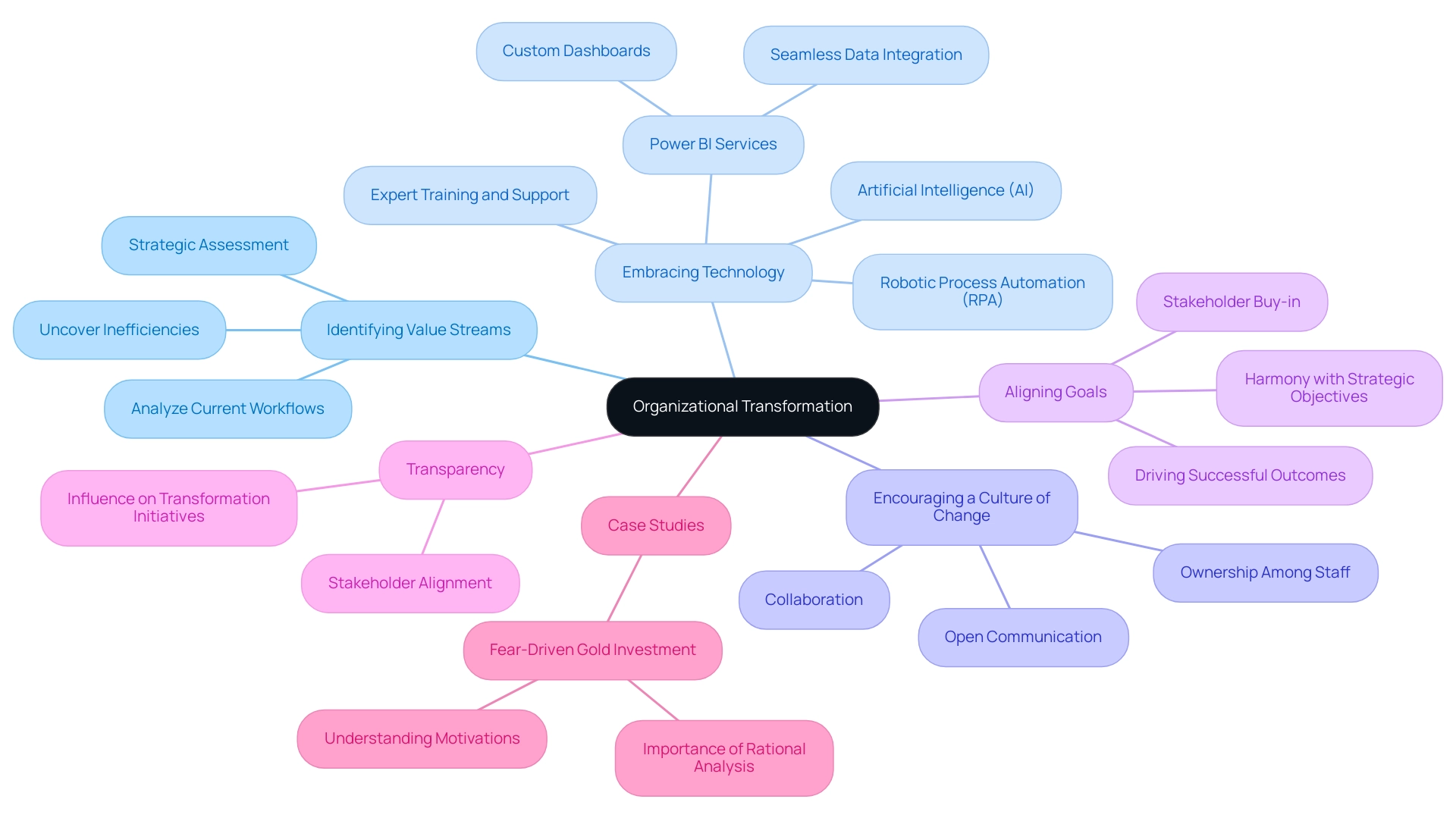
Practical Steps for Leaders: Leading Change with Momentum Mindset
To guide transformation effectively, leaders should implement the following actionable strategies:
- Develop a Clear Vision: Establish a compelling vision for the initiative that aligns with your team’s values and goals. Consistent communication of this vision is essential to maintain clarity and focus throughout the process.
- Engage Stakeholders: Involving key stakeholders from the outset is crucial. Their insights can illuminate potential challenges and foster a sense of ownership, which is essential for the success of transformation initiatives. Gartner’s findings indicate that 80% of staff face ‘cultural tensions’ during transitions, making stakeholder engagement even more critical. Furthermore, with just 43% of staff believing their organization excels at handling transitions, effective involvement becomes even more essential.
- Create a Change Management Plan: A well-structured change management plan should outline the specific steps, resources, and timelines required for implementation. It should also include clear metrics for monitoring progress, ensuring that the entire team is aligned and accountable. This is especially important considering that individuals experiencing change-related stress perform 5% worse than average, highlighting the necessity for a robust plan.
- Leverage RPA Tools: Integrate innovative tools such as EMMA RPA and Microsoft Power Automate to modernize workflows. EMMA RPA addresses task repetition fatigue by automating mundane tasks, while Power Automate enhances operational efficiency through seamless integration with existing Microsoft applications. By automating repetitive tasks, these solutions can significantly enhance operational efficiency and workforce morale, allowing teams to focus on strategic initiatives. Addressing outdated systems through intelligent automation not only simplifies operations but also alleviates the burden of manual tasks.
- Foster a Growth Mindset: Encourage a culture that sees challenges as opportunities for growth. This can be achieved by providing training and support to help employees navigate new processes and technologies. Linking this to the statistic about performance, it’s essential to address change-related stress to improve overall productivity.
- Celebrate Milestones: Acknowledging and celebrating accomplishments throughout the transformation journey can significantly enhance morale and maintain momentum. This practice not only strengthens the positive aspects of transformation but also encourages the team to continue working toward the overarching vision. For instance, the case study titled ‘Improving M&A Success’ from Gartner emphasizes how effective management practices can lead to successful outcomes in mergers and acquisitions.
By adopting these strategies and leveraging RPA, leaders can transform now to create a robust framework for managing transitions effectively, ultimately leading to greater success in their transformation initiatives.
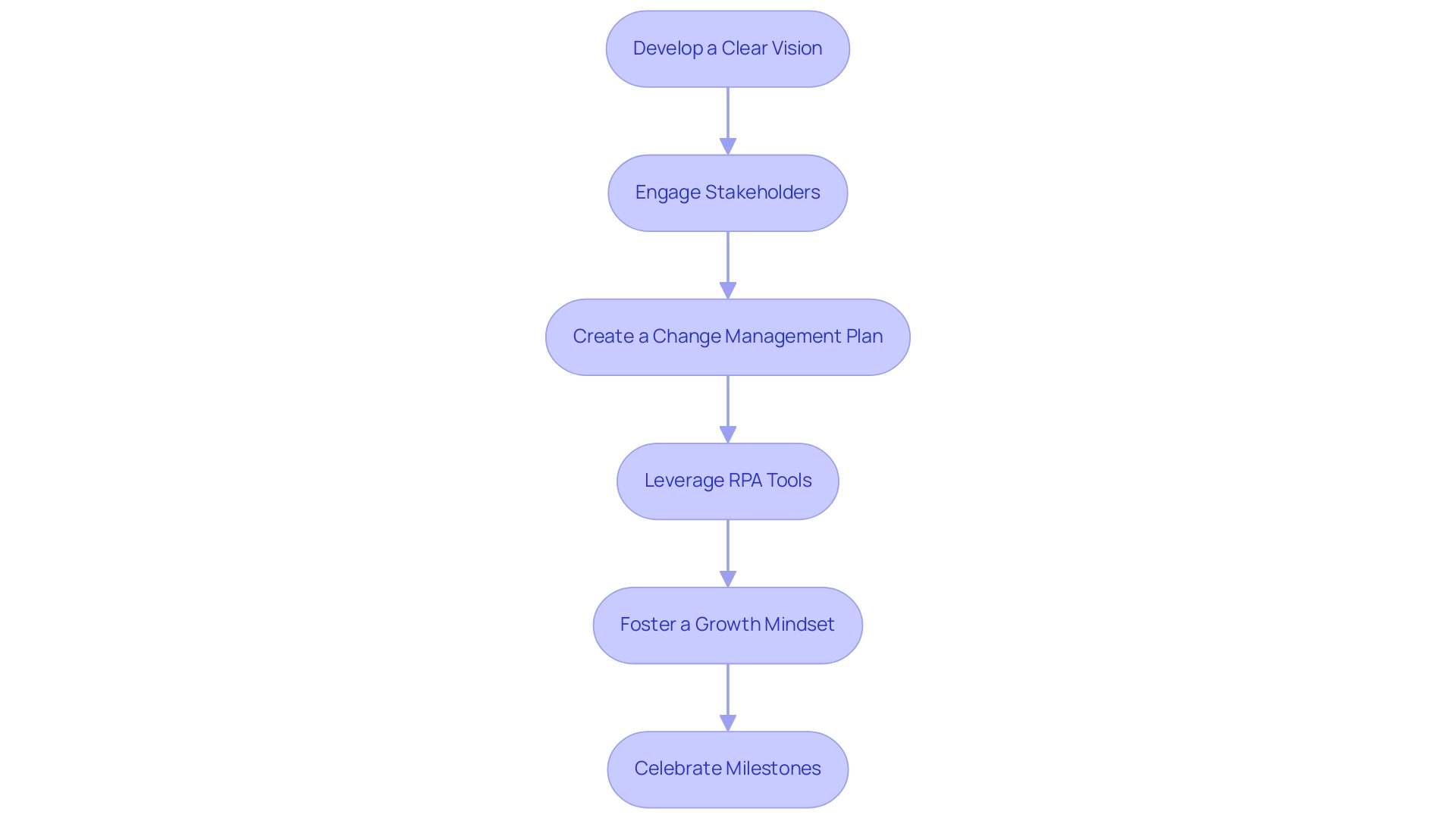
Overcoming Resistance to Change: Strategies for Engagement
To successfully navigate opposition to transformation, leaders can adopt several key strategies:
- Communicate Transparently: Clearly articulate the reasons behind the modification and its anticipated benefits. Just as washing hands for about 15-30 seconds removes more germs than washing for shorter periods, transparent communication fosters trust and significantly diminishes uncertainty among staff, which is crucial during transitions.
- Engage Staff in the Process: Actively involve staff in conversations about the transition. This involvement nurtures a sense of ownership and can yield insightful contributions that can transform now the overall change experience.
- Provide Support and Resources: Facilitate training sessions, workshops, and resources tailored to assist individuals in adapting to new processes. By providing this support, leaders show their dedication to staff success during the transition, which can help to transform now any feelings of resistance.
- Address Concerns Promptly: Create an environment where feedback is welcomed, and promptly address staff’s concerns. Recognizing and validating their feelings can significantly reduce anxiety, cultivating a supportive atmosphere conducive to change.
- Highlight Success Stories: Share examples of successful transformation initiatives—be it from within the organization or the industry at large. Demonstrating the concrete advantages of previous transformations can inspire confidence and encourage staff to transform now in order to adopt the ongoing developments.
Studies show that skepticism regarding organizational adjustments can result in increased resistance, making it crucial for leaders to cultivate trust and involvement proactively. Nguyen et al. (2018) discovered a significant connection between cynicism regarding transformation, work engagement, and job satisfaction among employees, emphasizing the need for trust-building strategies.
Rozita Cheraghi emphasizes that,
Embracing transformation in the core of nursing and health care is considered a challenge.
This sentiment resonates across sectors, underscoring the universal importance of effective transformation management strategies. Moreover, the case study on employee cynicism and opposition to transformation concluded that higher levels of cynicism correlate with increased resistance, suggesting the necessity for leaders to implement strategies that foster trust and engagement.
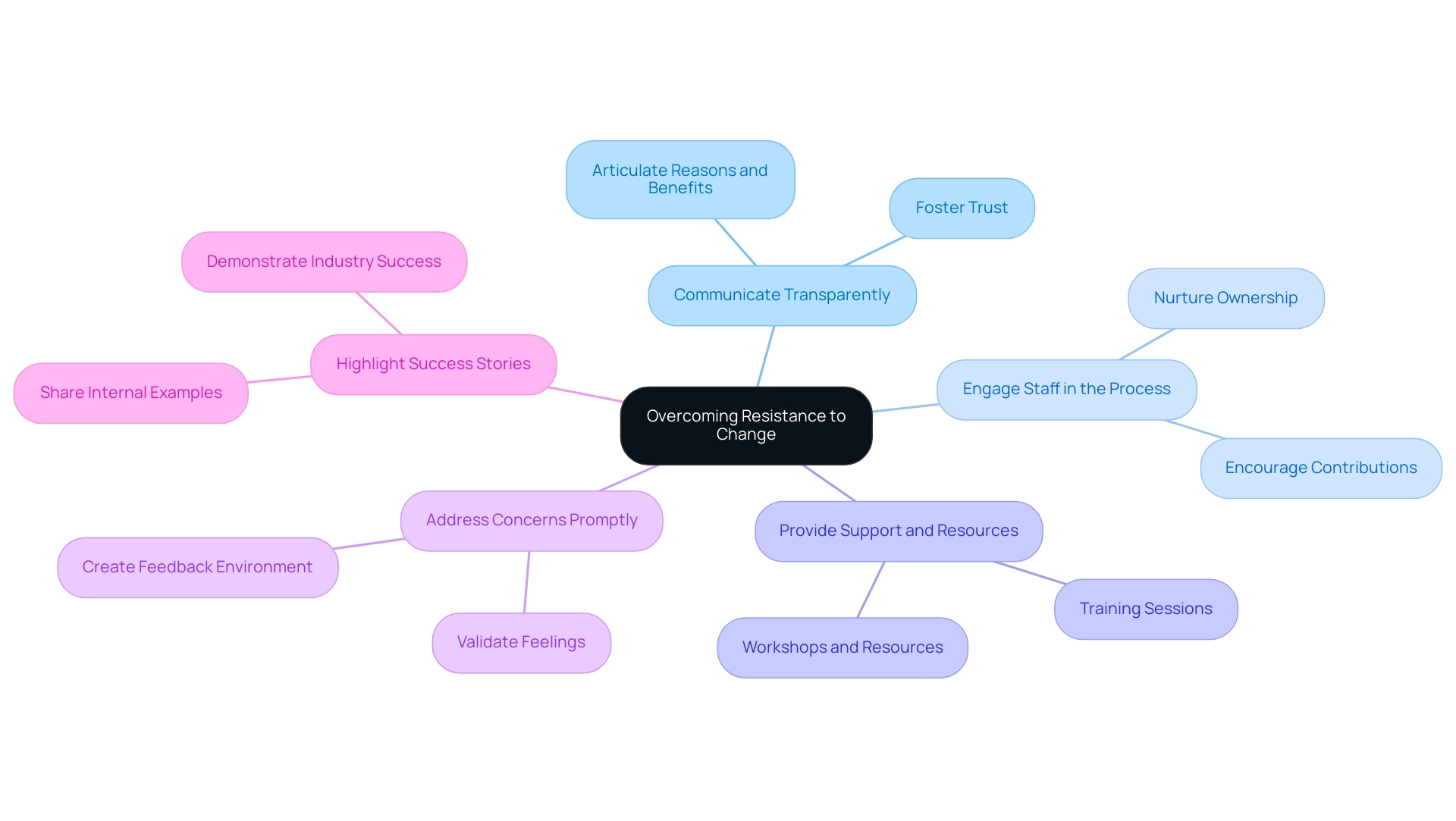
Measuring Success: Key Performance Indicators for Change
To effectively measure the success of transformation initiatives, leaders should focus on tracking several key performance indicators (KPIs) that transform now and provide valuable insights into operational performance. By leveraging Robotic Process Automation (RPA) to transform now and automate manual workflows, companies can enhance these KPIs, driving efficiency and strategic value. Here are some crucial KPIs to consider:
- Employee Engagement Levels: Regularly conduct employee satisfaction surveys and gather feedback to evaluate the response to modifications within the organization. High engagement levels often correlate with successful adoption of new methods, particularly when RPA reduces routine workload fatigue.
- Productivity Metrics: Analyze productivity rates prior to and following the implementation of adjustments to determine their effect on operational efficiency. RPA can significantly enhance workflows, allowing teams to concentrate on higher-value tasks, thus improving productivity.
- Customer Satisfaction Scores: Collect and evaluate customer feedback alongside satisfaction ratings to ascertain whether the changes have enhanced service delivery. Positive customer responses can directly reflect the effectiveness of how we transform now, as automated processes can lead to faster and more accurate service.
- Financial Performance: Monitor financial metrics such as revenue growth and cost savings to evaluate how the transformation contributes to the organization’s bottom line. For instance, calculating Revenue per Client (RPC) can provide a concrete measure of financial performance, with a scenario where $100,000 in revenue with 100 clients results in an RPC of $1,000. Strong financial performance is often a key indicator of how businesses can transform now, especially when RPA reduces operational costs.
- Time to Implement Changes: Monitor the duration of the implementation and compare it against initial timelines. RPA can simplify this procedure, providing insights into project management efficiency and boosting the entity’s adaptability to change.
Additionally, the integration of Business Intelligence plays a crucial role in this process. By utilizing BI tools, organizations can analyze the data generated from RPA implementations to gain deeper insights into operational performance and make informed decisions.
As Andrew Horlick, a Prosci Senior Principal, noted, “During the early stage of your change, be sure to present a case for the resources you will need to measure progress over time.” By linking effective adoption and usage to project results, leaders can ensure that they are on the right track toward achieving their operational goals. For example, the IT Metrics case study illustrates how these KPIs were applied in practice, demonstrating their relevance to the role of the Director of Operations Efficiency and the impact of RPA on organizational success.
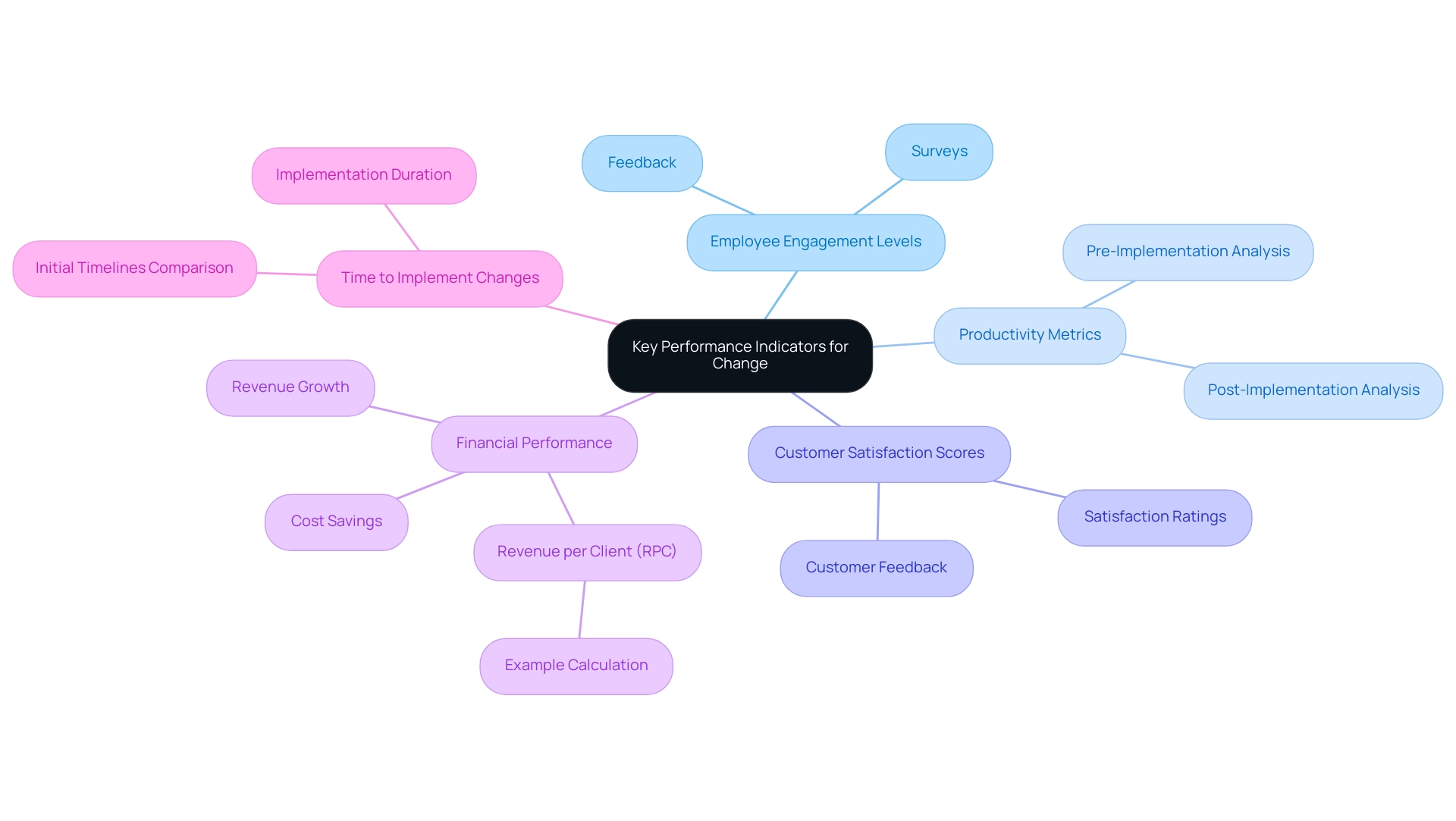
Sustaining Change: Building a Continuous Improvement Culture
To cultivate a culture of continuous improvement, leaders should adopt the following strategies:
- Encourage Innovation: Establish a workplace where individuals are empowered to share ideas and experiment without fear of failure. Celebrating and rewarding innovative contributions fosters an environment ripe for creative solutions.
For example, groups that have adopted feedback loops frequently observe heightened innovation as staff members feel their contributions are appreciated.
-
Regular Training and Development: Commitment to ongoing training is essential, particularly as businesses navigate the rapidly evolving AI landscape. By providing continuous development opportunities, including insights into Robotic Process Automation (RPA) and tailored AI solutions, companies can transform now their employees into individuals equipped with the necessary skills and knowledge to thrive in a changing environment.
-
Feedback Loops: Implementing regular feedback mechanisms is crucial for gathering insights on existing processes and initiatives. This practice not only identifies opportunities for improvement but also acknowledges and reinforces successful efforts. The case study ‘Inspiring Accountability in the Workplace‘ illustrates how companies can utilize feedback loops to enhance accountability and encourage self-reflection among employees.
-
Leadership Commitment: As Simon Sinek aptly states,
Leadership is not about being in charge. It is about taking care of those in your charge.
Leaders must embody the principles of continuous improvement, demonstrating their dedication to the group’s objectives through consistent actions and support.
By fostering personal accountability and utilizing RPA to streamline workflows, leaders can enhance team performance, reduce operational costs, and drive successful automation strategies.
- Integrate Improvement into Daily Operations: Continuous improvement should be woven into the fabric of daily operations. Encourage teams to consistently identify and implement small adjustments, including leveraging Business Intelligence to transform now data into actionable insights, making it a regular part of their workflow.
This approach not only sustains change but also aligns with the organization’s goals of leveraging technology for better efficiency.
By fostering personal accountability alongside these practices, organizations can create a culture of integrity and trust, ultimately enhancing overall productivity and team performance, which is essential in navigating the challenges of digital transformation. Embracing RPA and tailored AI solutions is crucial for overcoming these challenges and achieving sustained success in an increasingly competitive landscape.
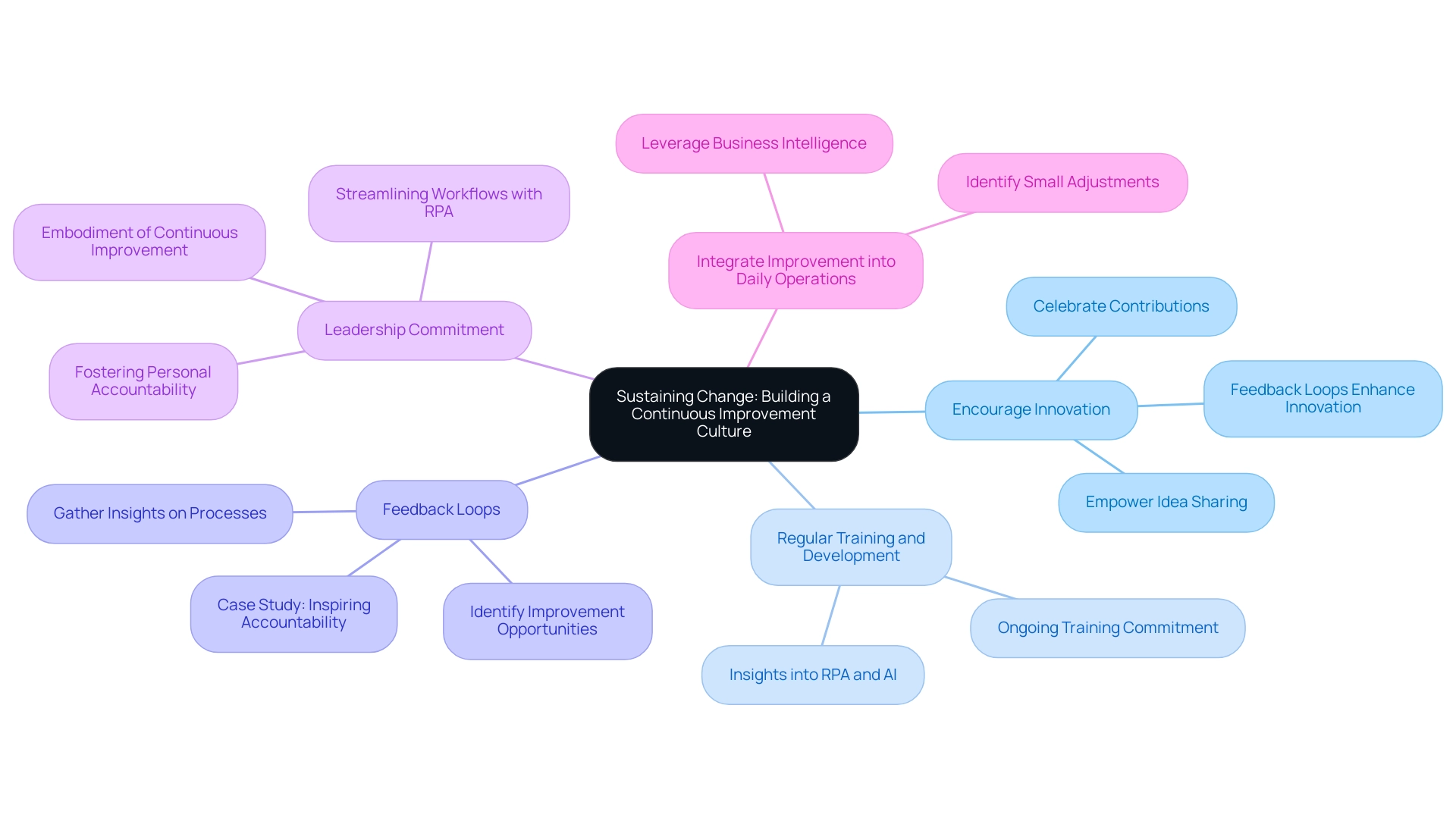
Conclusion
Organizational transformation is an essential journey that goes beyond mere adjustments; it is about fundamentally redefining how value is created and opportunities are seized. By identifying key areas for improvement, embracing advanced technologies, and fostering a culture that welcomes change, leaders can navigate the complexities of transformation and drive their organizations toward sustained success.
Engaging stakeholders and developing a clear vision are critical components of leading change effectively. Transparency in communication and involving employees in the process can significantly reduce resistance and enhance buy-in. Additionally, leveraging innovative tools like Robotic Process Automation can streamline workflows and boost operational efficiency, allowing teams to focus on strategic initiatives rather than mundane tasks.
Measuring success through defined key performance indicators ensures that organizations can track their progress and make informed decisions. By continuously nurturing a culture of improvement and innovation, leaders can empower their teams to adapt and thrive in an ever-evolving landscape. With commitment and the right strategies in place, organizations can not only survive change but emerge stronger and more resilient, ready to seize the opportunities that lie ahead.
Introduction
In the fast-paced world of automation, the Process Definition Document (PDD) emerges as a vital tool that can transform organizational efficiency. By serving as a comprehensive blueprint for automation projects, the PDD addresses common workplace challenges such as repetitive tasks and system inefficiencies, ensuring that automation aligns seamlessly with business goals. This article delves into the significance of PDDs, particularly in the context of Robotic Process Automation (RPA), exploring best practices for their creation, the challenges organizations face during implementation, and the tangible benefits they can unlock. As companies navigate the complexities of automating processes, understanding the role of a well-crafted PDD becomes essential for fostering a productive and innovative work environment.
Defining the Process Definition Document: A Key Component in Automation
A process definition document (PDD) is a detailed plan that outlines the workflows to be streamlined within an organization, serving as an essential reference for stakeholders involved in related initiatives. By addressing common workplace challenges such as repetitive tasks, staffing shortages, and outdated systems, the process definition document (PDD) ensures that automation initiatives align with business goals. The process definition document outlines each stage of the procedure, the roles of involved parties, and the expected outcomes, thereby enhancing operational efficiency and productivity.
Crucial elements of a process definition document include:
- Flow charts
- Input and output requirements
- Performance metrics
In the context of Robotic Process Automation (RPA), particularly with innovative tools like EMMA RPA—featuring seamless digitalization and user-friendly interfaces—and Microsoft Power Automate, which allows for streamlined workflows and AI-driven capabilities, the process definition document serves as a foundational tool that guides the development and deployment of automated solutions. This approach not only transforms business operations but also fosters a more productive work environment.
Additionally, the process definition document serves as a user guide that assists teams in navigating the implementation journey, ensuring that the system effectively addresses the identified challenges.
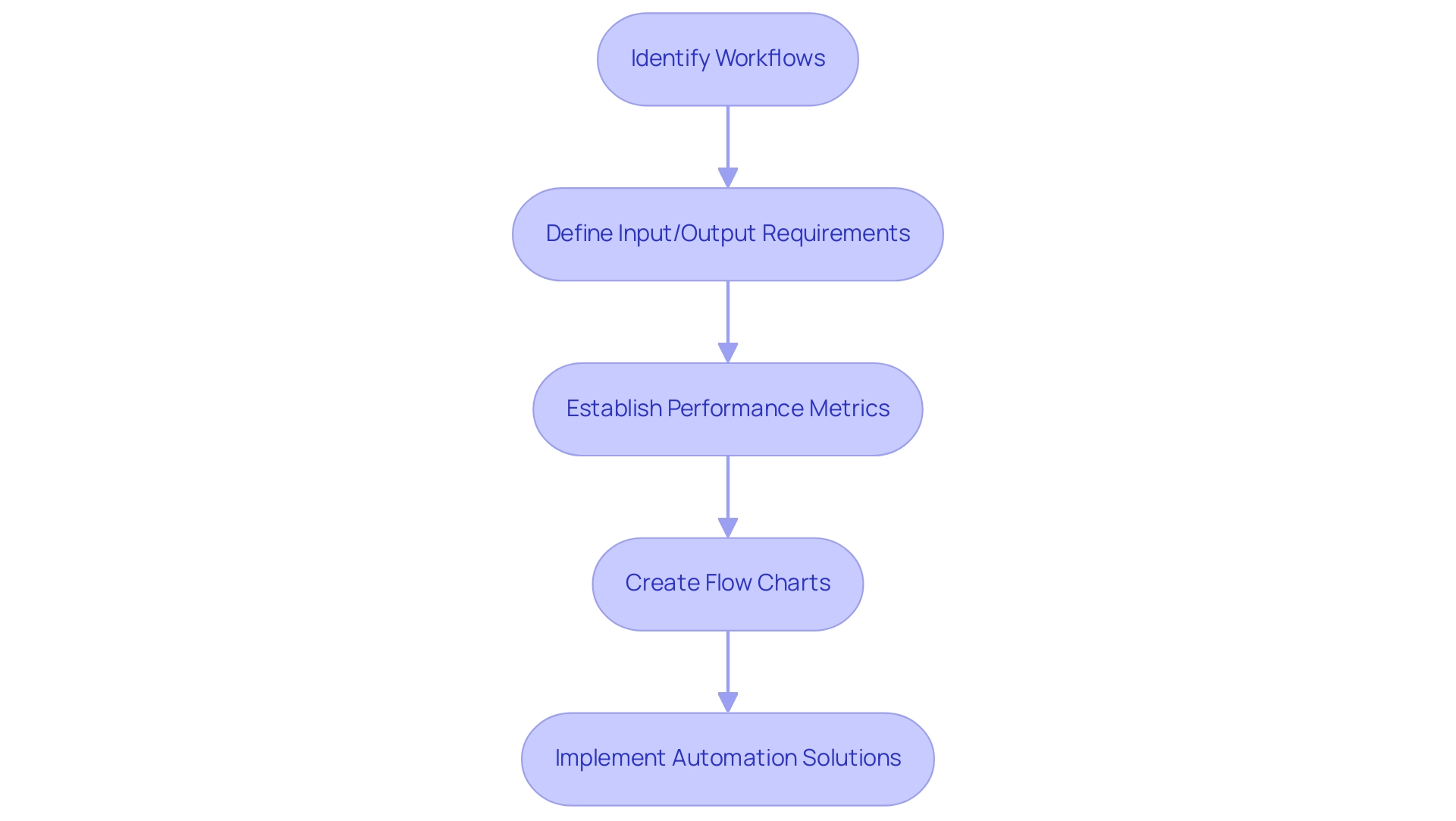
The Role of PDDs in Enhancing Robotic Process Automation
In the context of Robotic Process Automation (RPA), the process definition document (PDD) is essential for enhancing the effectiveness and efficiency of process initiatives. The mid-sized company faced significant challenges, including:
- Manual data entry errors
- Slow software testing
- Difficulties integrating outdated systems without APIs
By offering a comprehensive account of the tasks to be automated, Odds assist in pinpointing regions where mechanization can produce the most significant advantages, such as decreasing manual mistakes and enhancing efficiency.
They serve as a vital communication tool among stakeholders, ensuring that everyone involved, from technical teams to operational managers, has a clear understanding of the process definition document, including its requirements and expectations. A project manager noted, ‘The PDD was crucial in aligning our team and ensuring we addressed potential risks early on.’ Furthermore, a process definition document (PDD) aids in recognizing potential risks and challenges linked to automated processes, enabling organizations to proactively tackle these issues prior to implementation.
This approach has proven essential for mid-sized companies, particularly in healthcare, where operational efficiency is critical. By establishing a solid foundation for RPA projects, the process definition document (PDD) contributes significantly to the successful deployment of automated solutions, ultimately leading to increased operational efficiency and productivity in a rapidly evolving AI landscape. The company achieved a remarkable ROI within six months, demonstrating the tangible benefits of implementing a structured method to streamline processes.
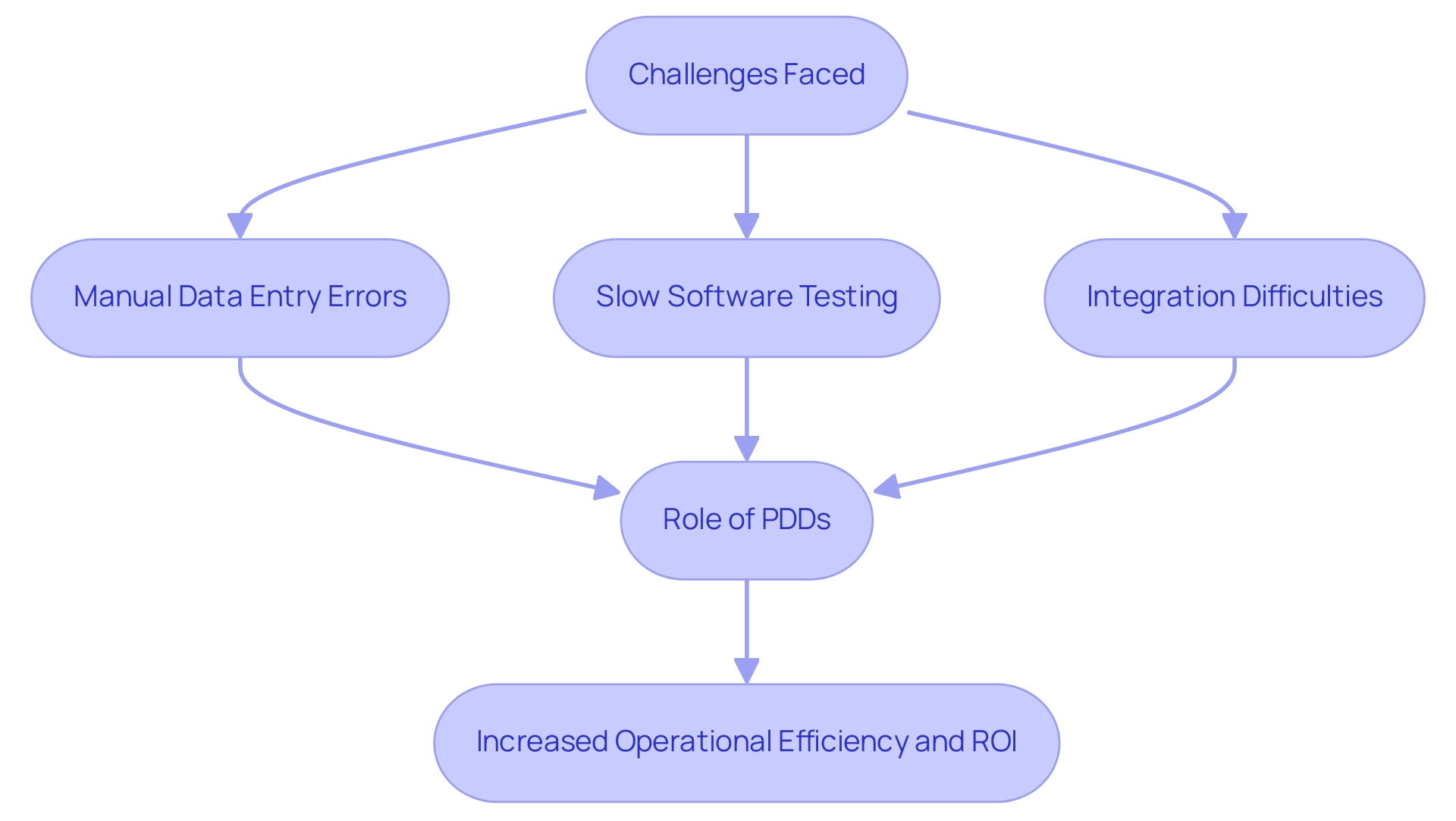
Best Practices for Creating an Effective Process Definition Document
Creating an effective process definition document is a crucial step in streamlining operations and enhancing automation efforts through Robotic Process Automation (RPA). To achieve this, actively engaging all relevant stakeholders throughout the documentation stage is essential. As Bolman and Deal indicate, ‘goals and decisions arise from bargaining, negotiation, and jockeying for position among various stakeholders,’ highlighting the necessity to involve diverse viewpoints to encourage thorough input and ensure support from those affected by the activities.
In this rapidly evolving AI landscape, stakeholder conferences, such as those held to identify preferred service outcomes, play a vital role in ensuring representation of various interests in the process definition document creation. Clarity and precision in language are critical; the process definition document should be articulated in straightforward terms, avoiding jargon that might alienate or confuse readers. To facilitate understanding and communication, incorporating visual aids like flowcharts can be immensely beneficial. Moreover, the process definition document (PDD) should not remain static; it requires regular reviews and updates to capture any shifts in processes or business objectives.
This adaptability is essential for maintaining relevance in a dynamic environment fueled by data-driven insights. Insights from the case study titled ‘Building Positive Resilience Through Vulnerability Analysis‘ illustrate how understanding power dynamics and stakeholder relationships can enhance the effectiveness of Odds. Additionally, by leveraging RPA, companies can significantly reduce costs and enhance productivity by streamlining workflows and minimizing errors. Finally, incorporating performance metrics within the process definition document allows entities to efficiently assess the effectiveness of automated initiatives, enabling data-informed modifications as required.
By following these best practices and tackling the challenges of recognizing customized AI solutions, entities can develop Odds that act as clear guidelines for automation while empowering stakeholders to engage meaningfully in the effort, ultimately improving business productivity and operational efficiency.
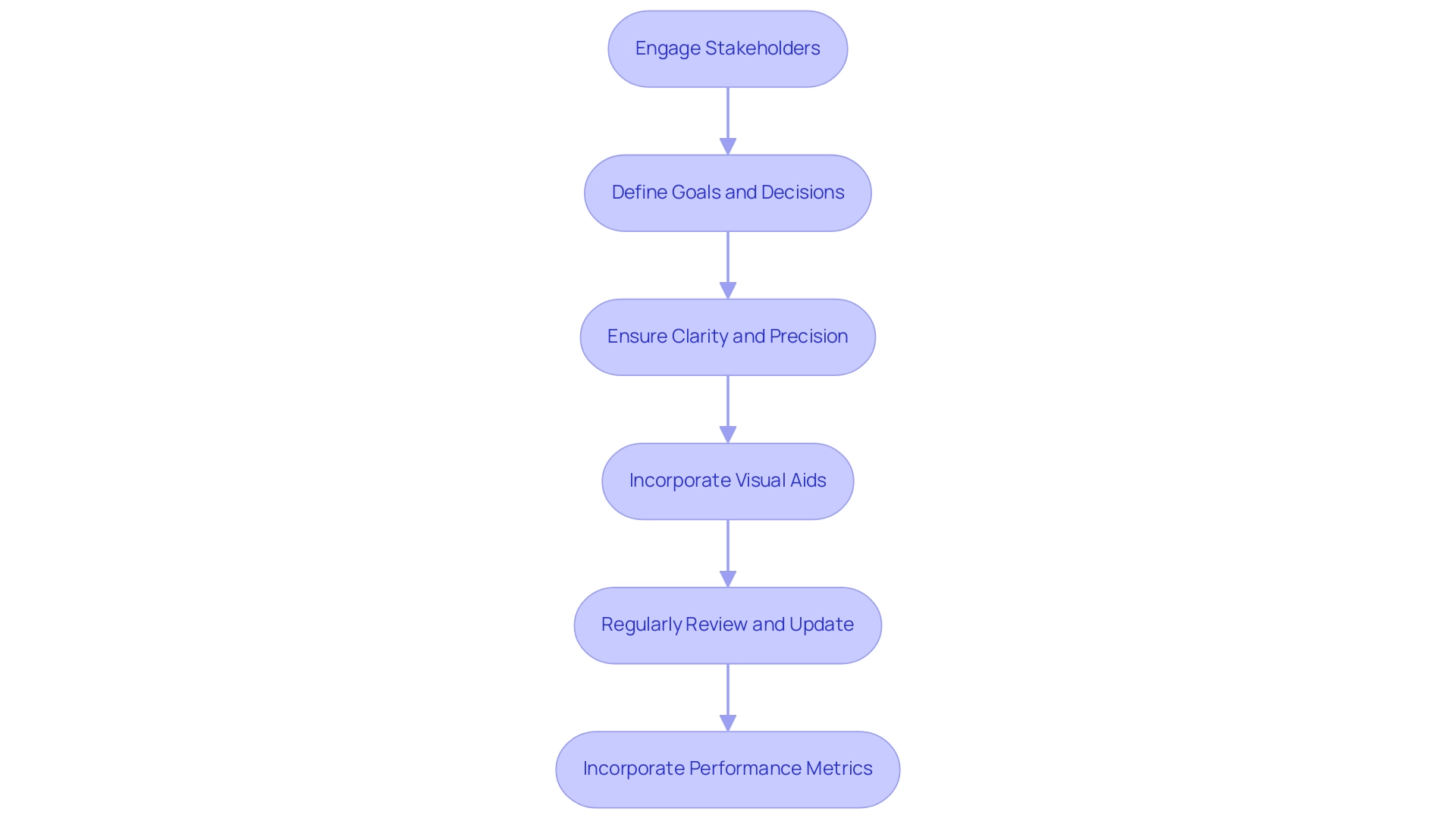
Challenges in Implementing Process Definition Documents
Despite their significance, implementing a process definition document can pose various challenges. One common issue is employee resistance to change, as individuals may be accustomed to existing methods and reluctant to embrace new documentation practices. To combat this, entities should cultivate a culture of collaboration and communication, clearly articulating the advantages of PDs in streamlining workflows and enhancing operational efficiency through solutions like Robotic Process Automation (RPA).
Tailored AI solutions can also play a crucial role in easing this transition by providing targeted tools that align with specific business needs. Another challenge lies in ensuring the accuracy and completeness of information captured in the document. It is crucial for entities to implement a thorough review system to verify the content of the PDD prior to finalization.
Additionally, maintaining the relevance of the PDD over time can be complex, particularly in dynamic environments where processes evolve rapidly. Organizations should implement a regular review schedule to keep the PDD updated, thus leveraging business intelligence to transform raw data into actionable insights. By proactively recognizing and addressing these challenges, entities can significantly enhance the effectiveness of their process definition documents and ensure alignment with tailored AI solutions that drive growth and innovation.
Furthermore, navigating the rapidly evolving AI landscape requires organizations to stay informed about emerging technologies and best practices, ensuring they select the most suitable solutions for their operational needs.
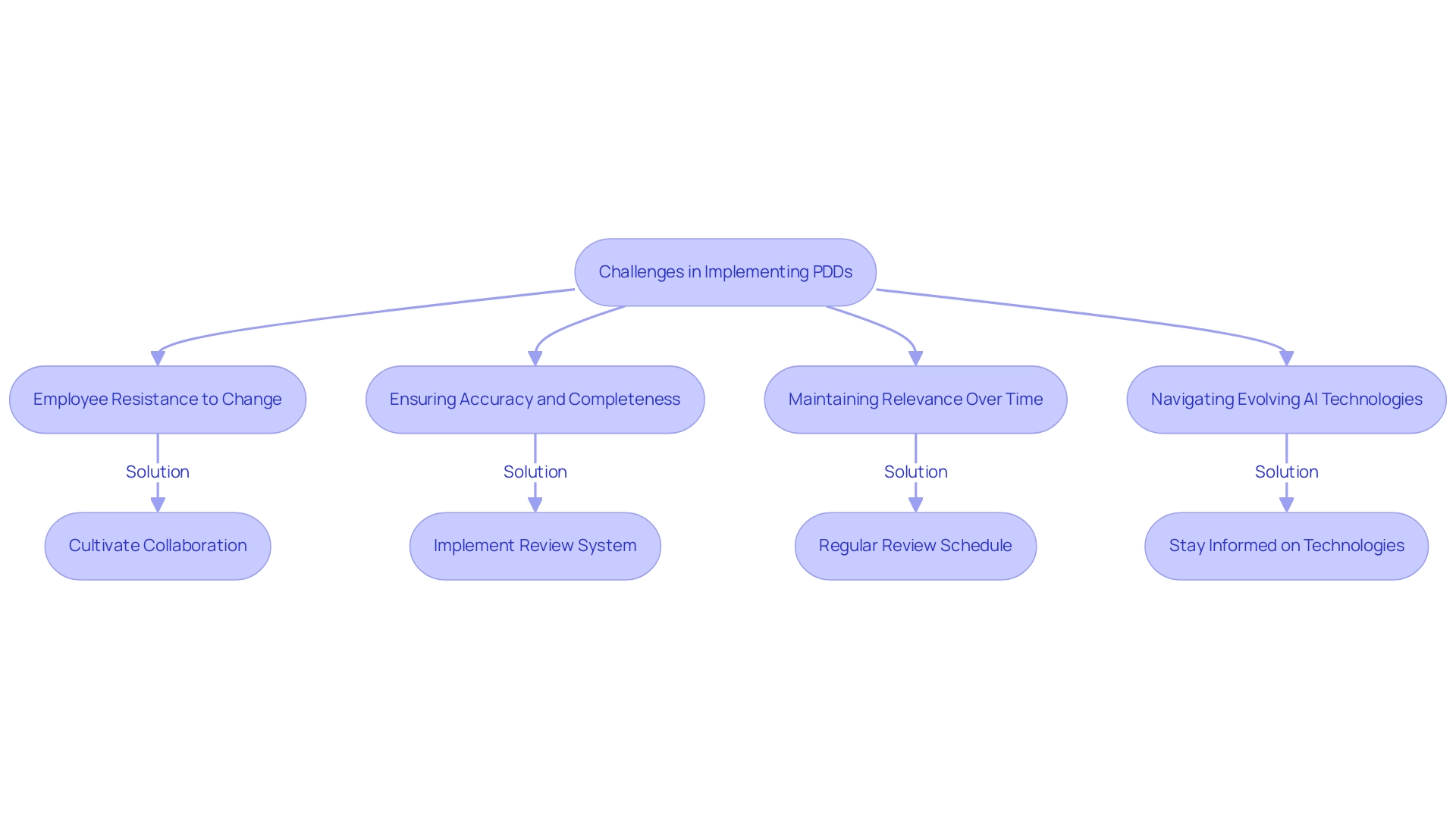
Conclusion
The Process Definition Document (PDD) is an indispensable asset in the journey toward automation, particularly in the realm of Robotic Process Automation (RPA). By providing a structured approach to defining processes, PDDs not only clarify roles and expectations but also serve as a vital communication tool that aligns stakeholders around common goals. This comprehensive blueprint addresses workplace challenges, enhances operational efficiency, and ultimately fosters a more productive work environment.
Creating an effective PDD requires active engagement from all relevant stakeholders, ensuring that diverse perspectives shape the document. Best practices emphasize:
- Clarity
- Regular updates
- Integration of performance metrics
These practices allow organizations to adapt to the dynamic nature of their operations. By leveraging these strategies, businesses can significantly reduce errors, streamline workflows, and achieve substantial returns on investment.
However, the implementation of PDDs is not without its challenges. Overcoming employee resistance, ensuring accuracy, and maintaining relevance are critical hurdles that organizations must address. By fostering a culture of collaboration, establishing thorough review processes, and staying informed about technological advancements, companies can enhance the effectiveness of their PDDs. In doing so, they not only drive operational efficiency but also position themselves for sustained growth and innovation in an increasingly automated future.
Introduction
Navigating the complexities of the insurance industry can be a daunting task, particularly when it comes to managing claims efficiently. As organizations strive to enhance their operational processes, insurance claim automation emerges as a transformative solution. By harnessing advanced technologies such as Robotic Process Automation (RPA) and artificial intelligence, companies can streamline their claims processes, reducing processing time and minimizing errors.
However, the journey toward automation is not without its challenges, including employee resistance and the need for robust data management. This article delves into the multifaceted world of insurance claim automation, exploring its benefits, challenges, and the technological foundations that support this evolution.
By understanding these dynamics, organizations can position themselves for success in an increasingly competitive landscape, ensuring they not only meet but exceed customer expectations.
Understanding Insurance Claim Automation: An Overview
Insurance claim automation pertains to the use of technology to simplify and oversee the submissions in the insurance sector. This entails utilizing software and systems that automatically manage various tasks, such as information entry, assessment of requests, and interaction with policyholders. By automating these procedures with insurance claim automation through innovative solutions such as Robotic Process Automation (RPA) and Small Language Models (SLMs), insurance firms can significantly decrease the time and effort needed to handle requests, resulting in quicker resolutions and enhanced customer service.
However, many organizations hesitate to adopt AI due to perceived costs and complexities, as well as challenges related to poor master information quality. Addressing these issues is essential for successful implementation. For instance, Microsoft Power Automate can enhance efficiency and accuracy while creating a risk-free ROI assessment.
Additionally, tools like EMMA RPA specifically address task repetition fatigue and staffing shortages, further transforming operations for better productivity and employee morale. Real-world examples of companies that have successfully implemented SLMs and RPA solutions can provide valuable insights into the tangible benefits of these technologies.

Key Benefits of Automating Insurance Claims
The mechanization of insurance claim automation is transforming operational methods, yielding significant advantages such as increased efficiency, enhanced accuracy, and improved customer satisfaction. A compelling example is a mid-sized company that enhanced efficiency by mechanizing information input, software testing, and legacy system integration using GUI mechanization. This transformation addressed challenges such as manual data entry errors and slow software testing, achieving a remarkable 70% reduction in data entry errors and a 50% acceleration in testing processes.
Furthermore, the implementation of GUI features enabled the seamless integration of outdated systems, which had previously posed significant hurdles. Significantly, the company achieved a return on investment (ROI) within only 6 months, highlighting the financial benefits of the automated solution. In the same way, a UK-based non-profit organization collaborated with FirstSource to eradicate a remarkable 30-month backlog of requests, demonstrating how mechanization can fundamentally alter operational timelines.
By streamlining repetitive tasks, insurance claim automation allows insurance companies to drastically reduce the average time taken to settle requests, thereby accelerating cash flow for policyholders and minimizing human errors associated with manual processing. Moreover, mechanization improves information handling and analytical abilities, enabling insurers to obtain insights into trends in requests and customer behavior. This strategic approach enables companies to refine their service offerings and cultivate stronger relationships with clients, ultimately leading to higher retention rates and enhanced customer loyalty.
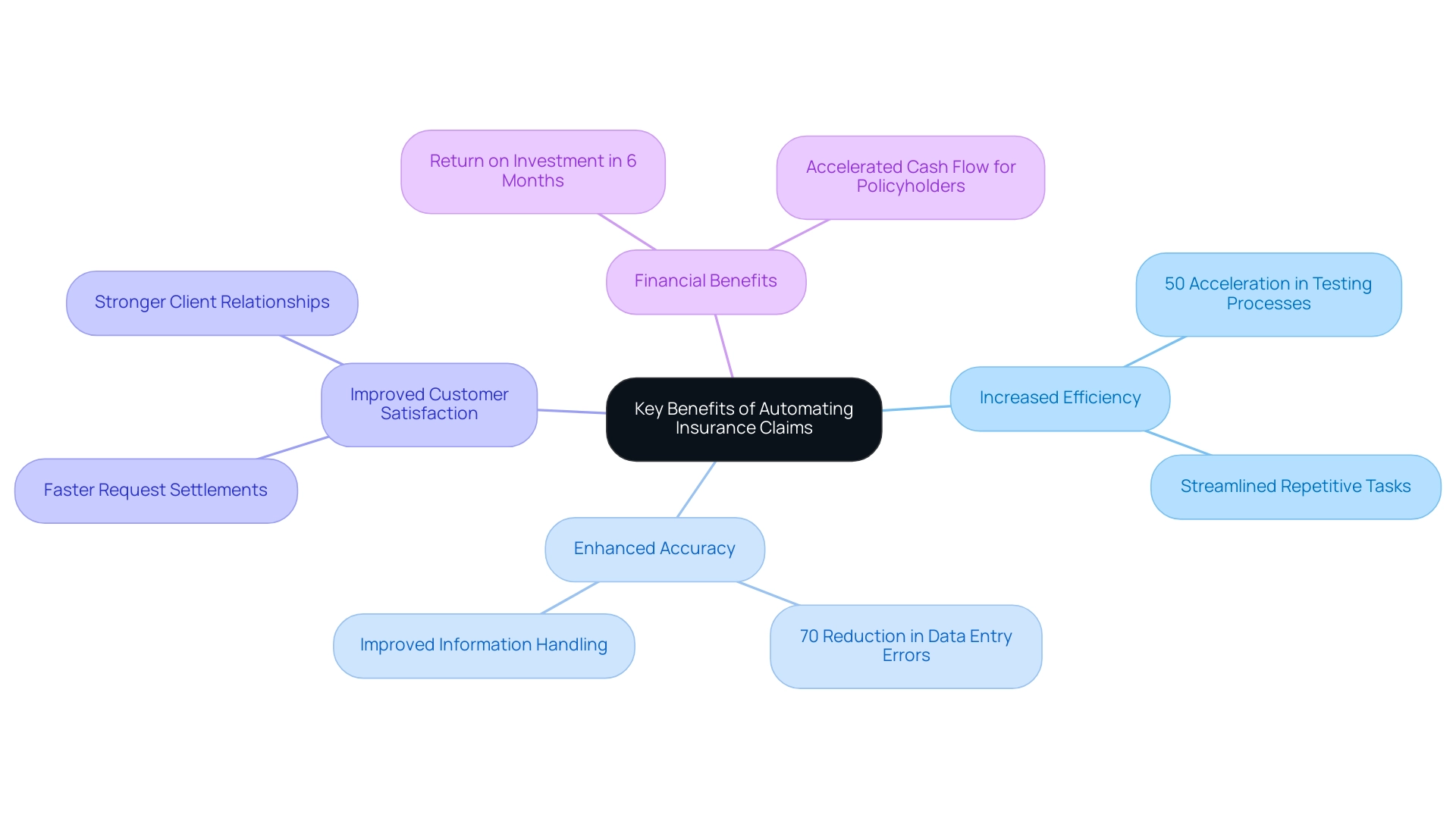
Challenges in Implementing Insurance Claim Automation
Implementing insurance claim automation comes with several challenges that organizations must navigate. Resistance from employees fearing job displacement is common, highlighting the need for effective change management strategies. Additionally, integrating new technologies with existing systems can be complex and may require significant investment in training and resources.
It is essential to leverage tailored AI solutions and engage in hands-on training through GenAI workshops to equip your team with the necessary skills. Moreover, data privacy and security continue to be essential issues, as safeguarding sensitive customer information during automated procedures is vital. To overcome these challenges, organizations should:
1. Involve stakeholders early in the transition process
2. Provide adequate training
3. Ensure compliance with regulatory requirements
By proactively addressing these issues and utilizing Robotic Process Automation (RPA) to enhance operational efficiency and drive productivity, companies can facilitate a smoother transition to insurance claim automation. RPA not only streamlines workflows but also contributes to increased productivity and lower operational costs. Furthermore, incorporating Business Intelligence can assist in informed decision-making, while ethical AI usage guarantees that the implementation of technology aligns with privacy regulations and ethical standards.
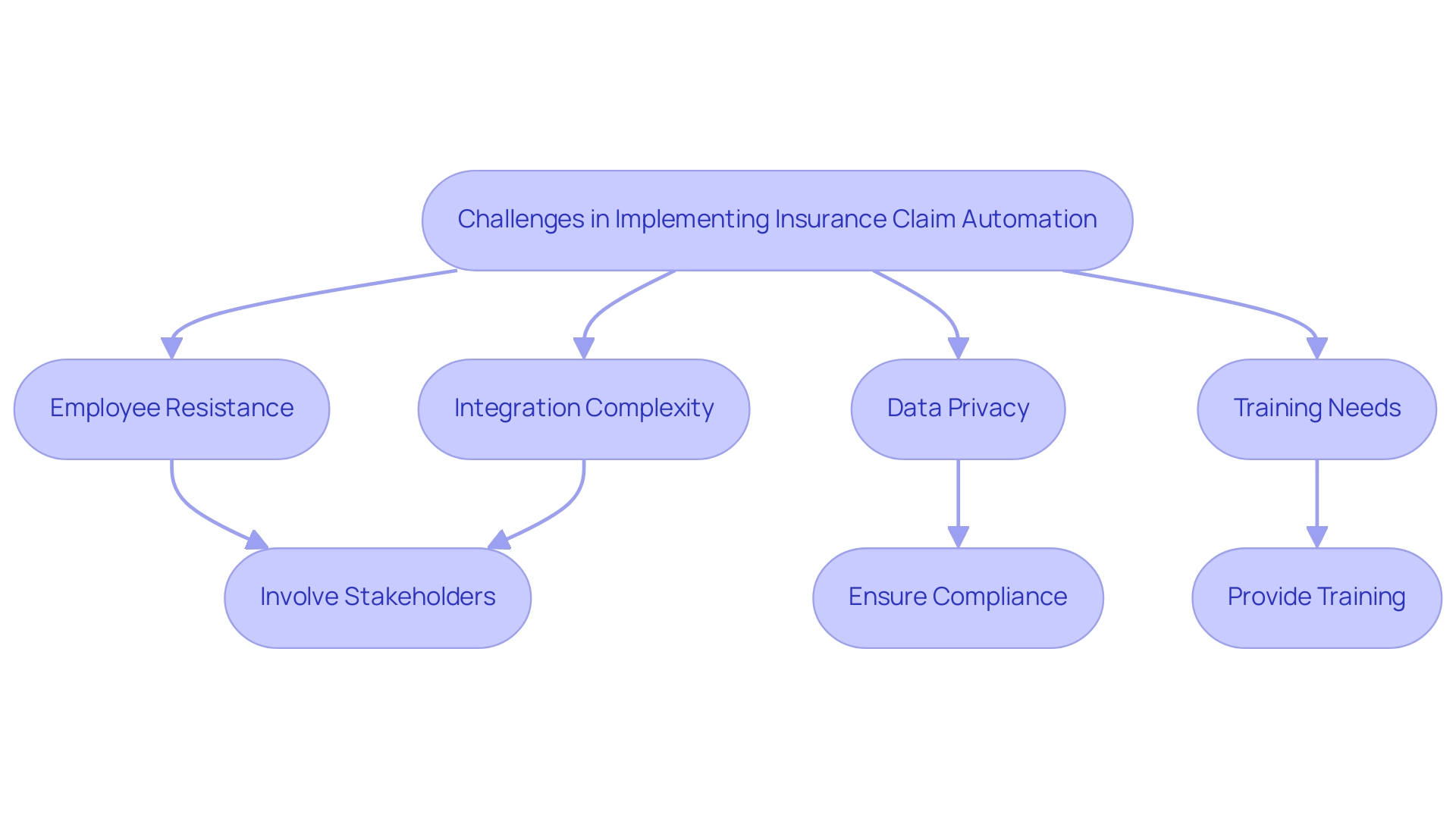
Technological Foundations of Insurance Claim Automation
The foundation of insurance automation is established by advanced technologies such as artificial intelligence (AI), machine learning, and robotic automation (RPA). AI algorithms excel at analyzing claims information, identifying patterns and anomalies that are vital for fraud detection and risk assessment. Machine learning further refines this process, enhancing the accuracy of predictions by learning from past information.
Meanwhile, RPA, especially via innovative tools like EMMA RPA and Microsoft Power Automate, streamlines operations by automating repetitive tasks such as information entry and document processing. This allows human resources to concentrate on more complex decision-making, significantly boosting operational efficiency and accuracy while also improving employee morale by reducing the burden of mundane tasks. This trio of technologies creates a robust framework for insurance claim automation.
Business Intelligence plays a critical role in this framework, transforming raw information into actionable insights that drive informed decision-making. Given the rapid advancements in AI—growing at an almost exponential rate—it is imperative for industry leaders to stay informed about these developments. As emphasized by James Barrat, numerous top AI experts hold contingency plans because of worries regarding these rapid technological shifts, demonstrating the vital necessity for ethical oversight in technology.
This underscores the importance of leveraging tailored AI solutions and business intelligence to improve data quality and enhance decision-making within the insurance sector. Explore how our RPA solutions can transform your operations and elevate your team’s performance.
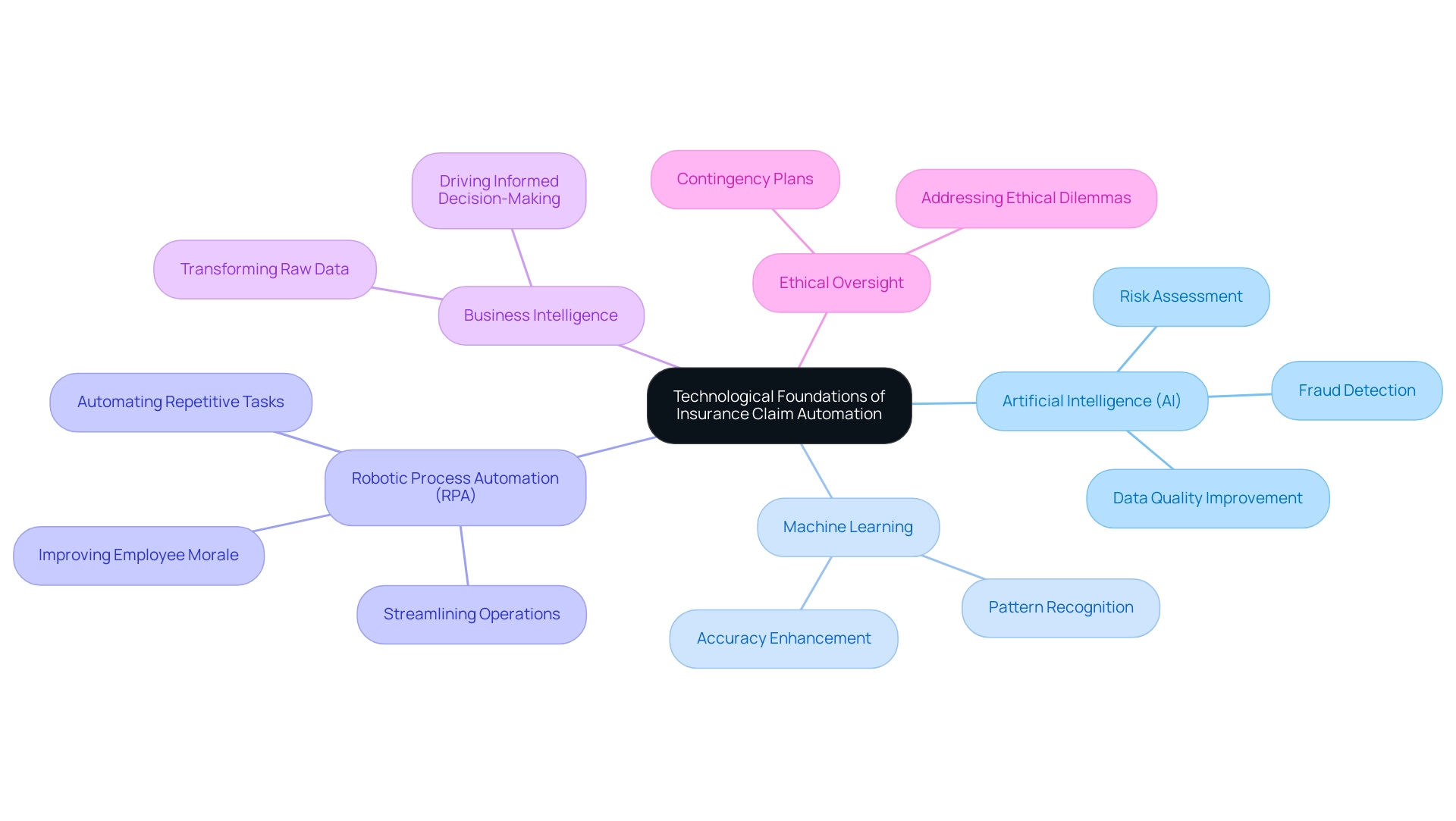
Future Trends in Insurance Claim Automation
The future of insurance claim automation is poised for remarkable progress, propelled by emerging technologies and evolving consumer expectations. A key development is the integration of Robotic Process Automation (RPA) and tailored AI solutions, which enhance predictive analytics and enable more personalized customer experiences. Numerous organizations encounter difficulties with manual, repetitive tasks that can hinder the workflow, resulting in inefficiencies and mistakes.
By implementing RPA, these organizations can enhance operational efficiency through insurance claim automation, allowing them to automate routine tasks. Furthermore, the adoption of digital platforms and mobile applications will simplify the submission of requests through insurance claim automation, enabling policyholders to send their requests and monitor their status in real time. To meet the challenges posed by changing regulatory environments, automation must adapt to ensure compliance while maintaining operational efficiency.
For example, insurance claim automation can be implemented through automated workflows that automatically check for compliance with regulations at each step of the claims process. Organizations that proactively leverage RPA and Business Intelligence will be better positioned to drive data-driven insights and enhance their operational capabilities, meeting the demands of a rapidly evolving market.
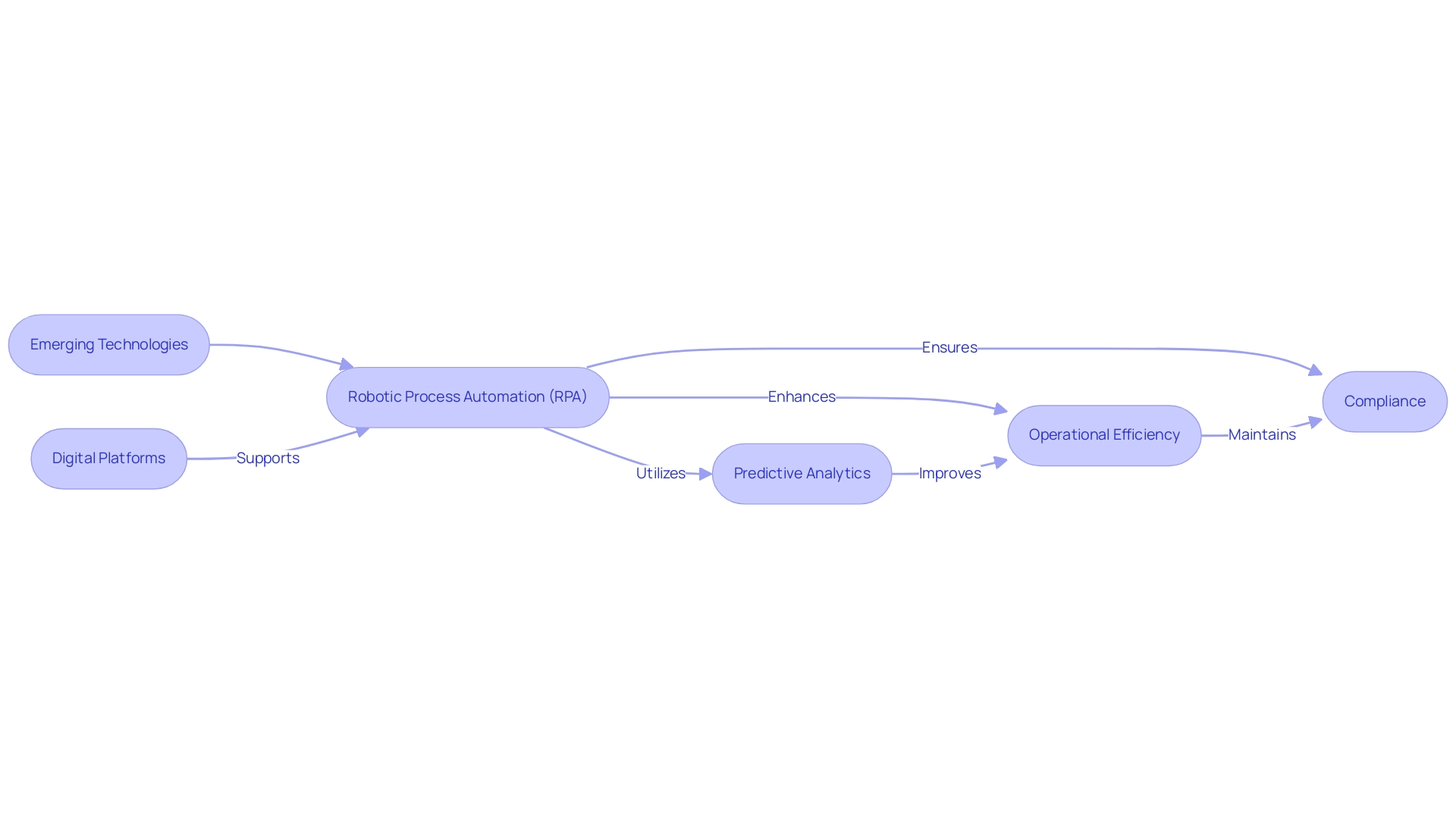
Conclusion
Embracing insurance claim automation represents a pivotal shift in enhancing operational efficiency within the insurance industry. By leveraging advanced technologies such as Robotic Process Automation (RPA) and artificial intelligence, organizations can streamline their claims processes, resulting in faster resolutions and improved customer satisfaction. The significant benefits, including:
- Reduced processing times
- Enhanced accuracy
- The ability to manage data more effectively
underscore the transformative potential of automation.
However, the path to successful implementation is not without its challenges. Addressing:
- Employee resistance
- Ensuring robust data management
- Integrating new technologies with existing systems
are crucial steps that organizations must navigate. By focusing on effective change management and providing adequate training, companies can facilitate a smoother transition, ultimately leading to a more productive and engaged workforce.
Looking ahead, the future of insurance claim automation is bright, with emerging technologies poised to drive further innovations and improvements. As organizations adapt to evolving consumer expectations and regulatory requirements, the integration of digital platforms and advanced analytics will enhance the claims experience for policyholders. By proactively investing in automation solutions, insurance companies can not only meet but exceed customer expectations, positioning themselves for success in an increasingly competitive market.
Introduction
In the rapidly evolving world of finance, Digital Exchange Centers are emerging as transformative platforms that redefine how digital assets are traded and managed. By integrating advanced technologies such as blockchain, artificial intelligence, and Robotic Process Automation, these centers not only enhance security and efficiency but also democratize access to financial markets.
As organizations navigate this new landscape, the importance of operational agility and data-driven insights becomes paramount. With the market for stablecoins reaching unprecedented heights and the rise of decentralized finance, businesses must adapt to stay competitive.
The article explores the pivotal role of Digital Exchange Centers in reshaping financial transactions, the technological innovations driving their success, regulatory challenges, and what the future holds for this dynamic sector.
Embracing these changes can empower organizations to thrive in an increasingly digital economy.
Defining the Digital Exchange Center: A New Era in Finance
A digital exchange center functions as a cutting-edge platform that revolutionizes the exchange of digital assets, including cryptocurrencies, tokens, and other financial instruments. This innovative approach marks a pivotal shift from traditional exchanges towards decentralized, technology-enabled environments like a digital exchange center. Notably, stablecoins have hit a record market cap of $190 billion, underscoring the growth and relevance of digital assets in the current market.
By harnessing advanced technologies such as blockchain, artificial intelligence, and Robotic Process Automation (RPA), the digital exchange center significantly enhances security, transparency, and efficiency in transaction processes. RPA specifically reduces errors and frees up teams for more strategic, value-adding work, fostering a more agile business environment. As David Marino-Nachison noted, ‘Bitcoin trades near $66,000 as crypto stocks rise,’ reflecting the dynamic nature of the cryptocurrency market.
The streamlined transaction workflows at the digital exchange center, enhanced by RPA, create an environment where users—from individual investors to large financial institutions—can engage in trading activities with greater confidence and reduced friction. Furthermore, the case study titled ‘Why Blockbuster Games Will Soon Be Built on Modular Appchains’ emphasizes the need for horizontally scalable blockchain solutions, indicating the evolving landscape and its implications for digital asset exchanges. As organizations strive to enhance operational efficiency through tailored AI solutions and Business Intelligence, which transform raw data into actionable insights, embracing the concept of Digital Collaboration Centers becomes crucial to staying competitive and responsive to ever-changing market dynamics.
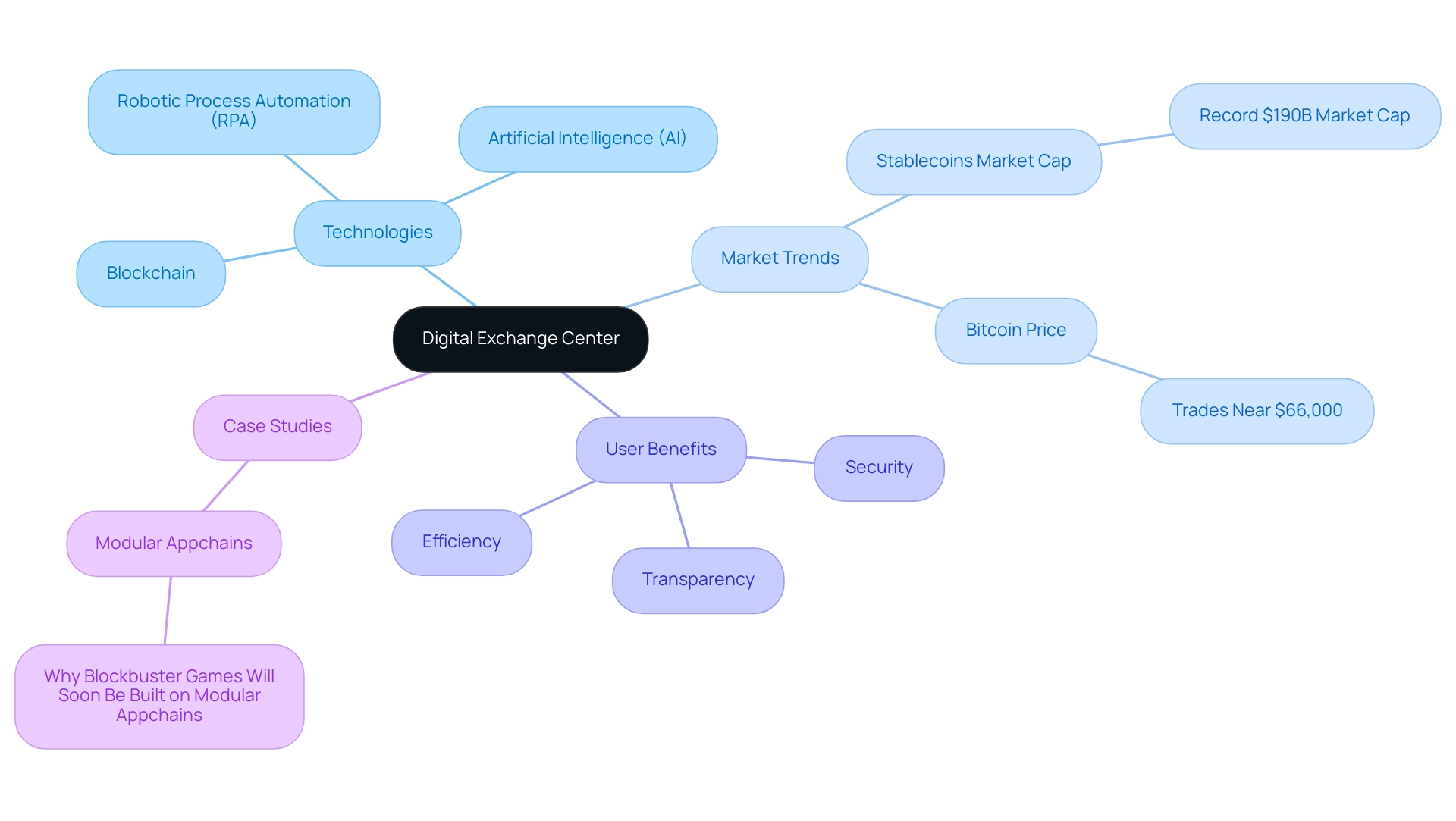
The Role of Digital Exchange Centers in Transforming Financial Transactions
Digital exchange centers are transforming financial transactions by utilizing advanced methods to enhance speed, security, and accessibility. By incorporating Robotic Process Automation (RPA), these platforms facilitate instantaneous transactions, drastically reducing settlement times and minimizing fraud risks through robust security protocols. This not only democratizes access to financial markets but also frees up teams to focus on strategic tasks, enhancing operational efficiency.
Additionally, the integration of Business Intelligence allows organizations to transform raw data into actionable insights, enabling informed decision-making that drives growth and innovation. For instance, financial institutions can utilize RPA to automate routine compliance checks, while Business Intelligence tools analyze transaction data to identify trends and mitigate risks. The implementation of smart contracts automates transactions based on predefined conditions, streamlining processes and improving business productivity.
Beyond trading, smart contracts are transforming the insurance industry by simplifying claims processing and strengthening relationships between insurers and policyholders. This shift fosters innovation in financial products and services while equipping organizations to adapt swiftly to evolving consumer demands and dynamic market conditions. The significance of these centers is accentuated by the potential for data-driven insights, as evidenced by the fact that 95% of the medical data in Estonia has been digitized.
However, the shared nature of blockchain data can expose organizations to vulnerabilities, making the hiring of skilled blockchain developers critical. As one industry expert noted, ‘Network members look for ways to leverage the use of the blockchain to improve supply chain performance in areas such as efficiency, freshness, waste reduction, and certification verification.’ This highlights the significance of security audits and assessments carried out by internal developers to maximize the potential of blockchain.
As more companies recognize the myriad benefits of the digital exchange center, the integration of RPA, tailored AI solutions, and Business Intelligence into operational strategies will likely become a priority, enhancing competitiveness and driving sustainable growth.
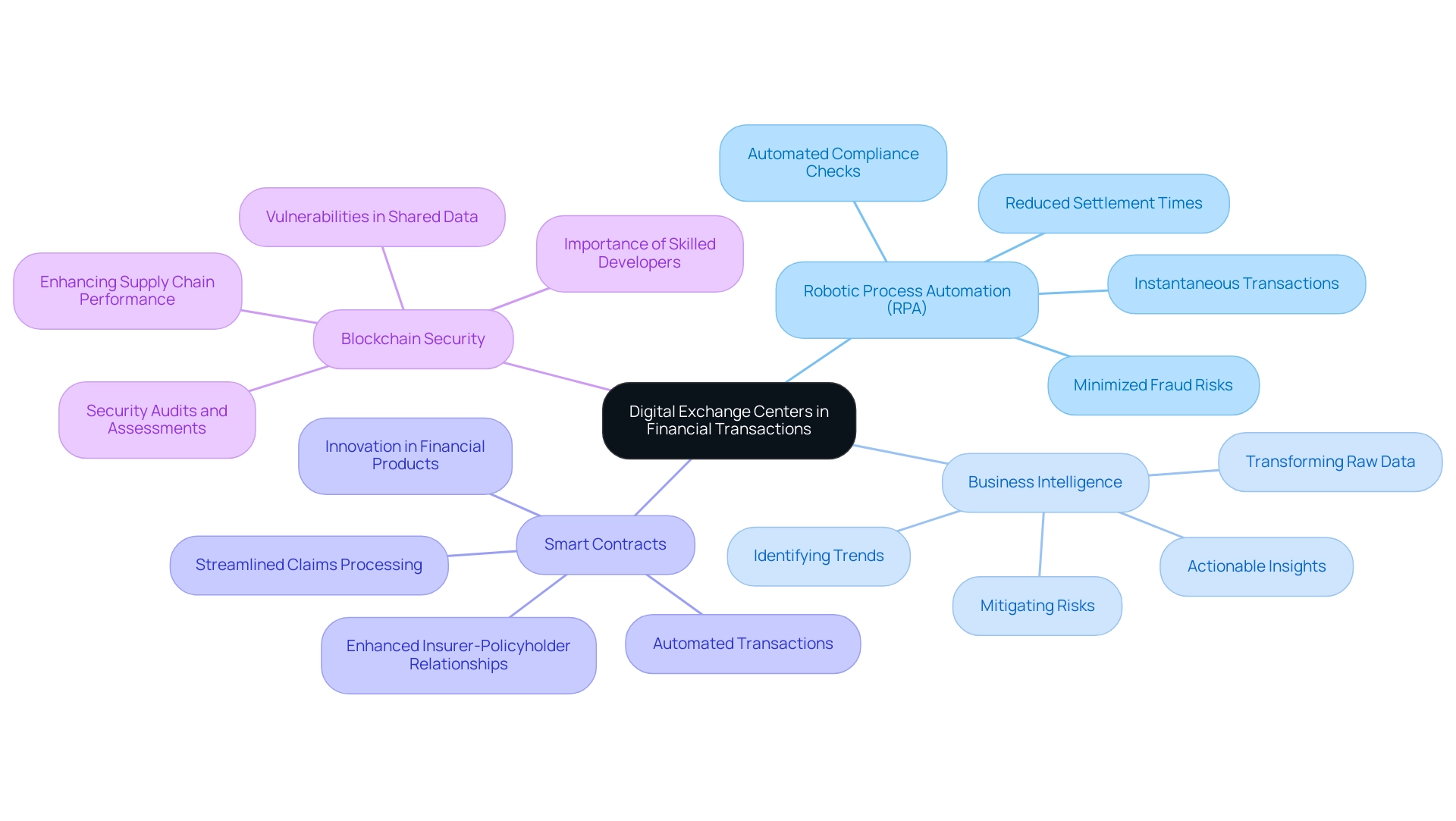
Technological Innovations Driving Digital Exchange Centers
Innovative advancements such as robotic process automation (RPA), artificial intelligence (AI), and machine learning are transforming Digital Exchange Centers, which are essential for enhancing operational efficiency. RPA addresses critical challenges like task repetition fatigue and staffing shortages, allowing firms to streamline their workflows. Companies such as NASDAQ are utilizing AI and blockchain innovations to enhance the security and efficiency of stock operations, showcasing the practical advantages of these advancements.
RPA tools like EMMA RPA and Microsoft Power Automate streamline repetitive tasks, boosting efficiency and employee morale by allowing teams to focus on more strategic initiatives. Blockchain technology secures and simplifies transactions through an immutable ledger, enhancing transparency and significantly reducing the risk of counterfeit assets. This security foundation fosters greater trust among market participants.
Meanwhile, AI and machine learning revolutionize strategies by analyzing vast datasets to uncover trends and deliver predictive insights, empowering traders to make informed decisions that optimize returns and manage risks effectively. For example, the ‘Benefits of AI for Small Traders’ case study illustrates how AI democratizes access to advanced trading strategies, enabling small traders to enhance their decision-making capabilities. Moreover, our customized AI solutions, featuring Small Language Models and GenAI Workshops, offer specialized tools to further enhance data quality and operational efficiency.
The ongoing integration of RPA, AI, and business intelligence is crucial for overcoming implementation challenges and driving informed decision-making, ensuring firms maintain a competitive edge in the rapidly evolving financial landscape. Book a free consultation to explore how we can help you leverage these technologies for your business success.
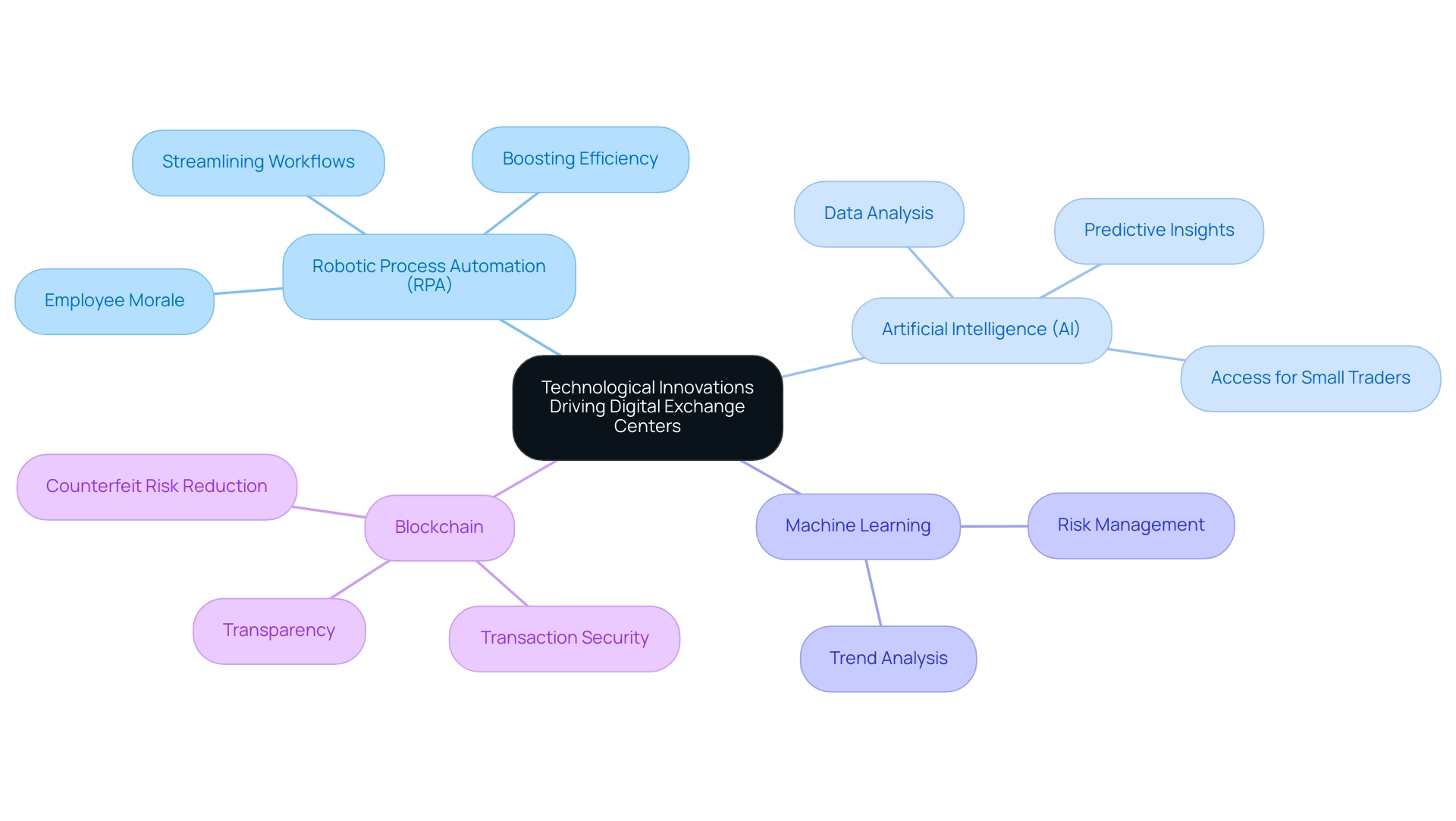
Regulatory Considerations for Digital Exchange Centers
As digital exchange centers continue to rise in prominence, they face the pressing challenge of navigating a multifaceted regulatory landscape that varies significantly across jurisdictions. Compliance with anti-money laundering (AML) practices and know your customer (KYC) requirements is not merely a legal obligation; it is critical for fostering trust with users and ensuring the long-term success of these platforms. Jesse Mudaliyar, Vice President at MasterCard, notes,
The establishment of a unified regulatory framework for AML and KYC presents a compelling solution.
This unified framework is essential not only for mitigating risks associated with non-compliance but also for enhancing the integrity of the financial system and combating criminal exploitation. The breach at Binance, where over 10,000 personal photographs were stolen, underscores the vulnerabilities in the system, highlighting the urgent need for robust compliance measures. Furthermore, recommendations for creating tailored legal frameworks in the cryptocurrency space emphasize the importance of establishing clear regulatory guidelines and mandatory compliance requirements.
By proactively addressing these regulatory considerations, businesses can enhance their reputation and cultivate a secure commerce environment. This effort not only aids in the development of digital exchange centers but also fosters their acceptance within the wider financial ecosystem, reinforcing the essential role of AML and KYC practices in digital transactions.
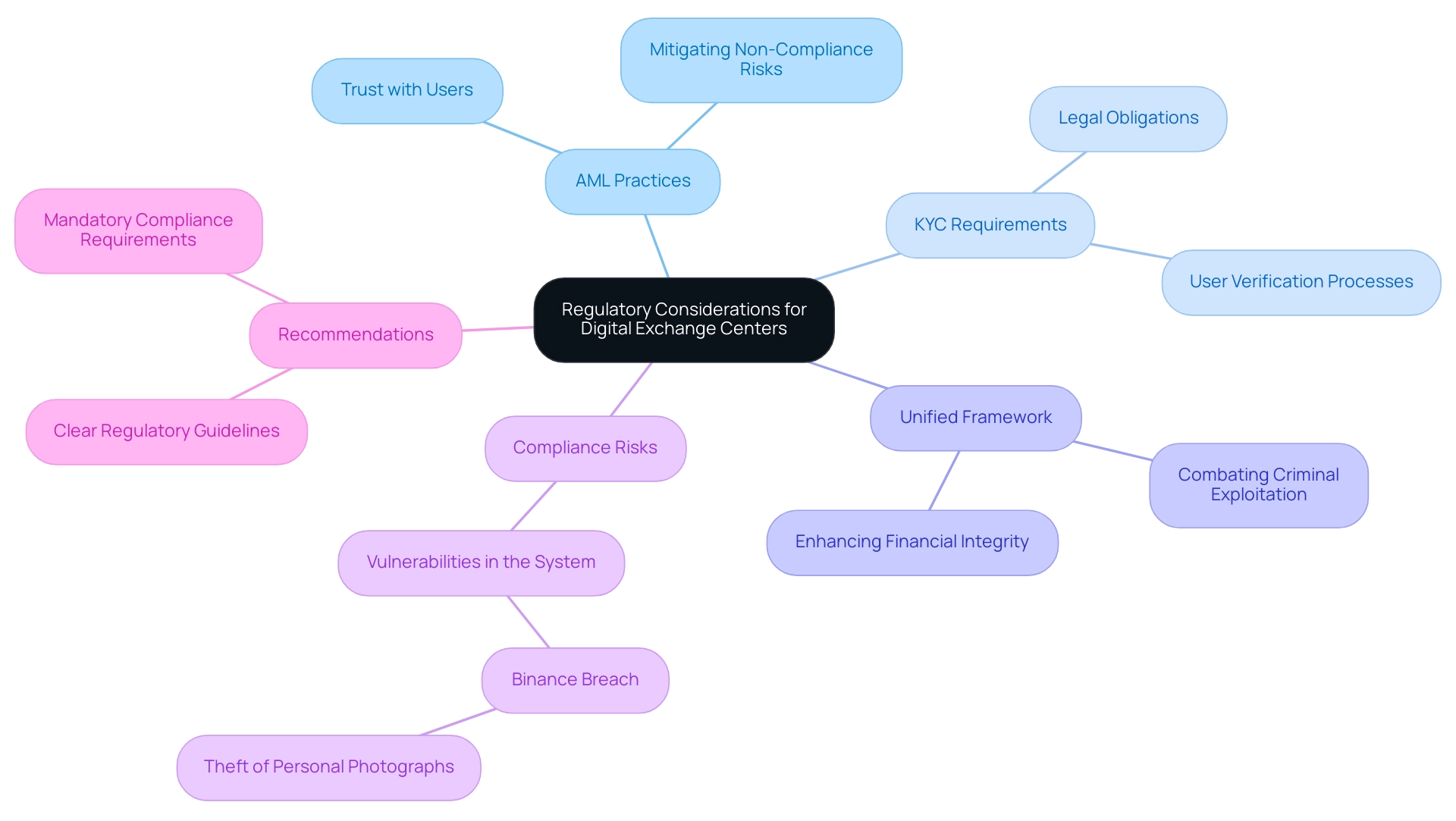
The Future of Digital Exchange Centers in Finance
The future of Digital Trading Centers is poised for significant growth and transformation as technology continues to advance and consumer preferences evolve. As more organizations acknowledge the advantages of digital asset exchange, we can anticipate a rise in the adoption of digital exchange centers across various sectors. Innovations like decentralized finance (DeFi) and non-fungible tokens (NFTs) are expected to further broaden the scope of Digital Market Centers, facilitating new forms of asset transactions and investment opportunities.
In this rapidly evolving landscape, leveraging Robotic Process Automation (RPA) will be crucial for organizations looking to streamline manual workflows and enhance operational efficiency. RPA can significantly reduce errors, improve productivity, and free up resources for more strategic tasks. Additionally, the integration of artificial intelligence will enhance personalized trading experiences, allowing users to tailor their strategies based on individual preferences and risk profiles.
However, organizations often face challenges in identifying the right AI solutions amidst a rapidly changing landscape. Furthermore, employing Business Intelligence tools is essential for extracting meaningful insights from vast data sets, as failing to leverage these insights can place organizations at a competitive disadvantage. As the financial landscape continues to evolve, organizations that embrace digital exchange centers, along with RPA and AI solutions, will be better positioned to thrive in an increasingly digital economy.
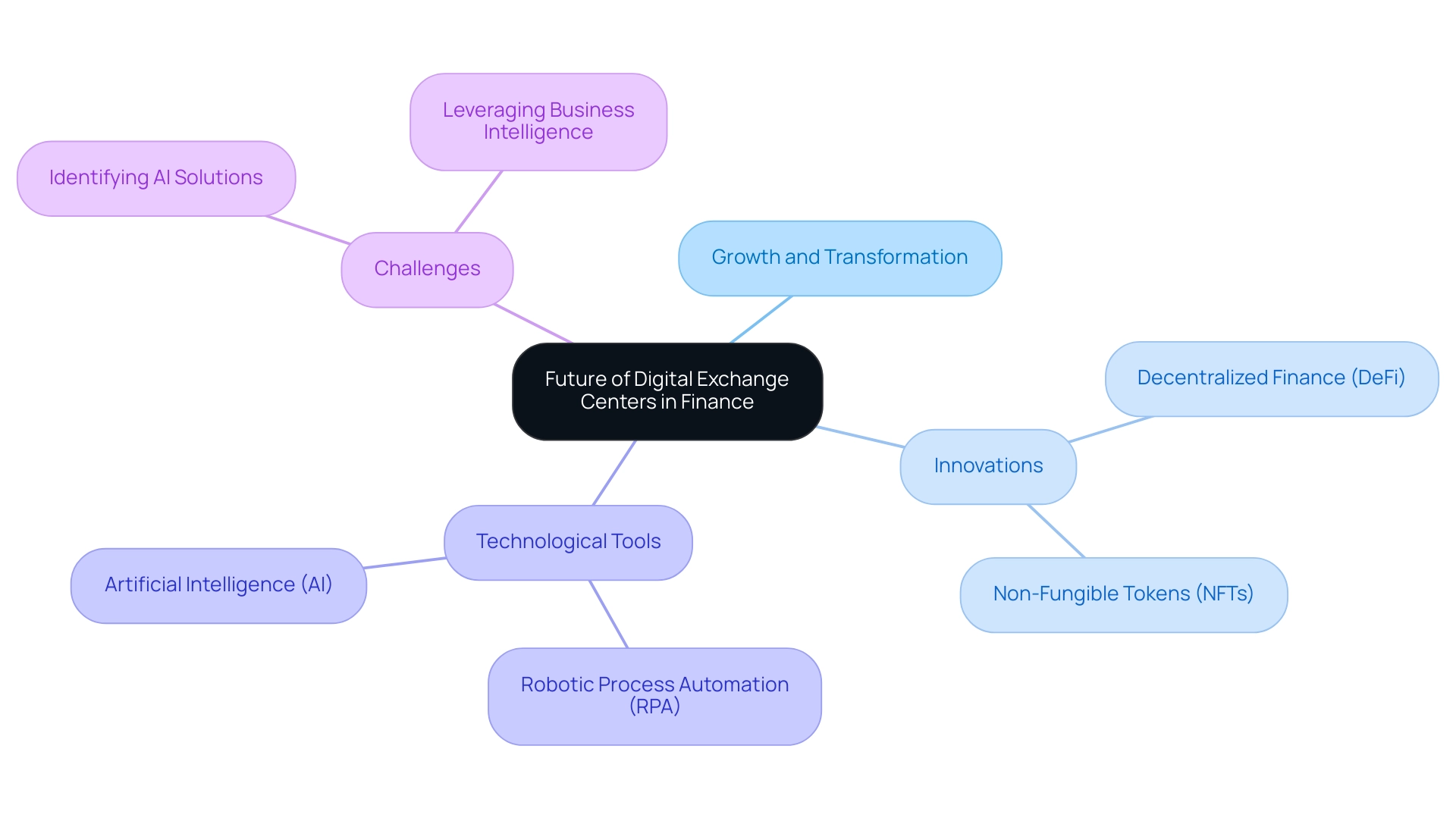
Conclusion
Digital Exchange Centers are at the forefront of a financial revolution, reshaping how digital assets are traded and managed. By harnessing advanced technologies like blockchain, artificial intelligence, and Robotic Process Automation, these platforms enhance security, efficiency, and accessibility, paving the way for a more democratized financial landscape. The integration of RPA not only streamlines transaction processes but also liberates teams to focus on strategic initiatives, thereby fostering operational agility. As evidenced by the growing market for stablecoins and the rise of decentralized finance, the momentum behind these centers is undeniable.
Navigating the complex regulatory landscape remains a critical challenge for Digital Exchange Centers, emphasizing the necessity for robust compliance measures. By proactively addressing anti-money laundering and know your customer requirements, organizations can build trust and secure their position in the market. The need for a unified regulatory framework is essential for mitigating risks and enhancing the integrity of the financial system, ensuring that Digital Exchange Centers can thrive in a secure environment.
Looking ahead, the future of Digital Exchange Centers is bright, with promising innovations on the horizon. As organizations increasingly recognize the benefits of digital asset trading, the adoption of these platforms is set to rise. Leveraging RPA and AI will be crucial in overcoming operational challenges and enhancing user experiences. By embracing these transformative technologies and remaining agile in a rapidly evolving financial landscape, businesses can position themselves for success, ensuring they not only survive but thrive in the era of digital finance.
Introduction
In an era marked by rapid technological advancements, Robotic Process Automation (RPA) emerges as a powerful ally for organizations striving to enhance operational efficiency. By automating repetitive tasks, RPA not only streamlines workflows but also liberates employees from mundane duties, allowing them to focus on strategic initiatives that drive growth.
Understanding the intricacies of RPA is crucial for leaders aiming to navigate the complexities of implementation while maximizing the benefits of automation. This article delves into the essential stages of the RPA life cycle, effective strategies for measuring success, overcoming resistance to change, and the promising future of automation.
With practical insights and actionable solutions, organizations can unlock the transformative potential of RPA, positioning themselves for sustained success in an increasingly competitive landscape.
Understanding Robotic Process Automation (RPA)
Robotic Process Automation (RPA) is a transformative technology that enables entities to automate repetitive, rule-based tasks traditionally carried out by humans. By employing software robots, RPA streamlines workflows, reduces operational costs, and minimizes errors, enhancing overall productivity. This technology is particularly beneficial in environments with high volumes of repetitive tasks, such as:
- Data entry
- Invoice processing
- Customer service inquiries
Comprehending the automation life cycle is essential for Directors of Operations Efficiency, as it enables entities to identify opportunities for automation that enhance operational efficiency, overcome technology implementation challenges, and drive innovation. Key features of RPA tools, such as automated data extraction and process monitoring, further contribute to cost savings and efficiency improvements. Furthermore, when combined with tailored AI solutions and Business Intelligence, organizations can leverage data-driven insights to make informed decisions, ultimately allowing employees to focus on higher-value activities that foster growth and competitive advantage.
To explore how RPA can transform your operations, book a free consultation today.
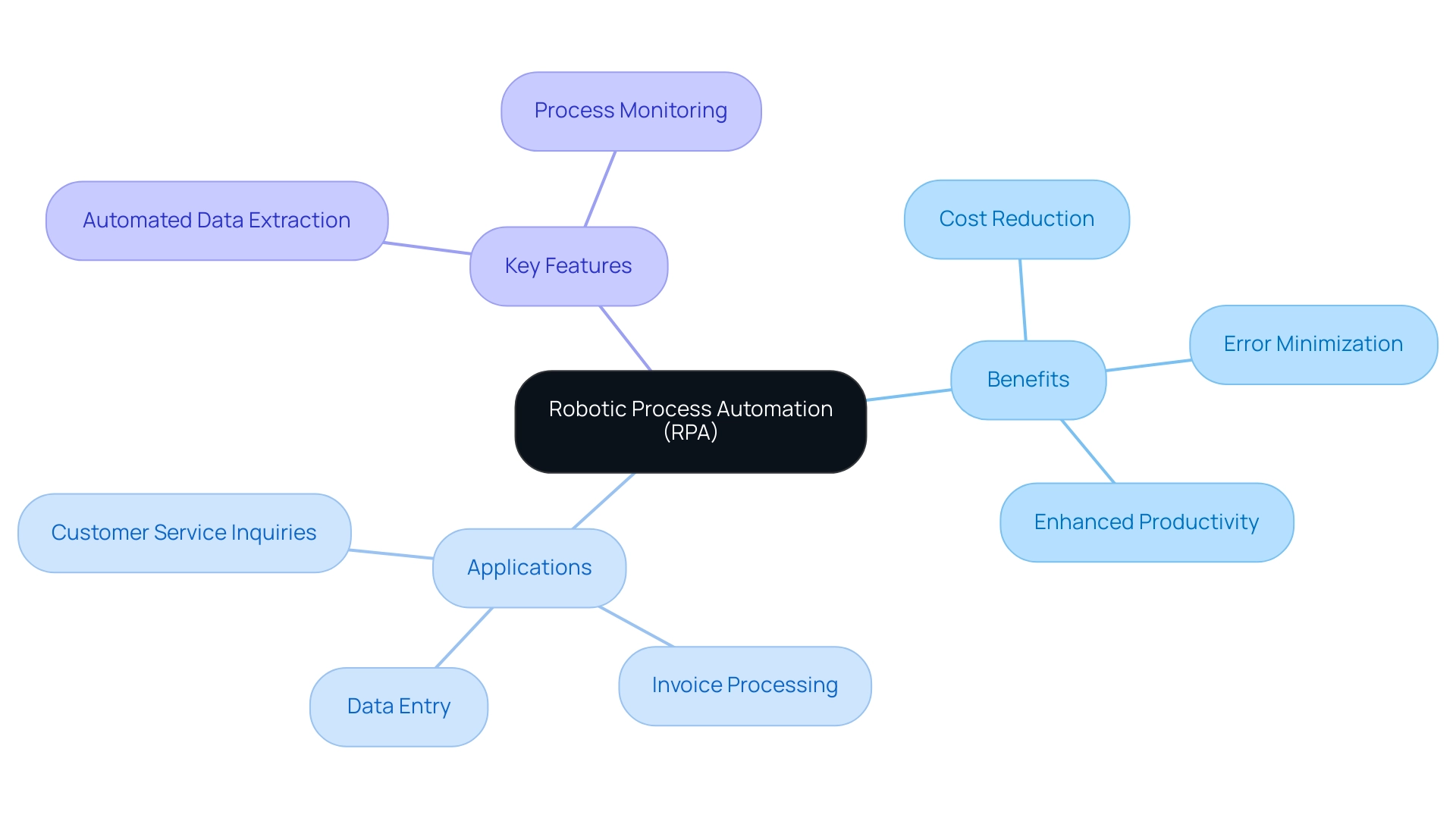
The Six Essential Stages of the RPA Life Cycle
The Robotic Process Automation (RPA) life cycle includes six essential stages that are crucial for the successful execution of the automation life cycle. Each stage is designed to enhance operational efficiency and drive productivity across business processes:
-
Identification: The journey begins with identifying procedures suitable for mechanization. This stage requires a meticulous examination of workflows to uncover repetitive tasks, which often lead to employee exhaustion and hinder overall productivity.
-
Assessment: Once potential processes are identified, the next step is to evaluate their preparedness for mechanization. Factors such as task complexity, anticipated return on investment (ROI), and alignment with organizational objectives are assessed to ensure a strategic approach, especially crucial for companies struggling with staffing shortages and the retention of talent.
-
Design: During this phase, detailed specifications for the mechanization initiative are crafted. This includes outlining the workflow, setting rules, and integrating with existing systems to create a unified operational setting, tackling the widespread problem of outdated systems that hinder progress.
-
Development: The actual automation takes shape in this stage. Here, software robots are configured to execute tasks as defined in the design phase, with capabilities to adapt to exceptions and variations in workflows, significantly reducing manual errors and optimizing operations.
-
Testing: Rigorous testing is essential to confirm that the automated processes perform efficiently and accurately. This critical stage helps identify any potential issues or bugs prior to full-scale deployment, ensuring a smooth transition and minimizing disruption. It specifically addresses challenges related to manual data entry errors and slow software testing, ensuring that these issues are alleviated through mechanization.
-
Deployment and Maintenance: Following successful testing, the automation is launched into the live environment. Continuous oversight and upkeep are essential to guarantee lasting efficiency and to adjust to changing business needs.
By thoroughly understanding and adhering to these six stages of the automation life cycle, entities can harness the full potential of RPA. The successful implementation of RPA has been demonstrated to result in significant time savings and an increase in execution rates. For instance, a U.S. healthcare coverage administrator that utilized RPA for data extraction and entry achieved an impressive 85% reduction in manual work with a remarkable 99% accuracy rate.
This exemplifies the transformative impact of RPA on operational efficiency. As Cristina-Claudia Osman noted, “Robotic Process Automation provides considerable potential in several domains,” highlighting the broad applicability and benefits of a well-executed RPA strategy. Additionally, companies like Hypatos have demonstrated the financial impact of RPA, achieving a 7-digit annual recurring revenue and a 9-digit valuation within just two years, showcasing the growth potential associated with successful RPA implementation.
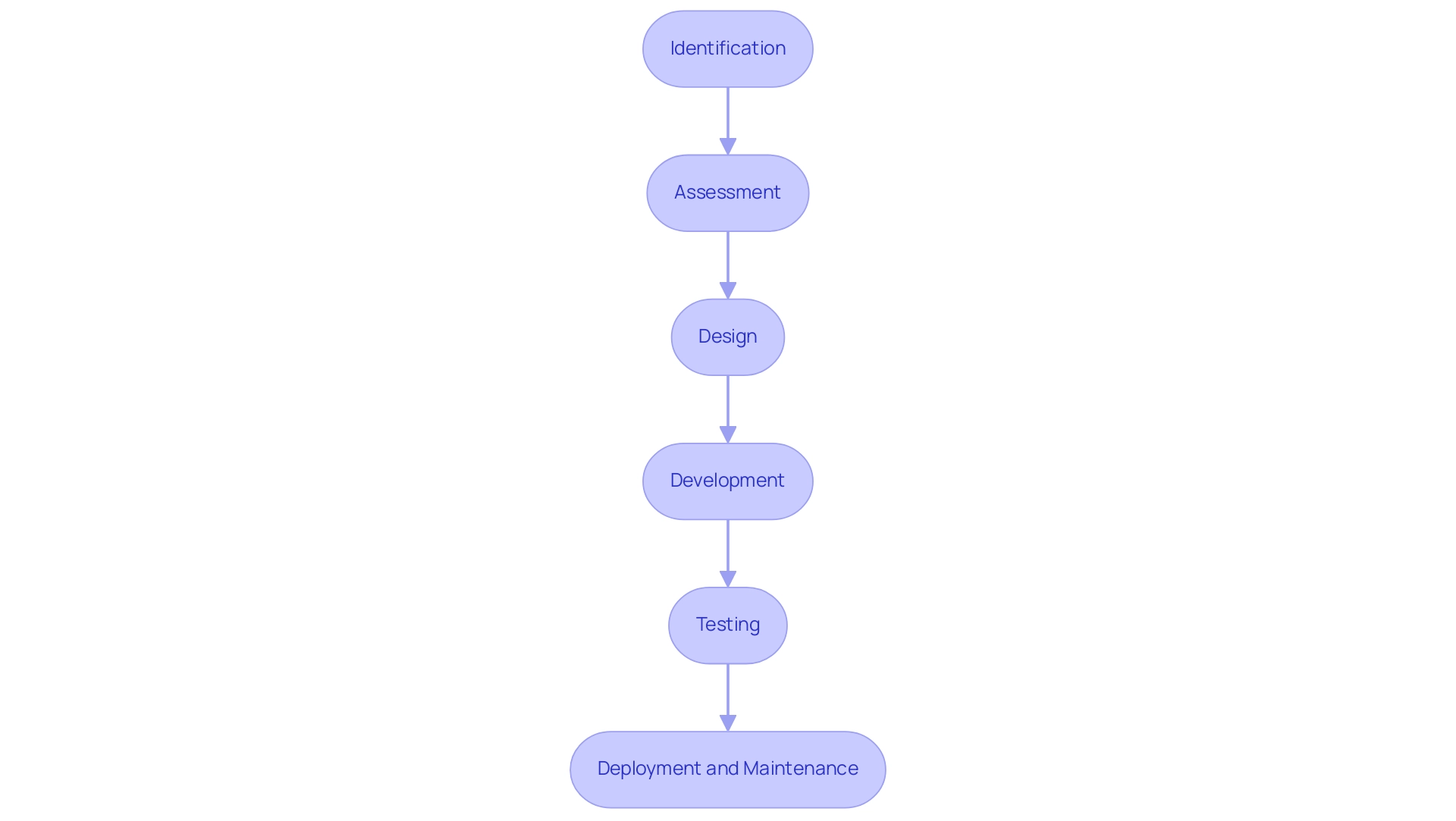
Measuring Success in RPA Implementation
To gauge the success of RPA implementation, entities should focus on several key performance indicators (KPIs):
- Time Savings: Measure the reduction in time taken to complete automated tasks compared to manual processes, recognizing that RPA streamlines workflows and boosts efficiency.
- Error Rate: Track the decrease in errors associated with automated tasks, as RPA significantly minimizes human error, enhancing operational reliability.
- Cost Reduction: Analyze the overall cost savings achieved through automation, including labor costs and operational expenses, allowing for reinvestment in more strategic initiatives.
- Employee Satisfaction: Conduct surveys to assess employee satisfaction and engagement, as RPA empowers teams to shift focus from manual tasks to strategic, value-adding work.
- Scalability: Evaluate how easily the automation can be scaled to accommodate increased workloads or new processes, ensuring that the technology grows alongside business demands.
Incorporating tailored AI solutions alongside RPA can further enhance these efforts, providing entities with advanced tools that complement automation initiatives. By systematically measuring these KPIs, entities can assess the effectiveness of their RPA initiatives throughout the automation life cycle, identify areas for further improvement, and leverage the power of Business Intelligence to transform data into actionable insights that drive growth and innovation. Failing to utilize Business Intelligence may leave companies at a competitive disadvantage, as the ability to make informed decisions is crucial in today’s data-rich environment.
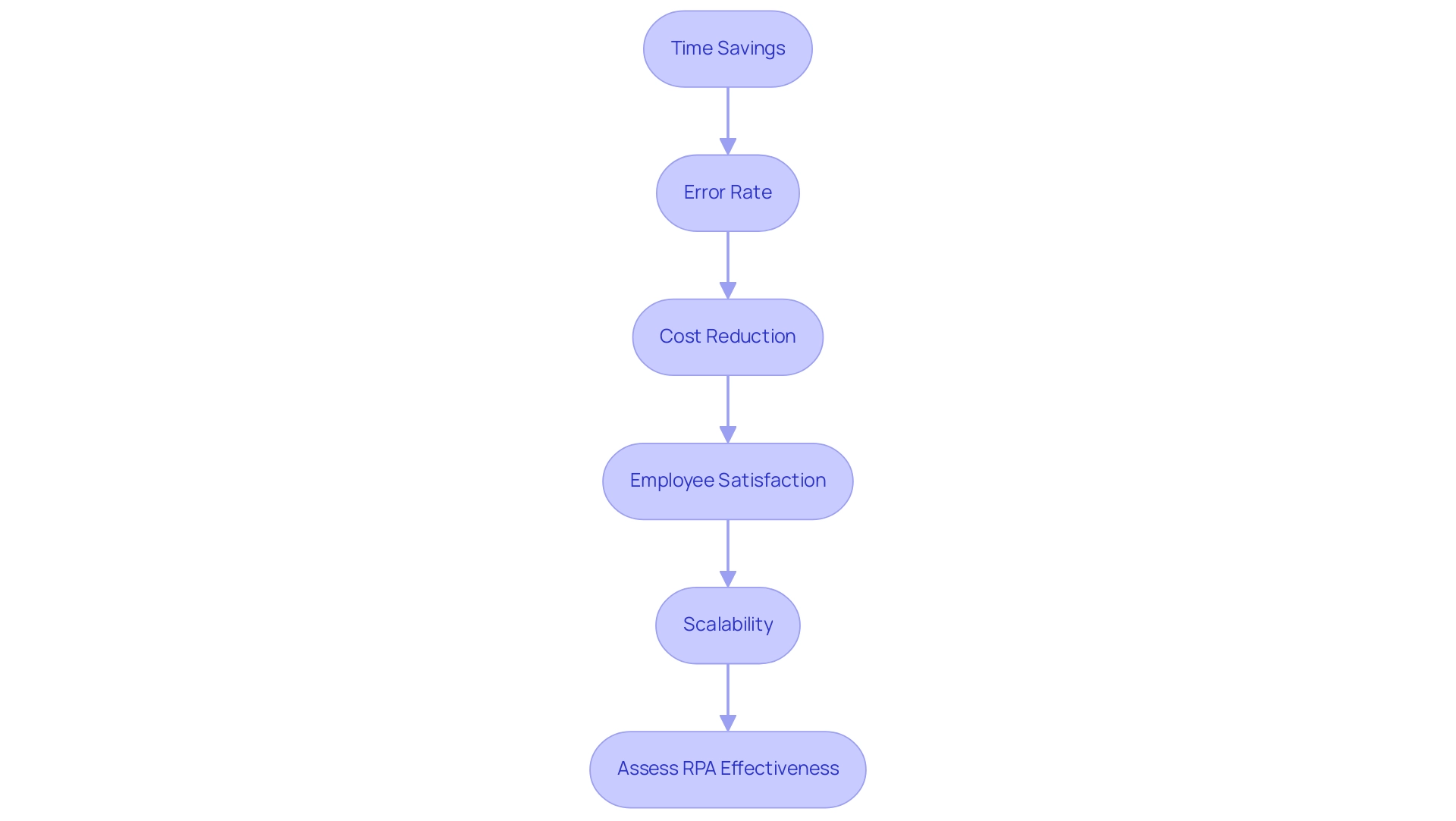
Overcoming Resistance to Change
Resistance to change is a common hurdle in RPA implementation. To effectively manage this, entities can adopt the following strategies:
- Communication: Clearly communicate the benefits of RPA to all stakeholders, emphasizing how it enhances job roles rather than replacing them. Highlight that RPA can streamline workflows, reduce errors, and free up teams for strategic, value-adding work, ultimately leading to lower operational costs and increased productivity.
- Involvement: Engage employees in the development process by seeking their input and feedback. This fosters a sense of ownership and reduces apprehension, ensuring that the tailored AI solutions align with their specific business goals and challenges.
- Training: Provide comprehensive training to equip employees with the necessary skills to work alongside RPA technologies, ensuring they feel confident and competent. This training should focus on how RPA can enhance productivity and facilitate informed decision-making through Business Intelligence.
- Pilot Programs: Implement pilot programs to demonstrate the effectiveness of RPA on a smaller scale. For instance, a pilot project that automates invoice processing could show a 30% reduction in processing time and a 25% decrease in errors, allowing employees to witness firsthand the benefits before full-scale deployment.
By proactively addressing resistance to change with these targeted strategies, entities can create a more conducive environment for successful RPA implementation, ultimately enhancing operational efficiency and achieving significant cost savings in a rapidly evolving AI landscape.
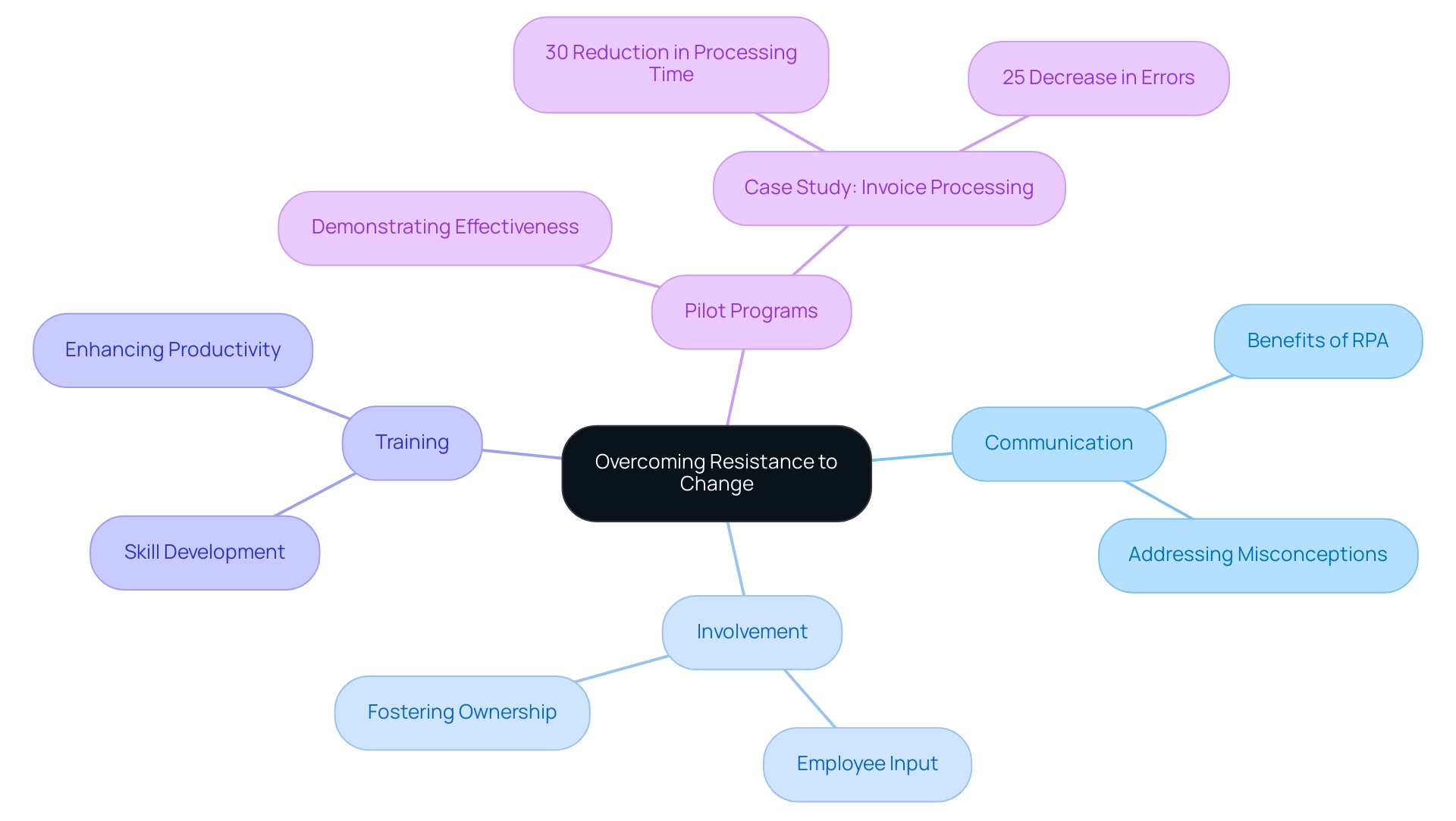
The Future of RPA and Automation
The future of Robotic Process Automation (RPA) and systematization is promising, characterized by several transformative trends:
-
Integration with AI: The synergy between RPA and artificial intelligence is set to enhance systematization capabilities significantly. This convergence will empower robots to tackle intricate tasks that necessitate decision-making and adaptive learning, leading to improved operational efficiency.
-
Increased Adoption Across Industries: The recognition of RPA’s advantages is driving its widespread adoption across diverse sectors, including healthcare, finance, and manufacturing. For instance, a major healthcare provider successfully implemented AI and RPA for patient scheduling and billing, resulting in a remarkable 30% reduction in administrative costs and significantly higher patient satisfaction. Furthermore, a financial institution that automated loan handling illustrates how entities are utilizing RPA to enhance operations across different sectors.
-
Focus on User Experience: Upcoming RPA solutions will prioritize user experience, ensuring that non-technical users can effortlessly create and oversee workflows. This change will make automated systems accessible to more employees, enabling them to participate in operational enhancements without needing extensive technical skills, thereby boosting overall productivity.
-
Enhanced Analytics: Advanced analytics will offer companies deep insights into their automated workflows, supporting continuous optimization. As Abhaykumar Dalsaniya noted, the integration has improved processes and decision-making skills within the supply chain, highlighting the transformative impact of these technologies.
-
Importance of Tailored AI Solutions: As businesses navigate the rapidly evolving landscape, tailored AI solutions will play a crucial role in helping firms identify the right technologies that align with their specific needs and challenges. This targeted approach ensures that companies can effectively utilize technology to enhance operational efficiency.
-
Role of Business Intelligence: In today’s data-rich environment, the lack of data-driven insights can leave businesses at a competitive disadvantage. Business Intelligence will be essential in transforming raw data into actionable insights, enabling informed decision-making that drives growth and innovation.
-
Positive Impact on Employee Satisfaction: Companies implementing RPA are witnessing significant improvements in employee morale. For example, Company C reported a 20% increase in employee satisfaction, showcasing how RPA can positively influence workplace dynamics by allowing teams to focus on more strategic, value-adding work throughout the automation life cycle.
By staying abreast of these trends and recognizing the importance of tailored AI solutions and Business Intelligence, organizations can strategically position themselves to harness the full potential of RPA within the automation life cycle, driving efficiency and innovation well into 2024 and beyond.
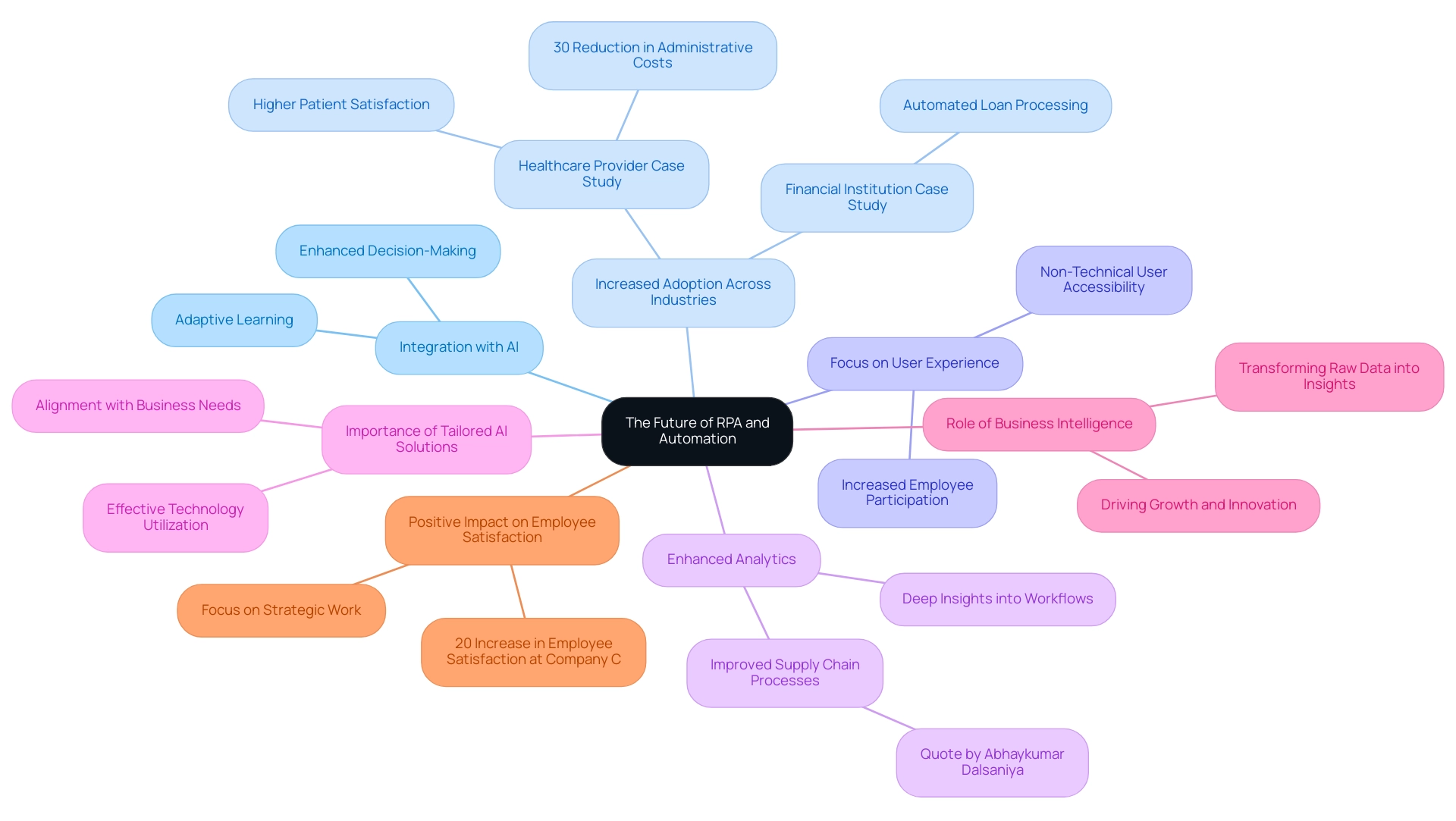
Conclusion
Embracing Robotic Process Automation (RPA) is not merely a technological shift; it represents a strategic opportunity for organizations to enhance operational efficiency and drive growth. By understanding the intricacies of the RPA life cycle—from identification to deployment—business leaders can systematically implement automation that transforms tedious, repetitive tasks into streamlined workflows. This proactive approach not only reduces costs and errors but also empowers employees to focus on high-value initiatives that foster innovation and competitive advantage.
Measuring success through key performance indicators such as:
- Time savings
- Error rates
- Employee satisfaction
is essential for organizations to gauge the effectiveness of their RPA initiatives. As resistance to change remains a common challenge, fostering open communication, involving employees, and providing comprehensive training can pave the way for smoother transitions. Pilot programs also serve as effective tools to demonstrate RPA’s value on a smaller scale, allowing teams to witness firsthand the positive impact of automation.
Looking ahead, the future of RPA is bright, characterized by its integration with AI, increased adoption across various industries, and a focus on user experience. By leveraging tailored AI solutions and Business Intelligence, organizations can not only stay competitive but also cultivate a workforce that is more engaged and satisfied. As the landscape of automation continues to evolve, it is imperative for businesses to harness the transformative potential of RPA, ensuring they are well-positioned for sustained success in an increasingly dynamic marketplace.
Introduction
In the rapidly evolving landscape of automation, the design principles that underpin successful implementation can significantly influence an organization’s operational efficiency and adaptability. As businesses strive to streamline processes and enhance productivity, understanding the fundamental tenets of designing for automation becomes paramount. This article delves into the essential principles such as simplicity, modularity, and scalability, while also exploring the critical role of automation in specialized fields like medical device manufacturing.
Furthermore, it highlights the transformative impact of integrating Robotic Process Automation (RPA) and AI solutions within design workflows, showcasing real-world applications and future trends that promise to redefine efficiency standards. By embracing these strategies, organizations can not only overcome common challenges but also position themselves for sustained growth and innovation in an increasingly automated world.
Fundamental Principles of Designing for Automation
-
Simplicity: Prioritizing simplicity in designing for automation is vital for ensuring that systems are intuitive and user-friendly, especially when implementing tools like EMMA RPA and Microsoft Power Automate. Complexity often breeds errors and inefficiencies, making it challenging for teams to operate effectively. As Dave Garrett, Chief Strategy and Growth Officer of the Project Management Institute, aptly states,
It’s our job as leaders to cut through the noise/distractions and simplify.
This mindset is essential in creating tools that serve their purpose without unnecessary complications. Notably, Zoom has gained market share from the more complex Cisco WebEx, highlighting a market preference for simpler solutions, which reflects the user-friendly nature of our RPA solutions. -
Modularity: Adopting a modular design approach allows for straightforward upgrades and maintenance, particularly in automation processes. This flexibility not only aids in troubleshooting but also allows structures to evolve in response to changing requirements. By implementing modular components, businesses can maintain an agile operation that adapts seamlessly to new challenges, enhancing productivity through tools like Power Automate.
-
Standardization: Utilizing standardized components wherever feasible minimizes variability, which is crucial for simplifying the integration of various frameworks. For example, by standardizing on a specific RPA platform, companies can ensure that all components work harmoniously, leading to more consistent performance and streamlined operations. This standardization enables teams to concentrate on providing value instead of overseeing varied processes, ultimately boosting employee morale.
-
Scalability: Designs must incorporate scalability to accommodate fluctuating demands, particularly in an era where automation plays a critical role. This adaptability is paramount in today’s fast-paced environment, particularly when designing for automation, as the ability to scale operations up or down can significantly impact business success. For instance, a retail company might need to rapidly increase its operational capacity using EMMA RPA during peak shopping seasons, demonstrating the importance of designing for automation in a scalable manner.
-
Feedback Mechanisms: Integrating feedback loops into processes is essential for real-time monitoring and adjustments, especially when implementing RPA solutions. This responsiveness ensures that operations can adapt swiftly to unexpected changes or errors, enhancing overall system reliability. A case study titled ‘Listening to Customers’ emphasizes the importance of slowing down to absorb customer feedback before implementing new products. This practice exemplifies how prioritizing simplicity and responsiveness in design can prevent overengineering, ensuring that solutions like EMMA RPA are not only effective but also aligned with customer needs.
-
Addressing Key Challenges: EMMA RPA and Power Automate specifically tackle task repetition fatigue and staffing shortages by automating mundane tasks, allowing employees to focus on more strategic initiatives. This shift not only improves operational efficiency but also boosts employee morale as teams engage in more meaningful work. The case study on GUI technology illustrates these benefits, showcasing how a mid-sized company reduced data entry errors by 70% and improved workflow efficiency by 80%, ultimately achieving ROI within six months. This clear connection between automation tools and measurable outcomes reinforces the value of adopting RPA solutions.
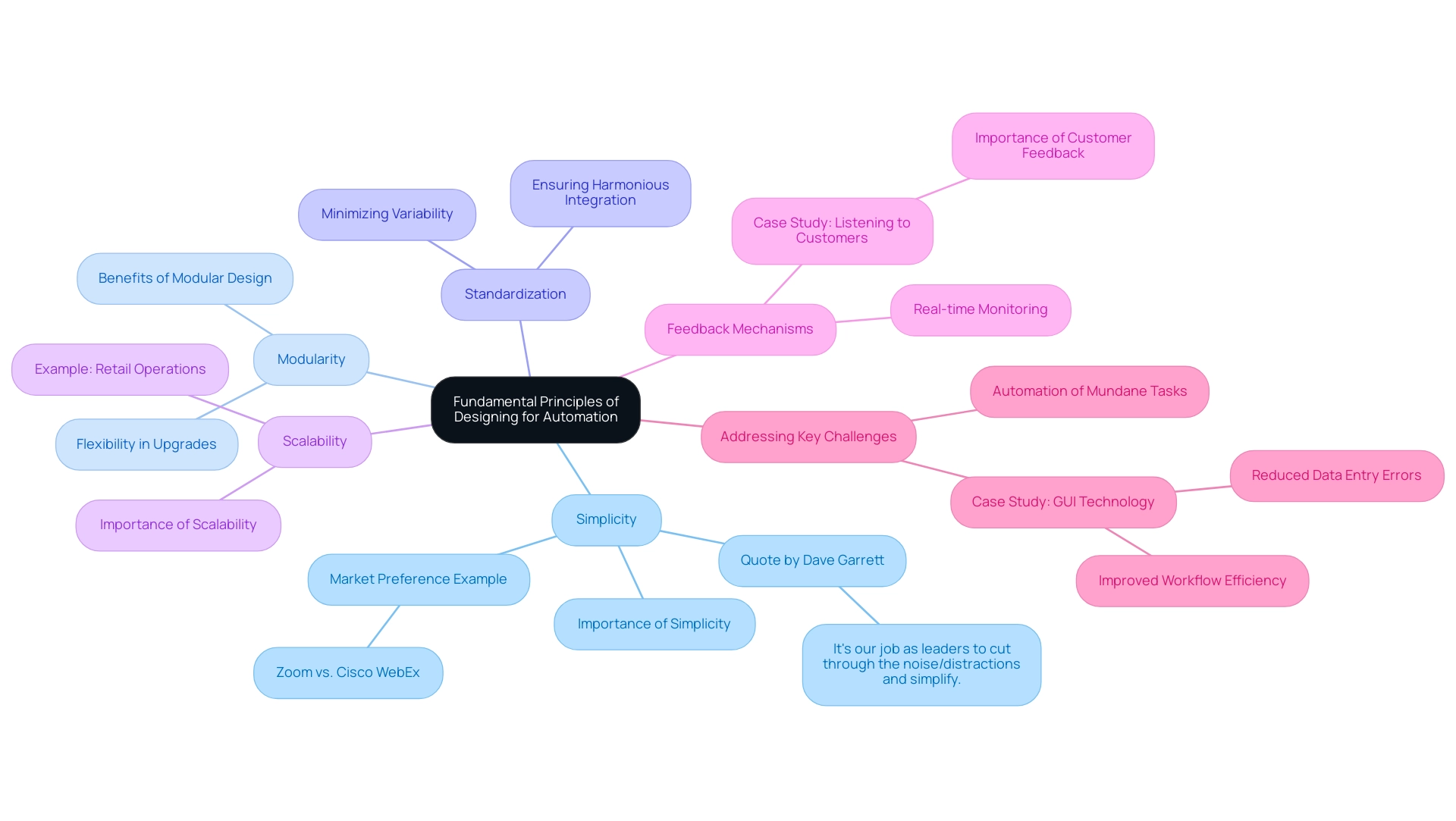
The Role of Design for Automation in Medical Device Manufacturing
-
Regulatory Compliance: Designing for automation in medical devices must comply with strict regulatory standards. DfA helps ensure that designs meet these requirements efficiently.
-
Quality Control: Automated systems can integrate quality control measures directly into the production process, reducing the likelihood of defects and ensuring product reliability.
-
Efficiency and Cost Reduction: By leveraging Robotic Process Automation (RPA) to automate repetitive tasks, manufacturers can significantly reduce production times and labor costs while increasing output. This not only enhances operational efficiency but also allows teams to focus on strategic initiatives that add value. Additionally, RPA addresses the challenges posed by manual, repetitive tasks that can drain resources and hinder productivity.
-
Information Integration and Business Intelligence: Implementing DfA alongside tailored AI solutions allows for seamless integration of information from various sources. This integration, along with Business Intelligence, enables real-time monitoring and analysis, transforming raw information into actionable insights that enhance production workflows and support informed decision-making. In designing for automation, it is essential that automation design prioritizes user experience, especially in medical devices. Designs should accommodate ease of use for healthcare professionals, ensuring safety and functionality while addressing challenges like talent retention and obsolete frameworks that hinder productivity.
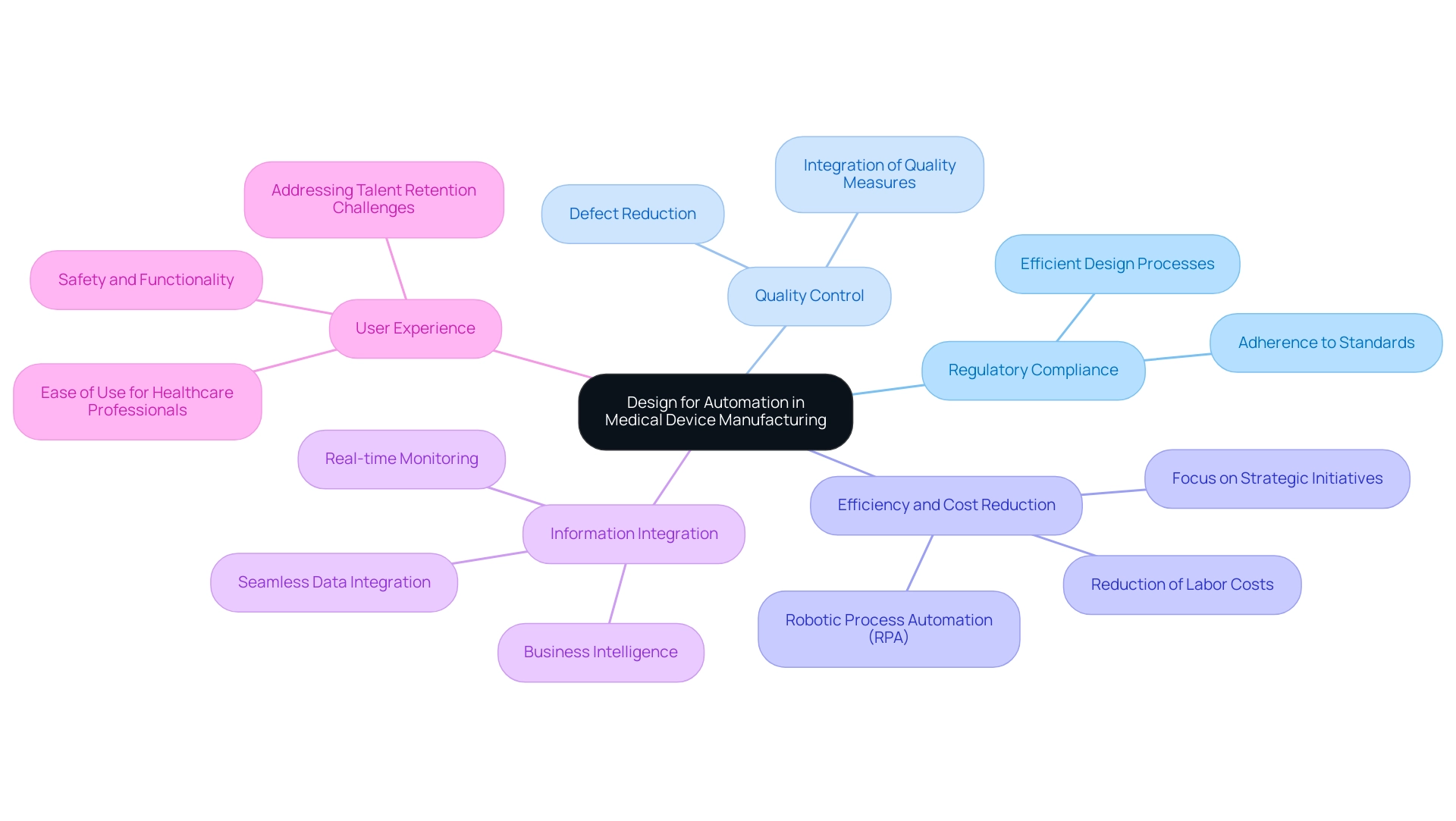
Implementing Robotic Process Automation (RPA) in Design Workflows
-
Identifying repetitive tasks is crucial when designing for automation, as it allows you to assess your design workflow and pinpoint time-consuming activities like data entry or document management. Recognizing these tasks is crucial, as they can significantly slow down operations and impact employee morale.
-
Selecting RPA Tools: Choose RPA tools that align with your needs. Popular options include UiPath, Blue Prism, and Automation Anywhere, each offering unique features tailored to streamline processes and boost efficiency. These tools can also help alleviate staffing shortages by automating tasks that would otherwise require additional personnel.
-
Creating RPA Scripts: Develop RPA scripts to automate the identified tasks. Ensure that these scripts are well-documented to facilitate future modifications, making it easier to adapt to changing business needs. This process also modernizes outdated systems, ensuring smoother operations.
-
Testing and Validation: Before full implementation, thoroughly test RPA scripts in a controlled environment to validate their effectiveness and identify any issues. This step is essential in designing for automation to ensure that the automation solutions will enhance productivity without disrupting existing workflows.
Monitoring and Optimization: Continuously monitor RPA performance and gather feedback from users. Optimize scripts based on performance metrics to enhance efficiency further, ensuring that the RPA solutions effectively mitigate repetitive task fatigue and contribute to a more dynamic working environment.
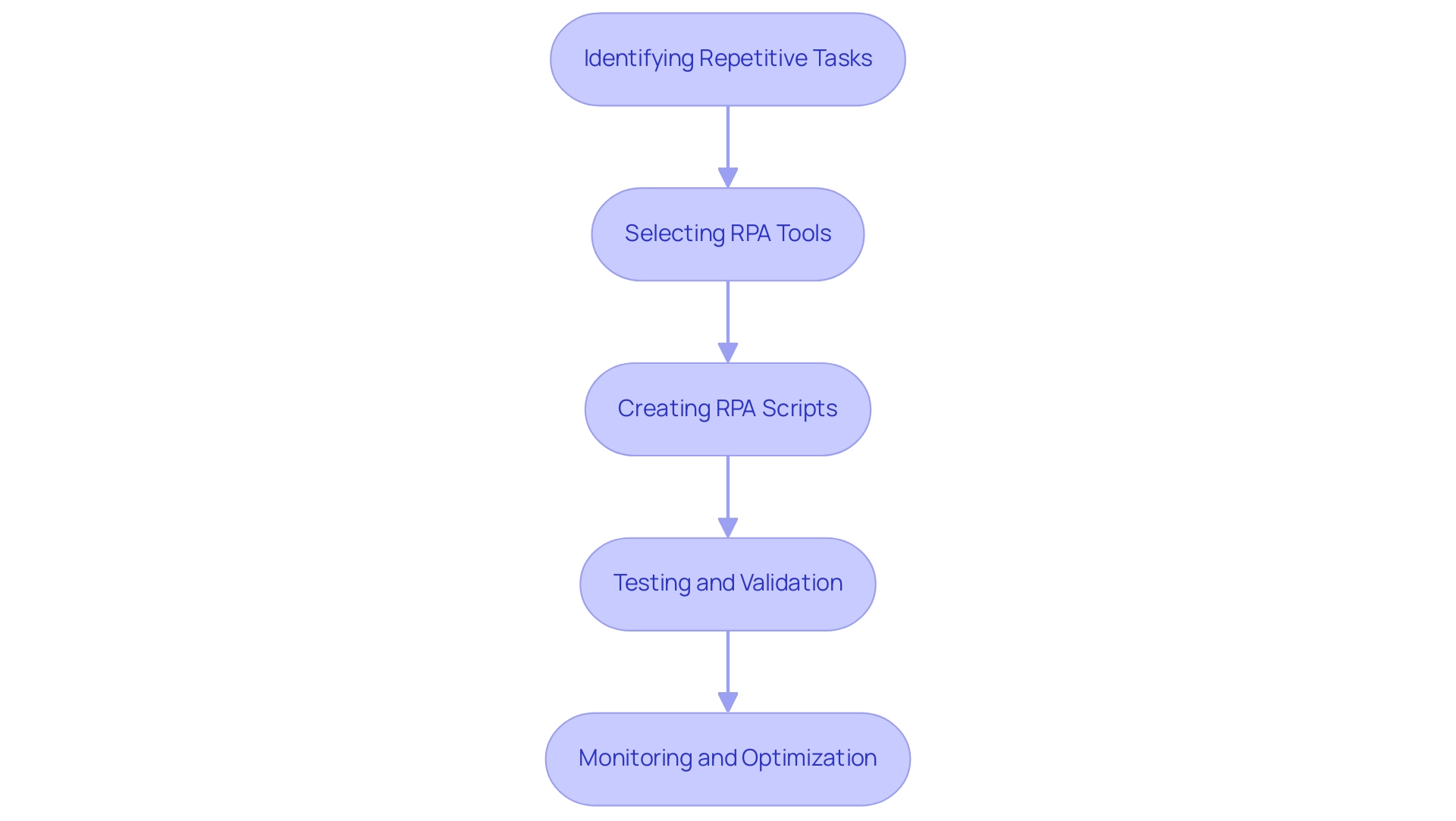
Integrating AI Solutions in Automation Design
-
Data Analysis: Utilize AI algorithms, such as those in EMMA RPA, to analyze information from automated processes, identifying patterns that can inform designing for automation and enhance operational efficiency.
-
Predictive Maintenance: Implement AI-driven predictive maintenance solutions that anticipate equipment failures before they occur, minimizing downtime and ensuring continuous operations.
-
Adaptive Control Frameworks: Create adaptive control frameworks that employ AI to modify operations based on real-time information, improving overall efficiency and responsiveness to changing conditions.
-
User Interaction: Integrate AI interfaces that enhance user engagement by designing for automation in automated processes, such as Microsoft Power Automate, improving usability and operational effectiveness.
-
Continuous Learning: Allow systems to learn from data and adjust over time, ensuring that the processes remain efficient and pertinent in evolving environments. This approach addresses challenges like task repetition fatigue and staffing shortages, ultimately improving employee morale. Our successful GUI task execution case study demonstrates these benefits, achieving an 80% improvement in workflow efficiency while addressing implementation challenges.
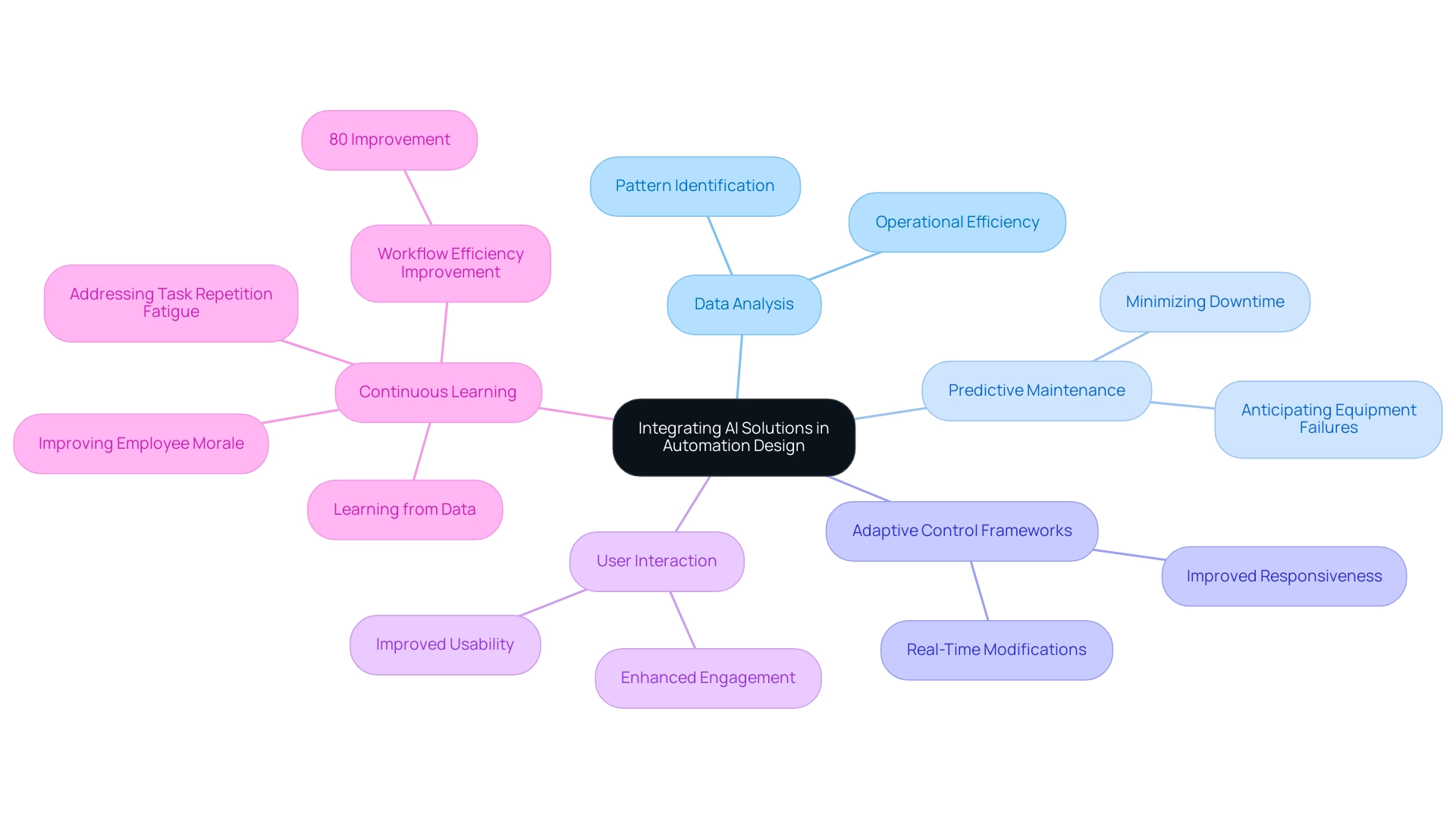
Future Trends in Automation Design
-
The increased use of AI and machine learning in designing for automation is poised for remarkable growth, enabling organizations to leverage smarter decision-making processes. According to Gartner, by 2025, generative AI will augment the human workforce in 90% of companies globally, underscoring the transformative potential of these technologies. Furthermore, the telecommunications industry is increasingly adopting AI-based chatbots, with 52% of telecom businesses utilizing this technology to enhance productivity, reflecting a broader trend of integrating AI into customer service operations. This shift addresses the common reluctance towards AI adoption by demonstrating its practical benefits in real-world scenarios.
-
Collaborative Robotics (Cobots): The prevalence of collaborative robotics will continue to rise, facilitating a seamless partnership between humans and machines. Currently, around 20% of enterprise employees will require reskilling to adapt to these advancements, ensuring that they can effectively collaborate with robots in various operational settings. Emphasizing reskilling helps alleviate concerns about workforce displacement and highlights the potential for enhanced productivity.
-
IoT Integration: The Internet of Things (IoT) is poised to become a fundamental element of system control, enabling real-time information gathering and analysis that greatly improves system responsiveness. The integration of IoT devices will empower organizations to make informed decisions swiftly, optimizing operations and processes. This capability directly addresses issues of poor master data quality, as accurate and timely data is critical for effective AI implementation and overcoming challenges in extracting meaningful insights.
-
Sustainable Practices: A commitment to sustainability will drive the evolution of eco-friendly solutions, aiming to minimize waste and energy consumption. Companies adopting these practices not only contribute to environmental conservation but also position themselves as leaders in a market increasingly influenced by sustainability concerns. Additionally, AI for Good initiatives focus on using AI to address global challenges such as health, poverty, and gender equity, aligning with the sustainability theme and demonstrating that ethical AI practices can enhance corporate reputation.
-
Improved Cybersecurity Strategies: As automated technologies become more interconnected, the significance of strong cybersecurity strategies cannot be overstated. Protecting against potential threats is essential for maintaining operational integrity and ensuring that automated systems function securely and efficiently. By addressing security concerns, organizations can move forward with confidence in their AI initiatives, effectively overcoming some of the prevalent fears associated with designing for automation.
Addressing Poor Master Information Quality: Organizations often face challenges with inconsistent, incomplete, or erroneous information, which can hinder AI implementation. By concentrating on enhancing master information quality, businesses can improve their information-driven decision-making processes. For instance, a manufacturing firm that implemented data governance frameworks saw a 30% reduction in errors related to inventory management, showcasing the direct benefits of addressing data quality issues.
- Real-World Case Studies: To illustrate the practical benefits of AI and automation, consider how a retail company integrated Small Language Models (SLMs) to enhance customer service operations. By utilizing SLMs, the company improved response times and customer satisfaction rates, demonstrating the tangible advantages of adopting AI technologies.
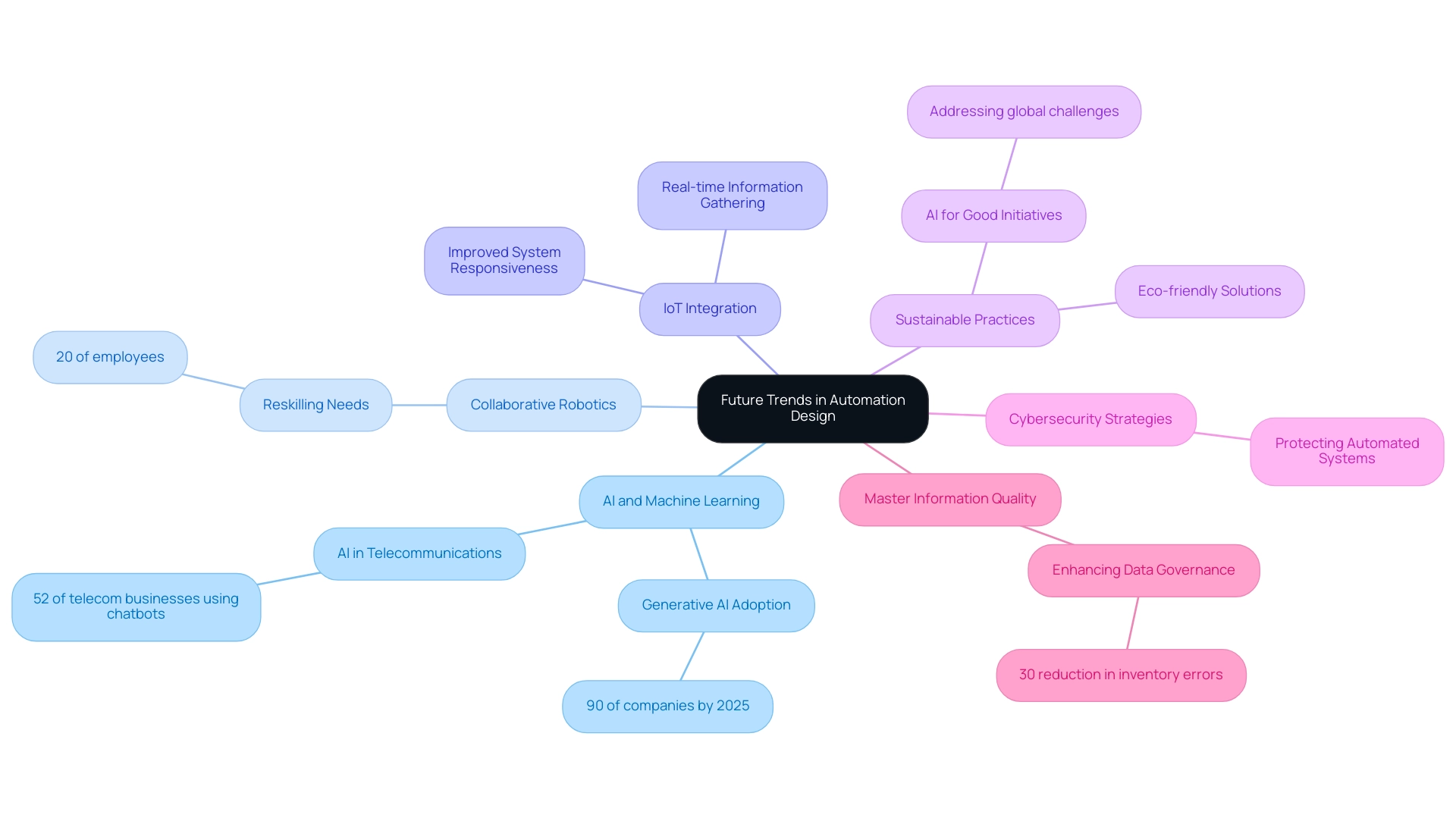
Conclusion
Embracing the principles of designing for automation is crucial for organizations aiming to enhance operational efficiency and adaptability. By focusing on simplicity, modularity, standardization, scalability, and the integration of feedback mechanisms, businesses can create systems that not only meet current demands but also evolve with changing needs. The case studies highlighted throughout this article underscore the tangible benefits of these principles, from reducing errors and improving workflow efficiency to boosting employee morale by alleviating repetitive task fatigue.
In specialized fields such as medical device manufacturing, the importance of regulatory compliance and quality control further emphasizes the need for a thoughtful design approach. Automation tools like RPA and AI not only streamline processes but also enhance data integration and business intelligence, enabling teams to focus on strategic initiatives that drive value. As organizations implement these technologies, they position themselves to overcome staffing challenges and improve productivity.
Looking ahead, the integration of AI, collaborative robotics, and IoT will redefine automation design, paving the way for sustainable practices and robust cybersecurity measures. By addressing issues such as data quality and ensuring that systems remain user-centric, companies can create a resilient framework for future growth. The journey toward automation is not merely about adopting new technologies; it is about transforming operations to unlock new levels of efficiency and innovation, ultimately leading to sustained competitive advantage in an increasingly automated world.
Introduction
In a world where efficiency is paramount, organizations are turning to Robotic Process Automation (RPA) as a transformative solution to streamline operations and drive growth. By harnessing the power of software bots, companies can automate repetitive tasks that once consumed valuable human resources, paving the way for enhanced accuracy and faster turnaround times. From invoice processing to customer service, RPA is reshaping the landscape of business operations, enabling teams to focus on strategic initiatives rather than mundane chores.
As organizations navigate the complexities of integrating RPA with artificial intelligence, they unlock new levels of operational efficiency and informed decision-making. This article delves into the multifaceted impact of RPA, exploring its transformative use cases across various sectors and the future trends that promise to revolutionize the way businesses operate.
Understanding Robotic Process Automation (RPA) and Its Business Impact
Robotic Process Automation (RPA) refers to the use of software robots or ‘bots’ to automate repetitive and rule-based tasks typically performed by humans. This powerful tool can streamline business processes, reduce operational costs, and significantly enhance efficiency. By utilizing RPA, companies can explore several RPA use case examples to automate routine tasks such as:
- Entry of information
- Invoice handling
- Customer service inquiries
This leads to quicker turnaround times and enhanced precision.
A compelling case study from a mid-sized company serves as one of the RPA use case examples that illustrate how RPA led to a remarkable 70% reduction in data entry errors and an 80% increase in workflow efficiency. However, integrating RPA with tailored AI solutions is crucial for enhancing decision-making capabilities. These AI solutions can offer deeper insights and further enhance processes, enabling companies to stay competitive.
Additionally, businesses often face challenges during technology implementation, such as:
- Resistance to change
- The need for staff training
Addressing these challenges is essential for successfully leveraging RPA and AI together. The impact of RPA is profound; it not only optimizes workflows but also fosters innovation by freeing up employees to engage in higher-value activities, ultimately driving business growth.
In today’s rapidly evolving AI landscape, the combination of RPA and tailored AI solutions will empower your entity to achieve greater operational efficiency and informed decision-making.
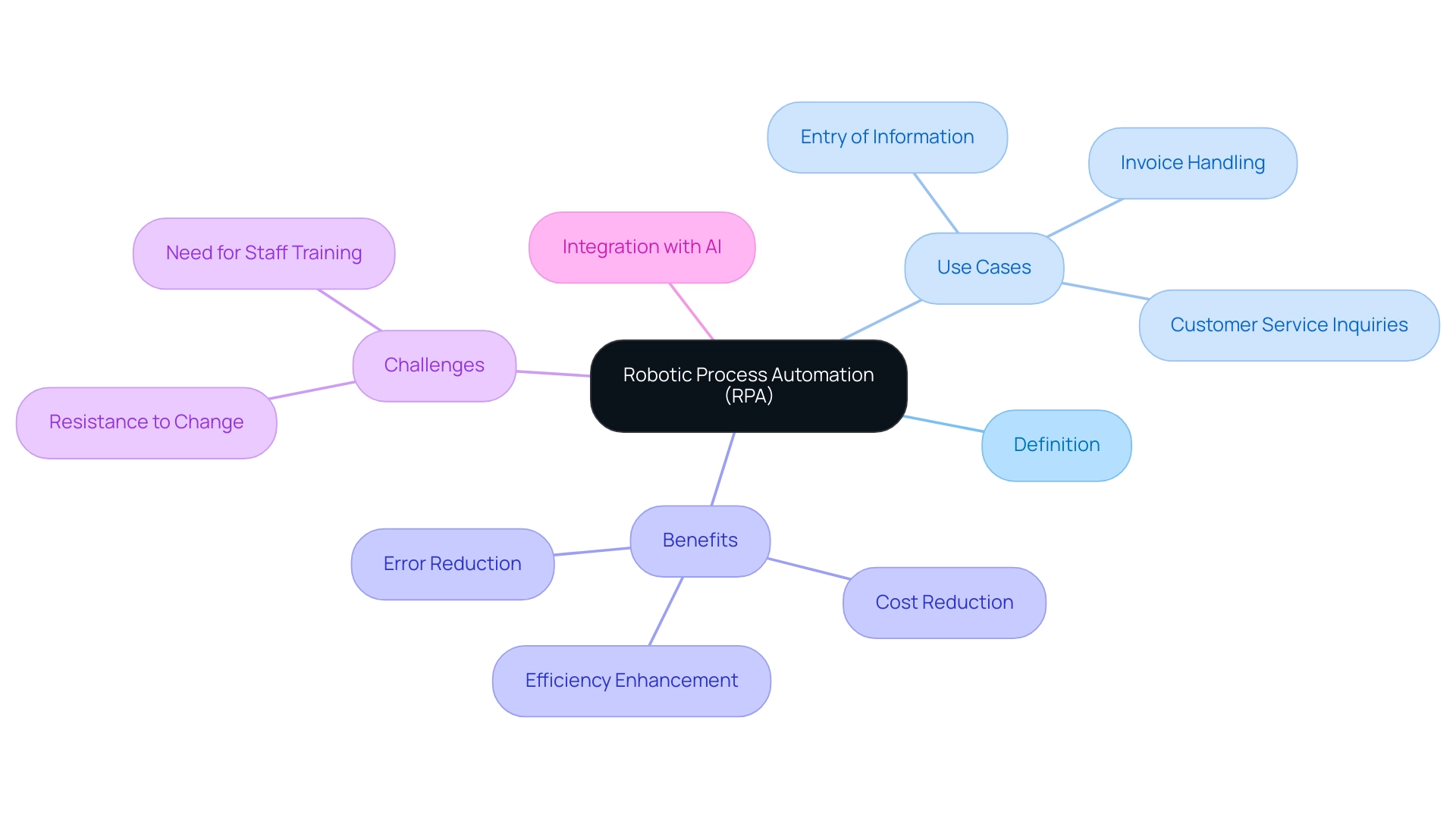
Transformative RPA Use Cases in IT: A Closer Look
-
Automated Information Migration: Automating information migration is a prevalent application of Robotic Process Automation (RPA) and serves as one of the key RPA use case examples within IT, especially during system upgrades or integrations. By deploying innovative tools like EMMA RPA and Microsoft Power Automate to facilitate the transfer of information from legacy systems to modern platforms, organizations can significantly reduce downtime and minimize errors, leading to a seamless transition. This system not only conserves valuable time but also enhances the accuracy of data, ensuring that information remains reliable throughout the migration process. The RPA market is anticipated to attain $50.50 billion worldwide by 2030, highlighting the increasing significance of intelligent systems in these processes.
-
Incident Management: RPA use case examples illustrate how it can revolutionize incident management by streamlining processes such as ticket creation and resolution. By automating the monitoring of systems for issues, bots can generate tickets and execute predefined scripts to address common problems. This leads to faster response times and alleviates the workload on IT teams, allowing them to focus on more complex challenges. As Alan Hester, president of Nividous, notes, ‘RPA is a proven solution for enhancing operational efficiency and addressing real-world business challenges.’
-
User Provisioning: The mechanization of user provisioning processes is an important RPA use case example, enabling IT departments to effectively manage user accounts and access rights. By automating the onboarding process, bots can create user accounts across various systems and assign the necessary permissions. This not only enhances operational efficiency but also bolsters security and compliance, ensuring that access is appropriately controlled.
-
Report Generation: RPA use case examples demonstrate its ability to automate the generation of IT reports by extracting data from diverse sources and compiling it into standardized formats. This system not only saves time but also ensures the consistent and precise generation of reports, offering valuable insights that inform decision-making processes.
-
Software Testing: In the realm of software development, RPA use case examples illustrate how it can play a crucial role by automating repetitive testing tasks. Bots are capable of executing test cases, logging results, and reporting defects, which significantly reduces the time required for testing cycles and enhances software quality. This system enables faster releases and enhanced reliability in software products.
-
Case Study – Eyecare Practice: This eyecare practice serves as an example of RPA use case examples by automating its claims processing using the Nividous platform. This initiative saved over 37,000 hours annually and reduced the claim-to-cash time period by nine days, demonstrating the tangible benefits of RPA in real-world applications. By implementing such solutions, businesses can overcome the challenges posed by outdated systems, such as inefficiencies and high error rates, and achieve enhanced efficiency and productivity. RPA directly addresses task repetition fatigue and staffing shortages, enabling companies to optimize their workforce and concentrate on strategic initiatives.
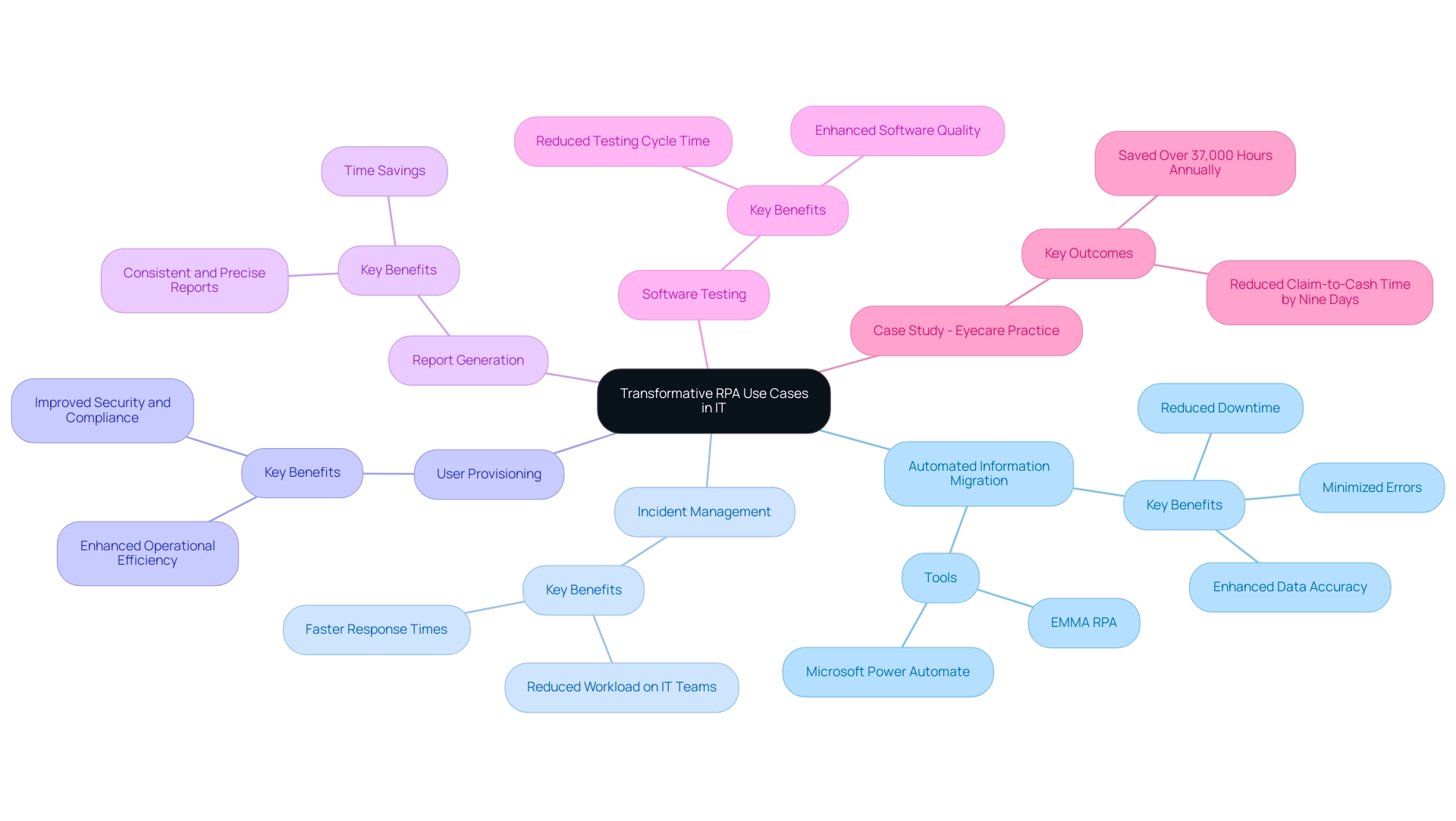
Enhancing Customer Service through RPA
-
Chatbots for Customer Support: The integration of RPA with AI-powered chatbots is revolutionizing customer support by efficiently managing inquiries. These advanced bots provide instant responses to frequently asked questions, schedule appointments, and troubleshoot common issues, drastically reducing wait times and operational costs. Companies are witnessing significant improvements in customer satisfaction levels as a result. According to a recent survey, 98% of IT leaders believe that RPA use case examples for automating business processes, such as customer support, are essential for driving substantial business benefits and reducing operational expenses.
-
Order Processing Automation: Streamlining order processing workflows through RPA is a game changer for operational efficiency and cost reduction. By automating the entry of customer orders into the system, bots can seamlessly extract order details from emails or online forms, validate this information, and update inventory systems. This automation not only accelerates order fulfillment but also enhances accuracy, minimizing the risk of errors. Real-world implementations and RPA use case examples have shown that RPA contributes to a remarkable 40% increase in overall operational efficiency, with a return on investment typically realized within six months, demonstrating significant cost savings.
-
Feedback Management and Compliance Reporting: RPA plays a crucial role in automating the collection and analysis of customer feedback, empowering businesses to proactively address customer needs. By gathering feedback from various channels and compiling it into comprehensive reports, RPA enables teams to respond to critical issues swiftly. This capability ensures continuous service quality improvement, fostering a customer-centric approach that drives loyalty and satisfaction. Additionally, as compliance requirements grow, RPA use case examples illustrate how RPA aids entities in monitoring adherence to regulations, particularly in compliance reporting. This helps reduce the risk of fines or breaches and expedites compliance processes, as highlighted in case studies where RPA has effectively monitored compliance requirements as organizations scale. Furthermore, RPA can help modernize outdated systems, ensuring that businesses remain competitive and responsive to changing market demands.
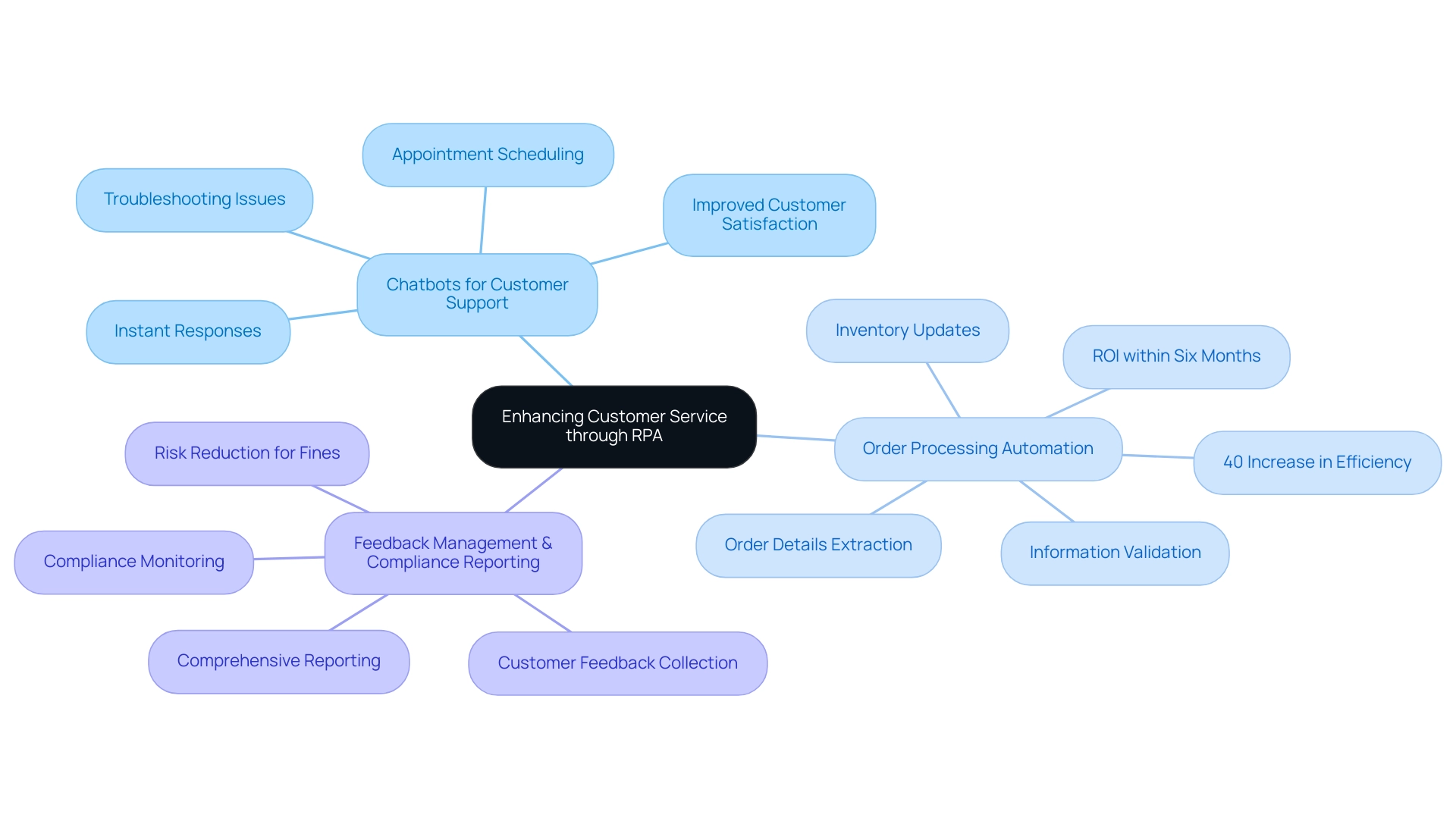
RPA in Finance: Streamlining Processes
-
Invoice Processing: RPA transforms the invoice processing workflow by automating tasks from information extraction to final approval. Intelligent bots can efficiently read invoices, validate data against purchase orders, and seamlessly route them for approval. This automation not only significantly reduces processing time but also minimizes the likelihood of errors. A notable example of RPA use case examples is SMC, which achieved an impressive 70% touchless ratio in their invoice processing within just four months of deploying RPA. Furthermore, the Aberdeen Group highlights the potential for companies to cut up to 65% of invoicing costs and reduce processing times by an average of 12 days simply through the adoption of automated invoice solutions. By redistributing administrative resources, entities can enable staff to concentrate on strategic tasks instead of manual information entry, thus improving overall productivity. Additionally, leveraging Business Intelligence through RPA can provide insights that drive data-driven decision-making, further optimizing financial processes.
-
Expense Management: The automation of expense report processing enables organizations to streamline reimbursements and enhance compliance with internal policies. RPA can extract information from receipts, categorize expenses, and route reports for approval, ensuring timely payments and adherence to company guidelines. This efficiency not only accelerates the reimbursement process but also improves employee satisfaction by minimizing delays. Furthermore, automated invoice processing software often includes built-in analytics capabilities that provide insights into cash flow and budgetary requirements, which are important RPA use case examples that support better financial strategies and informed decision-making for future business planning.
-
Regulatory Compliance: RPA plays a critical role in ensuring adherence to financial regulations by automating information collection and reporting processes. Bots can systematically gather necessary documentation and generate compliance reports, thereby reducing the risk of human error and enhancing audit readiness. When selecting invoice processing software, it is essential to take into account factors such as scalability, integration with existing tools, advanced functionality, and security measures to ensure successful implementation. Addressing these technology implementation challenges is vital for maximizing the efficiency and effectiveness of RPA solutions.
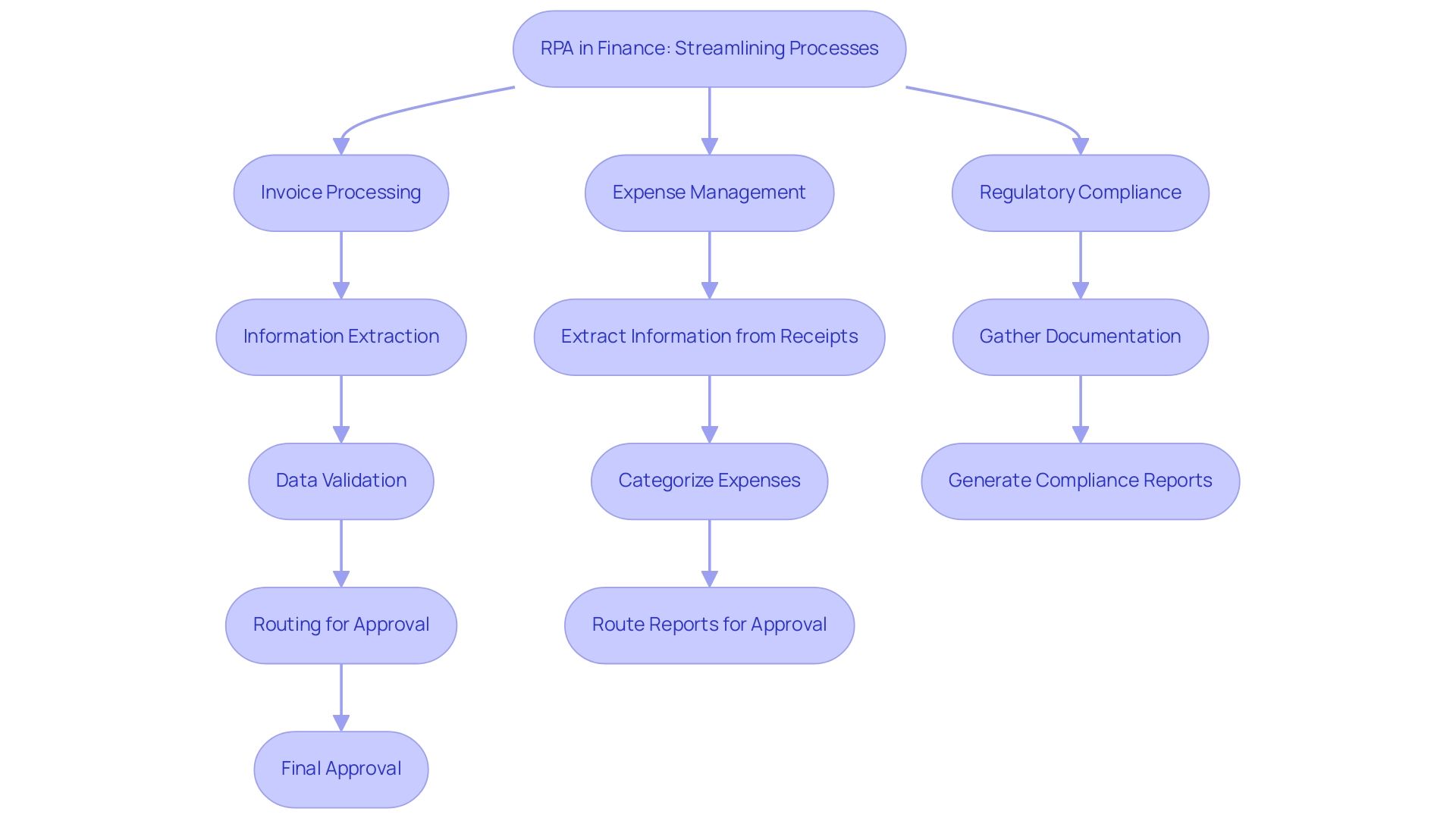
Future Trends in RPA Adoption
-
Integration with AI and Machine Learning: The future of Robotic Process Automation (RPA) is increasingly intertwined with AI and machine learning technologies. This powerful integration enables bots to examine information patterns, learn from prior actions, and make informed decisions independently. As Michał Rejman, Chief Marketing Officer at Flobotics, states,
For Sicoob, the objective of RPA implementation was threefold: to reduce errors, save time, and free up employees so that they can focus on high-value tasks.
Such capabilities not only enhance operational efficiency but also significantly reduce reliance on human intervention, allowing teams to concentrate on strategic initiatives. Moreover, the incorporation of AI enhances RPA’s ability to monitor and schedule regular backups, which is crucial for improving security and ensuring easy recovery. This integration exemplifies how tailored AI solutions can help navigate the rapidly evolving AI landscape, ultimately driving business growth and innovation. -
Increased Focus on Analytics: With the growing adoption of RPA, organizations are placing a heightened emphasis on analytics to gauge the success of their efficiency initiatives. By utilizing comprehensive information insights, businesses can enhance their processes, assess performance metrics, and reveal new opportunities for mechanization. This data-driven approach facilitates continuous improvement and empowers teams to make informed decisions that drive efficiency and productivity, underscoring the importance of Business Intelligence in any automation strategy.
-
Expansion into New Industries: Historically, RPA use case examples have been primarily found in sectors like finance, HR, and IT. However, its reach is set to expand into new industries, including healthcare and manufacturing, which will provide numerous RPA use case examples. As organizations acknowledge the substantial advantages provided by RPA—such as Sicoob’s reported 10-20% cost savings from automating information entry—they are eager to automate diverse processes across various functions. A practical example of this is the case study titled ‘Automated Data Backup and Recovery,’ which demonstrates how RPA can monitor and schedule regular data backups, ensuring easy recovery and enhancing data security. Furthermore, as businesses navigate the complexities of the AI landscape, they often struggle to identify the right tailored solutions that align with their specific needs. This trend will foster widespread adoption and innovation as companies embrace RPA to enhance their operational capabilities, ultimately leading to improved employee morale and operational success.

Conclusion
Robotic Process Automation (RPA) is reshaping the operational landscape for businesses across various sectors, offering significant advantages in efficiency, accuracy, and cost reduction. By automating repetitive tasks such as data entry, invoice processing, and customer service inquiries, organizations can not only streamline their workflows but also free up valuable employee time for more strategic initiatives. The integration of tailored AI solutions further enhances RPA’s capabilities, enabling deeper insights and better decision-making.
The transformative use cases of RPA, particularly in IT, finance, and customer service, highlight its versatility and effectiveness. From automating data migration and incident management in IT to revolutionizing invoice processing and expense management in finance, the benefits are clear. These improvements not only lead to substantial operational efficiencies but also empower organizations to adapt to ever-changing market demands and regulatory requirements.
As businesses look to the future, the continued integration of RPA with AI and machine learning will unlock even greater potential, driving innovation and operational excellence. With a growing focus on analytics and expansion into new industries, the adoption of RPA is set to become a cornerstone of competitive advantage. Embracing this technology will position organizations to thrive in an increasingly automated world, making it essential for leaders to prioritize RPA as a strategic initiative for sustained growth and success.
Introduction
In a landscape where efficiency and innovation are paramount, Robotic Process Automation (RPA) emerges as a game-changer for organizations striving to enhance operational performance. By automating repetitive tasks across various functions—from finance to customer service—RPA not only reduces costs but also allows teams to redirect their focus toward strategic initiatives that drive growth. As businesses grapple with staffing shortages and the demands of an ever-evolving market, the integration of RPA tools like EMMA RPA and Microsoft Power Automate presents a compelling solution.
This article delves into the transformative benefits of RPA, its diverse applications, and the challenges organizations may face during implementation, offering practical insights for those ready to embrace a more efficient future.
Key Benefits of Robotic Process Automation (RPA)
Robotic Process Automation (RPA) presents several advantages that can transform business operations, particularly through innovative tools like EMMA RPA and Microsoft Power Automate. These solutions specifically address challenges such as task repetition fatigue and staffing shortages, which are prevalent in many enterprises. The advantages of RPA include:
- Cost-Effectiveness: RPA significantly reduces operational costs by automating repetitive tasks, allowing organizations to allocate resources more efficiently.
- Accuracy: Automation reduces human mistakes, resulting in enhanced precision in handling and processing.
- Enhanced Productivity: RPA allows employees to concentrate on higher-value tasks, improving overall productivity and effectiveness in workflows.
For example, a case study demonstrated that a mid-sized company enhanced productivity by automating data entry and software testing, achieving a 70% reduction in data entry mistakes and a 50% speedup in testing processes.
4. Scalability: Organizations can easily scale RPA solutions to meet changing business needs without the need for extensive re-training of staff.
5. Compliance and Audit Trails: Automated processes ensure adherence to regulations and provide detailed audit trails, enhancing transparency and accountability.
The advantages of RPA collectively contribute to improved operational performance and competitiveness in the market, particularly in overcoming outdated systems and enhancing employee morale. The visual representation of RPA solutions further emphasizes their user-friendly nature and the collaborative potential between humans and machines.

Applications of RPA Across Different Business Functions
RPA can be applied across a variety of business functions, effectively addressing common workplace challenges and enhancing productivity:
- Finance and Accounting: Automating invoicing, reconciliation, and financial reporting processes to reduce errors and save time.
- Human Resources: Streamlining employee onboarding, payroll processing, and benefits administration, helping retain talent by improving employee satisfaction and reducing exhaustion from repetitive tasks.
- Customer Service: Enhancing response times through automated ticketing and inquiry handling, leading to better customer experiences.
- Supply Chain Management: Optimizing order processing, inventory management, and vendor communications to keep operations running smoothly.
- IT Services: Automating routine IT support tasks, such as password resets and system monitoring, freeing up IT staff for more strategic initiatives and modernizing outdated systems.
These applications illustrate the advantages of RPA, as they combat repetitive tasks, improve staffing productivity, and modernize outdated systems, thereby enhancing overall operational performance in a rapidly evolving AI landscape.
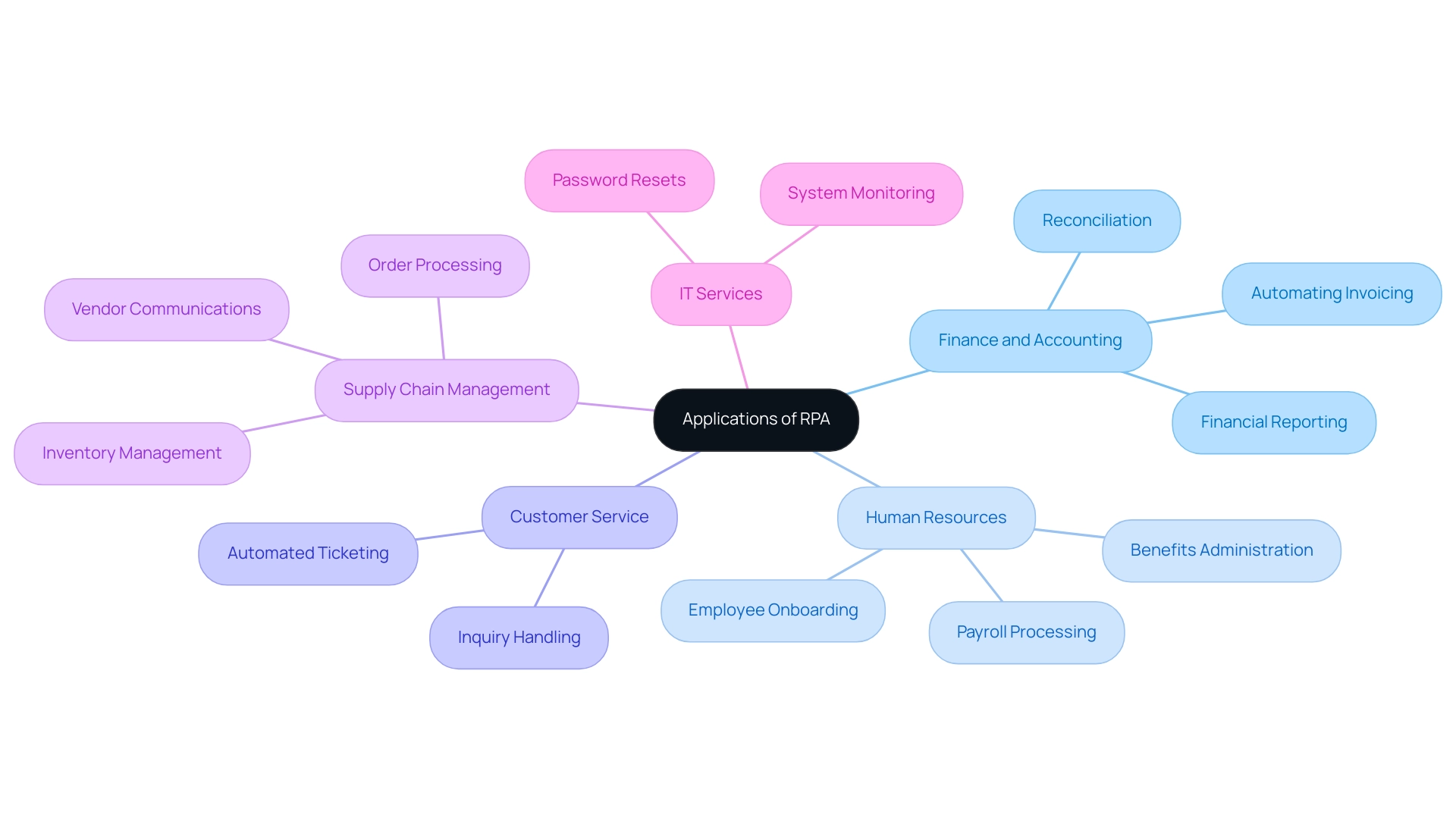
Enhancing Productivity and Customer Satisfaction with RPA
The advantages of RPA include significantly enhancing productivity by automating mundane tasks, which enables employees to focus on strategic initiatives and innovation. For instance, by automating regular data input, your team can focus their efforts on innovative problem-solving, thereby promoting growth and productivity within the entity. Additionally, the advantages of RPA include contributing to cost reduction by minimizing the resources required for manual processes, which allows for better allocation of budgets towards innovation and growth. Moreover, the advantages of RPA also extend to boosting customer satisfaction by ensuring faster response times and consistent service quality.
- Automated systems efficiently process customer requests, minimizing wait times and elevating the overall customer experience.
- Organizations that adopt RPA frequently report notable increases in customer loyalty, attributed to enhanced service delivery and responsiveness.
- To further enhance operational efficiency, integrating tailored AI solutions and Business Intelligence can provide deeper insights and analytics, enabling informed decision-making that leverages the advantages of RPA.
Addressing the challenges of technology implementation, RPA serves as a foundational step towards a more agile and responsive operational framework.
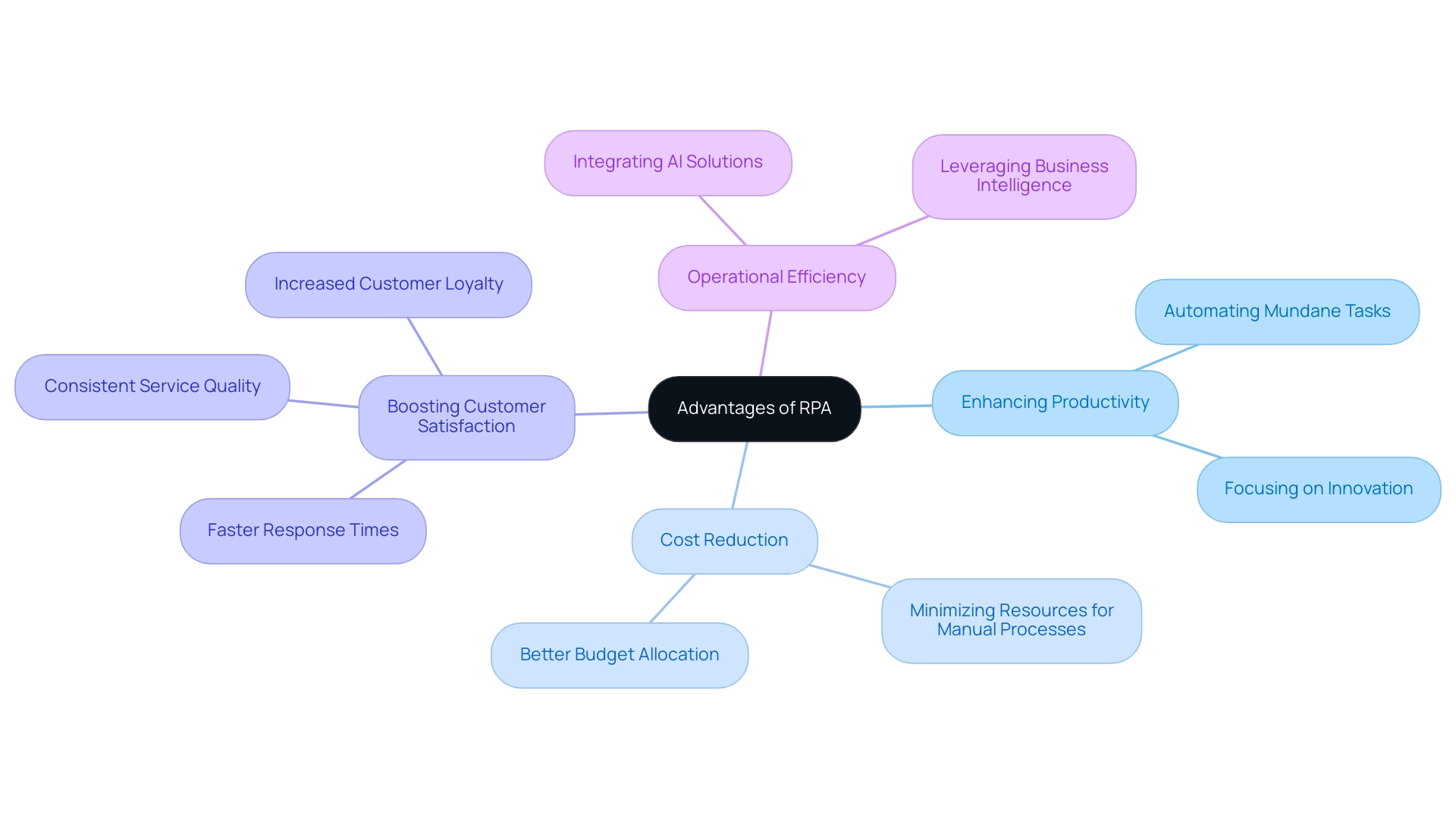
Integration and Analytics: How RPA Streamlines Operations
Robotic Process Automation (RPA) stands out as a powerful tool for integrating with existing systems, allowing organizations to effectively streamline operations across various platforms. AIMultiple informs hundreds of thousands of businesses, including 55% of Fortune 500 companies every month, underscoring the widespread relevance of RPA. By linking disparate systems, RPA reconciles information from multiple sources, ensuring both consistency and accuracy in reporting, which is essential for driving insights based on information.
A powerful advantage of RPA is the advantages of RPA in enhancing analytics capabilities through the automation of data collection and processing. This results in organizations deriving actionable insights more efficiently, empowering informed decision-making and strategic planning. For instance, automated reporting tools can now generate real-time insights, significantly facilitating operational efficiency.
As AIMultiple mentions, while relatively straightforward checks like information type validation can be carried out automatically in databases, more intricate validation that incorporates business rules can be programmed using RPA. This capability means that businesses can implement intricate validation processes, such as monitoring customer usage restrictions based on subscription types, all managed seamlessly by RPA bots. Moreover, RPA enhances treasury management by automating accounts reconciliation and risk forecasting, providing a broader perspective on its capabilities.
In the Telematics case study, RPA enables automated updates and information exchanges in vehicles leveraging Android Automotive OS, resulting in enhanced functionality and security features in automotive applications. Such innovations not only improve operational efficiency but also enrich customer data, ultimately leading to enhanced customer insights and better overall performance. Furthermore, as companies adopt RPA, they often encounter challenges in identifying the right AI solutions that align with their specific needs.
However, by automating repetitive tasks, the advantages of RPA become evident as it frees up teams for more strategic, value-adding work, thereby enhancing employee morale and productivity.
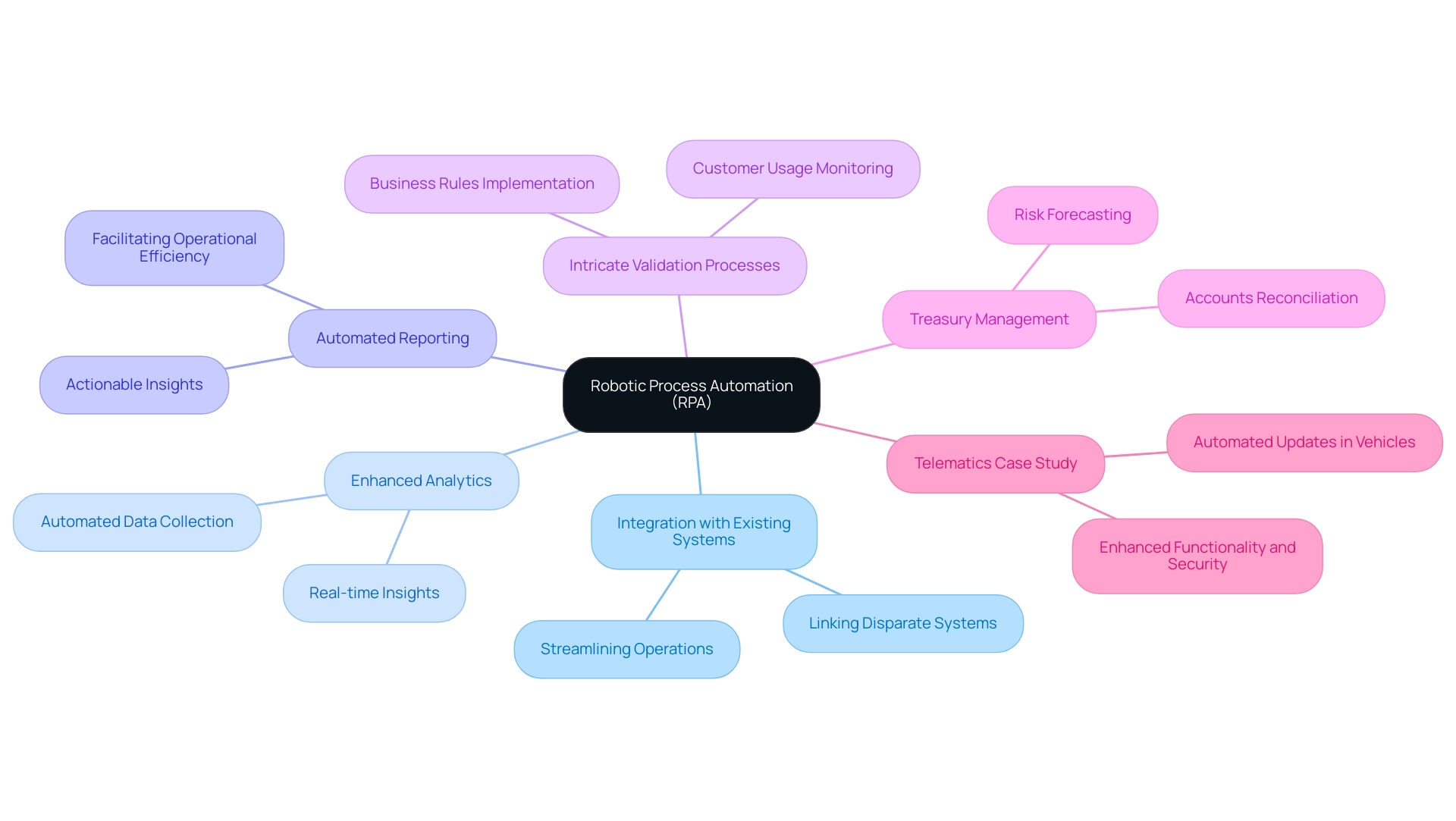
Challenges and Considerations in RPA Implementation
While Robotic Process Automation (RPA) offers substantial benefits for organizations, it is essential to navigate potential challenges during implementation:
- Change Management: Employee resistance can be a significant hurdle to RPA adoption. As highlighted by Minna Mary Saji, a content developer specializing in RPA, effective communication and comprehensive training are vital for fostering acceptance and ensuring team members embrace new systems. This underscores the importance of change management in achieving successful RPA integration.
- Initial Costs: Understanding the costs associated with RPA implementation is critical for optimizing strategy and securing a competitive edge. The upfront investment in RPA technology and training can be significant. Organizations must engage in meticulous budgeting and strategic planning to manage these initial costs effectively. Notably, recent reports in the financial services sector indicate that firms have achieved an 80% reduction in process time after automating data entry, which demonstrates the advantages of RPA and showcases the potential for a clear return on investment.
- Integration Complexity: The technical challenges of ensuring smooth integration between RPA tools and existing systems can be daunting. Prioritizing compatibility assessments and potentially investing in custom solutions is crucial for streamlining this process. A relevant case study, “Beyond the Envelope: Steering Digital Transformation in Postal Services,” illustrates how postal companies are adapting to eCommerce demands while addressing integration challenges.
- Ongoing Maintenance: Maintaining RPA systems requires continuous monitoring and resource allocation to ensure automated processes function correctly and adapt to changes in business operations.
Our approach ensures that you only pay if we deliver the promised results, mitigating the ROI risk associated with automation. By incorporating customized AI solutions with RPA, companies can further improve productivity and informed decision-making.
By proactively addressing these challenges, organizations can not only mitigate risks but also maximize the advantages of RPA, thereby paving the way for successful implementations that enhance efficiency and drive innovation.
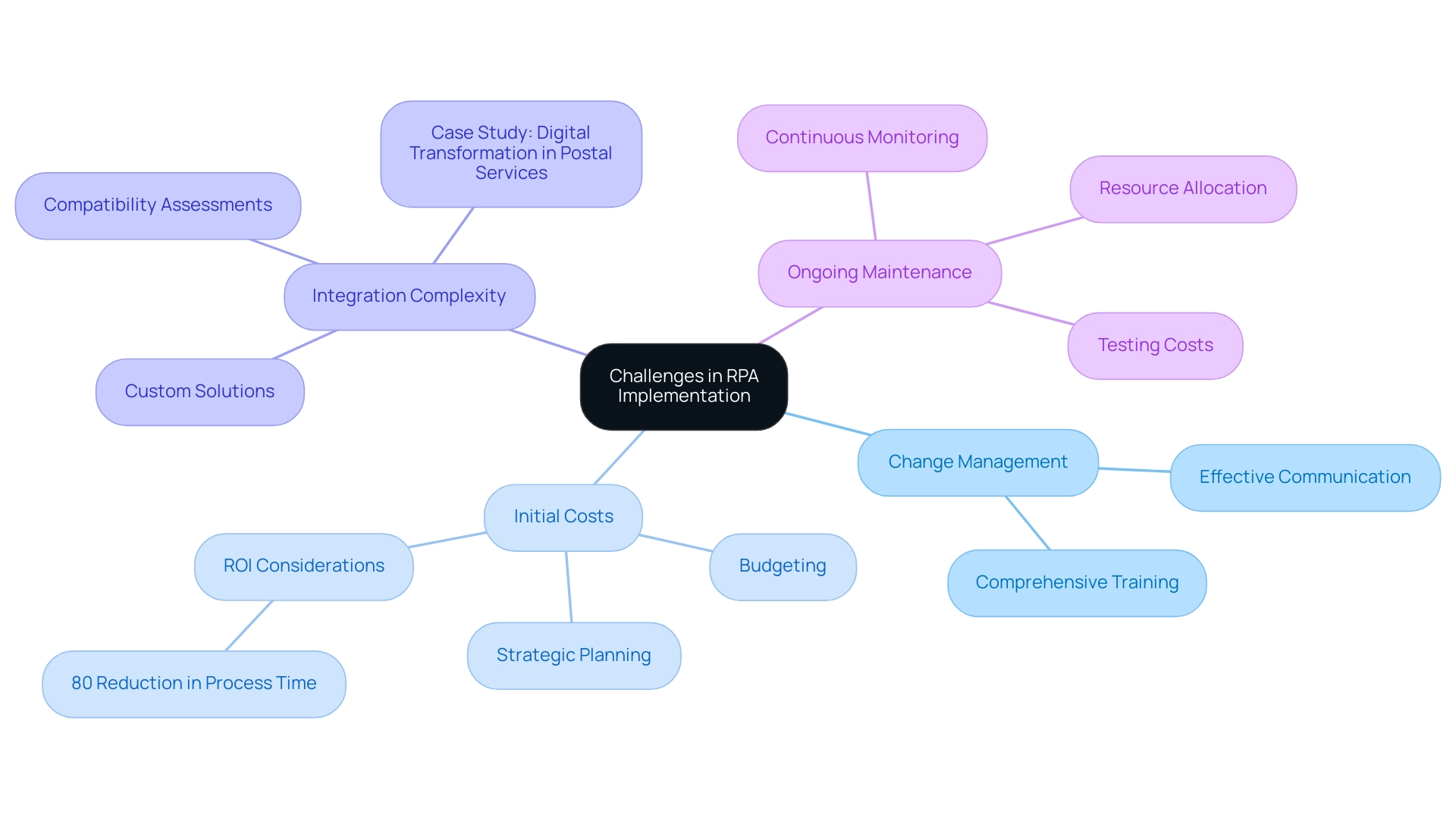
Conclusion
Integrating Robotic Process Automation (RPA) is essential for organizations aiming to boost efficiency and maintain competitiveness. By automating repetitive tasks, RPA provides substantial benefits such as cost savings, enhanced accuracy, and increased productivity, allowing teams to concentrate on strategic initiatives that drive growth.
RPA’s adaptability is showcased across various functions, including finance, human resources, customer service, supply chain management, and IT services. This versatility not only streamlines operations but also improves customer satisfaction and creates a more agile business environment. Furthermore, RPA’s capability to integrate with existing systems enhances data-driven decision-making, amplifying its overall impact.
However, successful implementation of RPA entails overcoming challenges related to change management, initial costs, integration complexities, and ongoing maintenance. Addressing these obstacles is crucial for fully realizing RPA’s benefits and fostering a culture of innovation.
Ultimately, adopting RPA is about transforming operational efficiency and empowering teams to focus on value-added activities. As businesses face staffing shortages and dynamic market demands, RPA emerges as a critical solution, enabling organizations to alleviate the burdens of repetitive tasks and prioritize innovation. Embracing automation is key to achieving operational excellence and creating a more responsive workplace for the future.
Introduction
In an age where data breaches dominate headlines and privacy concerns escalate, organizations are compelled to adopt stringent measures to protect sensitive information. Row-Level Security (RLS) emerges as a crucial solution, enabling businesses to control data access at an unprecedented level of granularity. By ensuring that users only access data pertinent to their roles, RLS not only fortifies compliance with evolving regulations but also enhances overall data governance.
As industries grapple with the complexities of cybersecurity, understanding and implementing RLS can transform how organizations safeguard their most valuable assets. This article delves into the fundamentals of RLS, its myriad benefits, technical insights, practical applications, and the challenges organizations face in its implementation, providing a comprehensive guide for those looking to bolster their data security frameworks.
Defining Row-Level Security: An Overview
Row-level security (RLS) is a vital database protection feature that ensures users can only access information they are specifically authorized to view, thereby effectively restricting information retrieval at the row level. This capability is essential in settings managing sensitive information, as it reduces the risks presented by unauthorized entry. For example, as highlighted by American politician Marco Rubio, former employees holding onto sensitive company information can create significant vulnerabilities, emphasizing the urgent need for strong information management.
In today’s digital environment, where customer discontent can spread across social networks—potentially reaching 6,000 acquaintances per dissatisfied client—organizations must prioritize information protection to uphold their reputation and trust. Row-level security (RLS) operates by implementing policies that filter information based on user roles or characteristics, resulting in customized views that align with individual privileges. This level of granularity not only fortifies compliance with protection regulations but also enhances overall governance.
The case study titled ‘Data Access Risks’ illustrates how organizations have faced security vulnerabilities due to inadequate access controls, emphasizing the need for strict measures. By implementing row-level security, organizations can maintain the integrity and confidentiality of their sensitive information, thereby protecting against potential breaches and ensuring a secure operational environment.
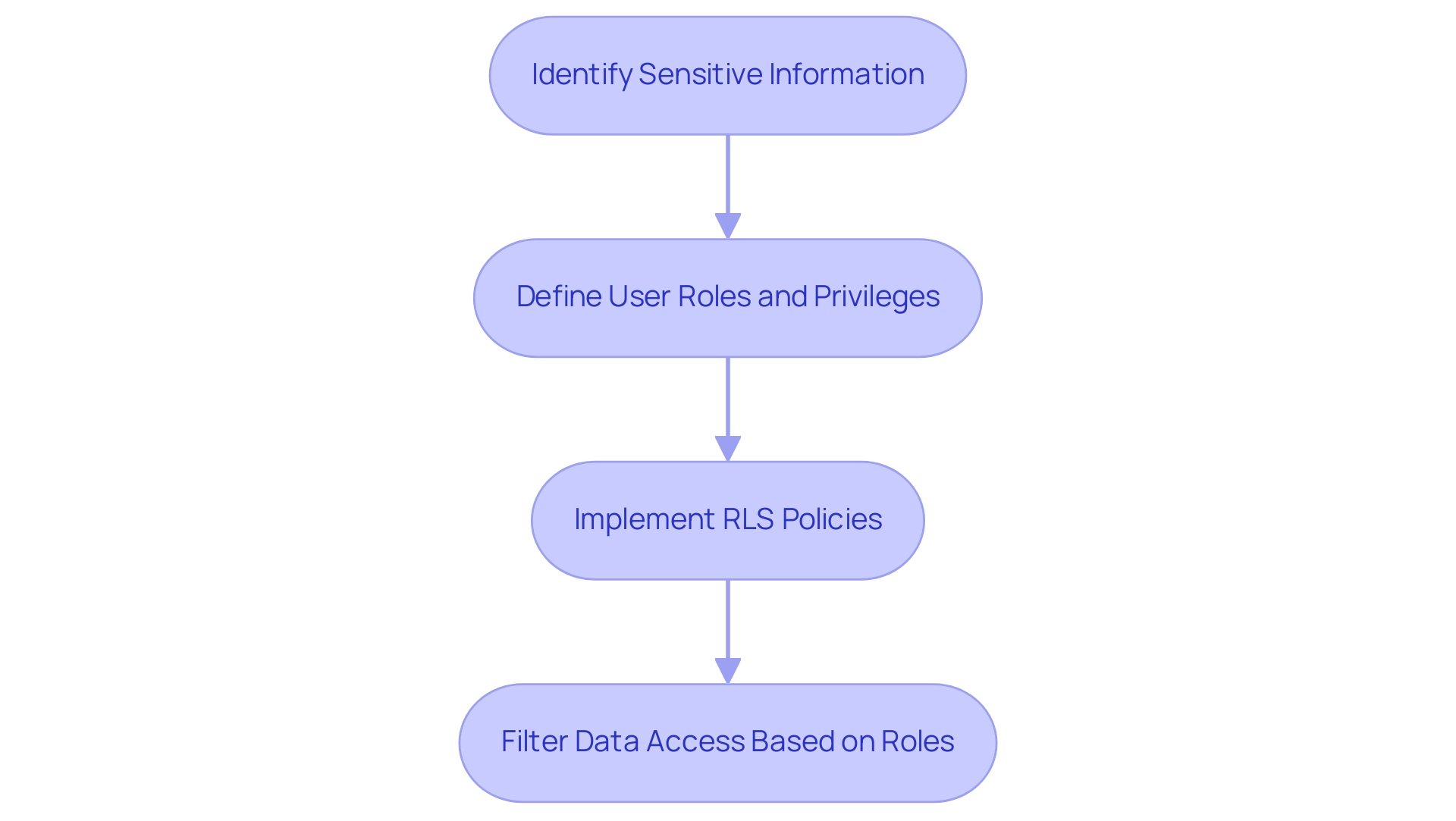
The Benefits of Implementing Row-Level Security in Databases
Implementing row-level security in databases offers significant benefits that extend beyond fundamental protection. It not only strengthens information security by implementing row-level security to ensure that users retrieve only the details pertinent to their roles, but it also plays a crucial part in enhancing adherence to regulations such as GDPR and HIPAA. In 2023, the education sector encountered over 700,000 cybersecurity threats, with ransomware attacks more than doubling since 2021, resulting in an average breach cost of $3.7 million.
These concerning statistics emphasize the immediate necessity for efficient information control mechanisms. Organizations that implement row-level security (RLS), alongside Robotic Process Automation (RPA) and Business Intelligence (BI), can reduce the risk of information breaches and unauthorized entry while enhancing operational efficiency. RPA can automate repetitive information management tasks, such as handling user permissions and monitoring access logs, allowing teams to concentrate on strategic initiatives that foster growth.
Furthermore, integrating BI tools transforms raw information into actionable insights, utilizing row-level security to empower informed decision-making. In addition to RLS, strengthening cybersecurity through regular audits, establishing backup systems, and utilizing endpoint protection is essential for comprehensive security. This not only promotes greater accountability and transparency within teams but also aligns with regulatory compliance requirements, simplifying adherence to stringent protection laws.
As noted by industry experts, adopting row-level security significantly enhances operational efficiency. A culture of responsible data management emerges when access is strictly monitored, leading to improved decision-making capabilities and operational agility. In a landscape where organizations with managed service providers experienced a 21% shorter breach lifecycle, the implementation of row-level security (RLS) is a proactive measure to protect sensitive information and strengthen overall organizational resilience.
The education sector’s limited cybersecurity resources make it an appealing target for cybercriminals, and many attacks are preventable through basic protective measures, which highlights the critical role of row-level security in a broader defense strategy.
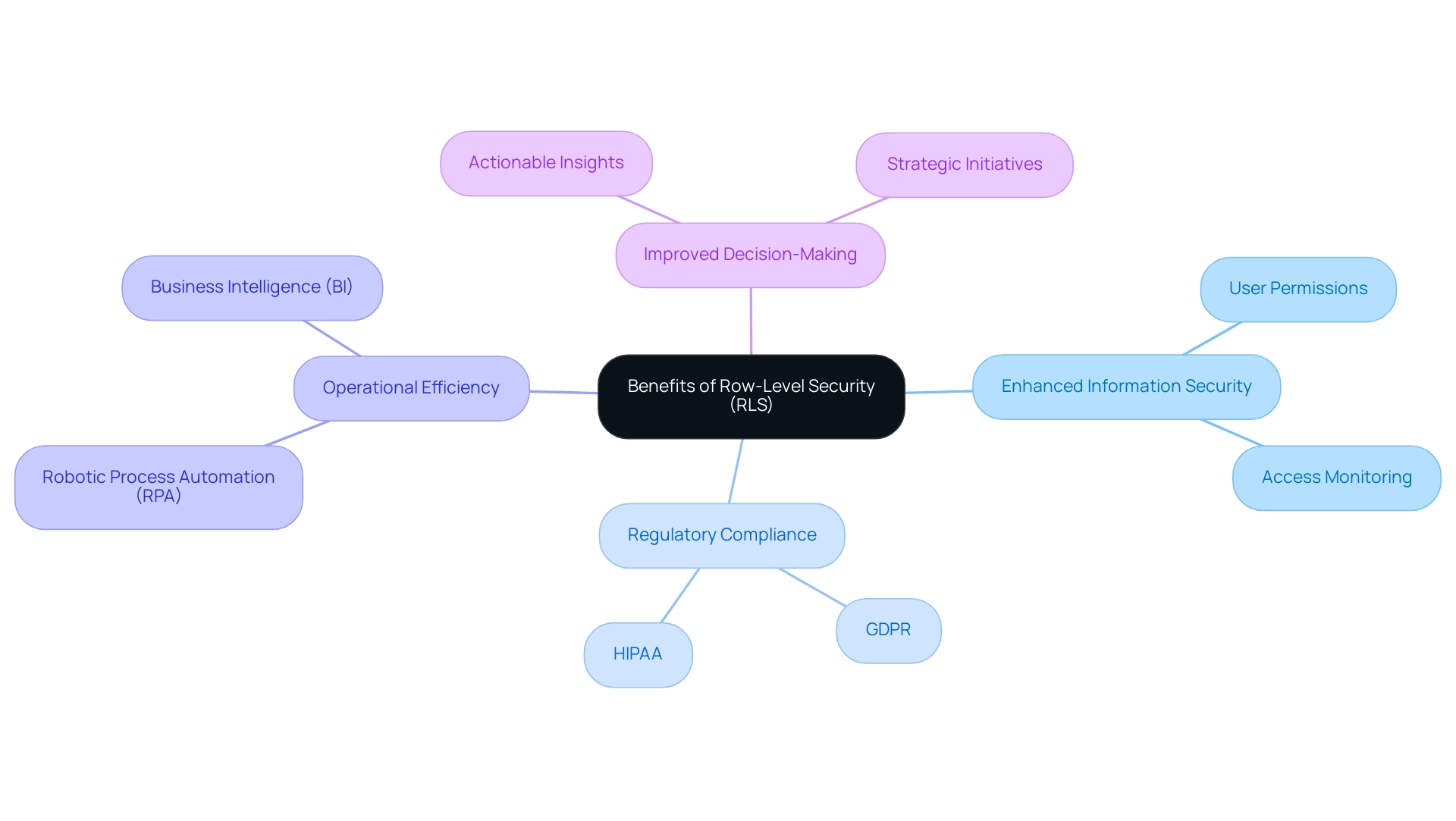
How Row-Level Security Works: Technical Insights
Row-level security (RLS) serves as a crucial approach for managing access to information at a granular level. It is executed through guidelines that specify which rows a user can view, depending on their role or particular attributes, thereby ensuring row-level security. In SQL databases, row-level security (RLS) is typically established using functions designed to return a boolean value, which determines whether a user is permitted to view a particular row.
This is achieved by generating protection criteria that sift information based on user traits. Furthermore, integrating row-level security (RLS) with established database protection measures, such as role-based access control (RBAC), enables organizations to adopt a comprehensive, multi-layered approach to safeguarding. This integration not only enhances data protection but also addresses technical challenges that may arise during the implementation of row-level security.
With over 4 million satisfied learners, DigitalDefynd demonstrates the growing importance of understanding row-level security in today’s data-driven environment. As Eric Raymond aptly stated, ‘Being able to break into systems doesn’t make you a hacker any more than being able to hotwire cars makes you an automotive engineer.’ This emphasizes the necessity for strong protection measures such as row-level security.
Moreover, as the future of cybersecurity will involve regular exercises and assessments mandated by regulators, understanding these technical elements becomes crucial for organizations to effectively leverage row-level security to strengthen their cybersecurity frameworks and meet the evolving demands of privacy and security.
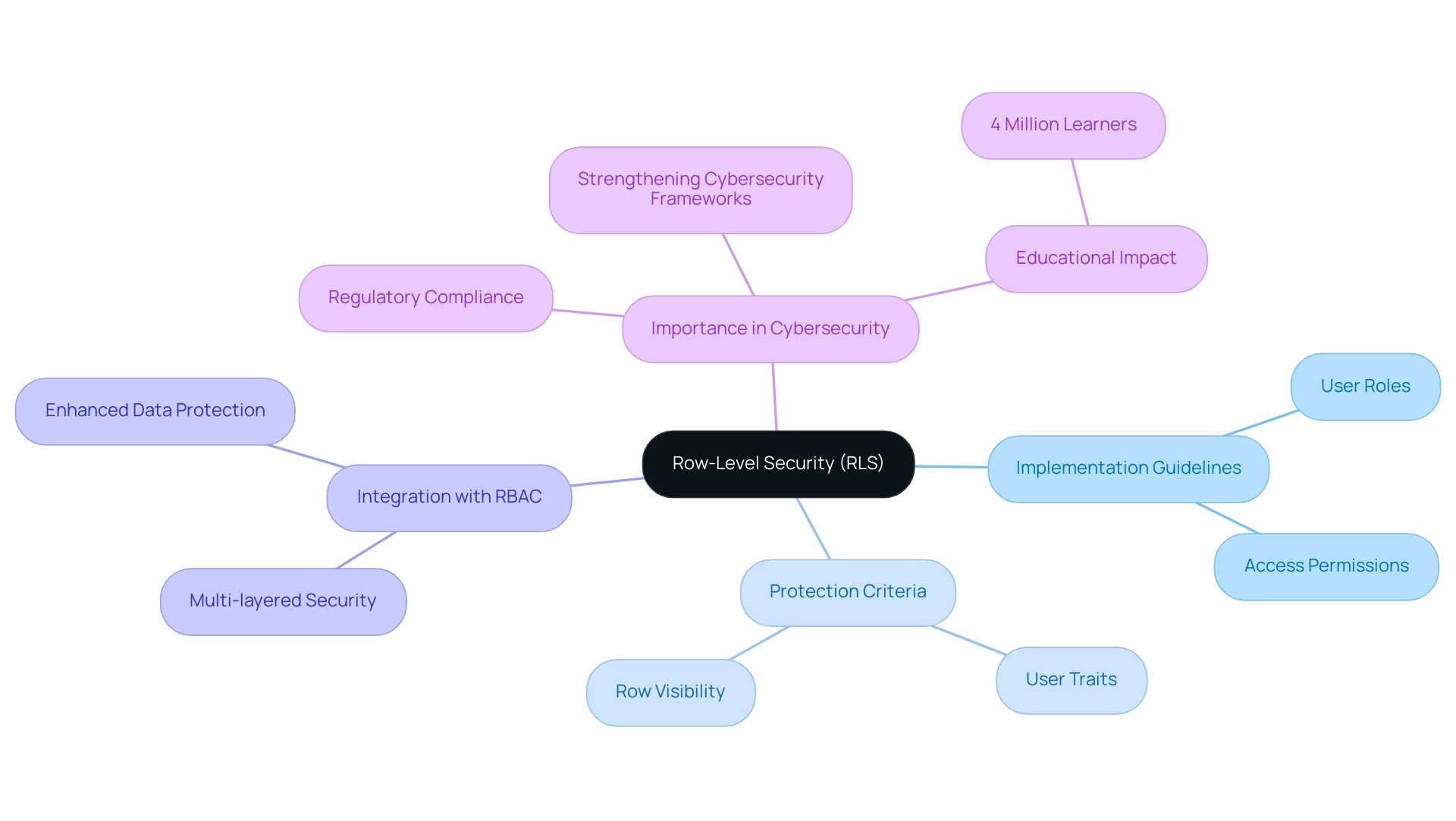
Common Use Cases for Row-Level Security
Row-level security (RLS) is essential for safeguarding sensitive data across various industries, such as healthcare, finance, and education, where confidentiality is of utmost importance. In the healthcare sector, for example, the implementation of row-level security ensures that patient records are accessible solely to authorized medical personnel, thereby upholding patient privacy and adhering to regulatory standards. Real-world applications of RLS in healthcare demonstrate its critical function in protecting patient privacy.
Likewise, in the financial sector, banks and financial institutions utilize row-level security (RLS) to restrict entry to sensitive financial information based on user roles, significantly diminishing the risk of fraud and enhancing compliance with stringent regulations. This flexible approach is highlighted by the fact that RLS policies can be attached to multiple tables, allowing for a scalable implementation tailored to specific needs. Educational institutions can also benefit from row-level security by managing entry to student records, ensuring that only authorized staff members can view sensitive information.
As Ganesh Kirti, founder and CEO of TrustLogix, observes,
The new row-level protection features will enable our clients to accurately specify information control measures based on their business entitlements while abstracting them from the technical complexities.
A practical example of row-level security (RLS) in action is presented in the case study titled ‘Enabling and Disabling Row-Level Security,’ which demonstrates how administrators can dynamically manage information retrieval on specific tables, ensuring adherence to policies. These diverse use cases illustrate the significant impact of row-level security (RLS) in enhancing information security and compliance across various sectors, underscoring its necessity in today’s information-driven landscape.
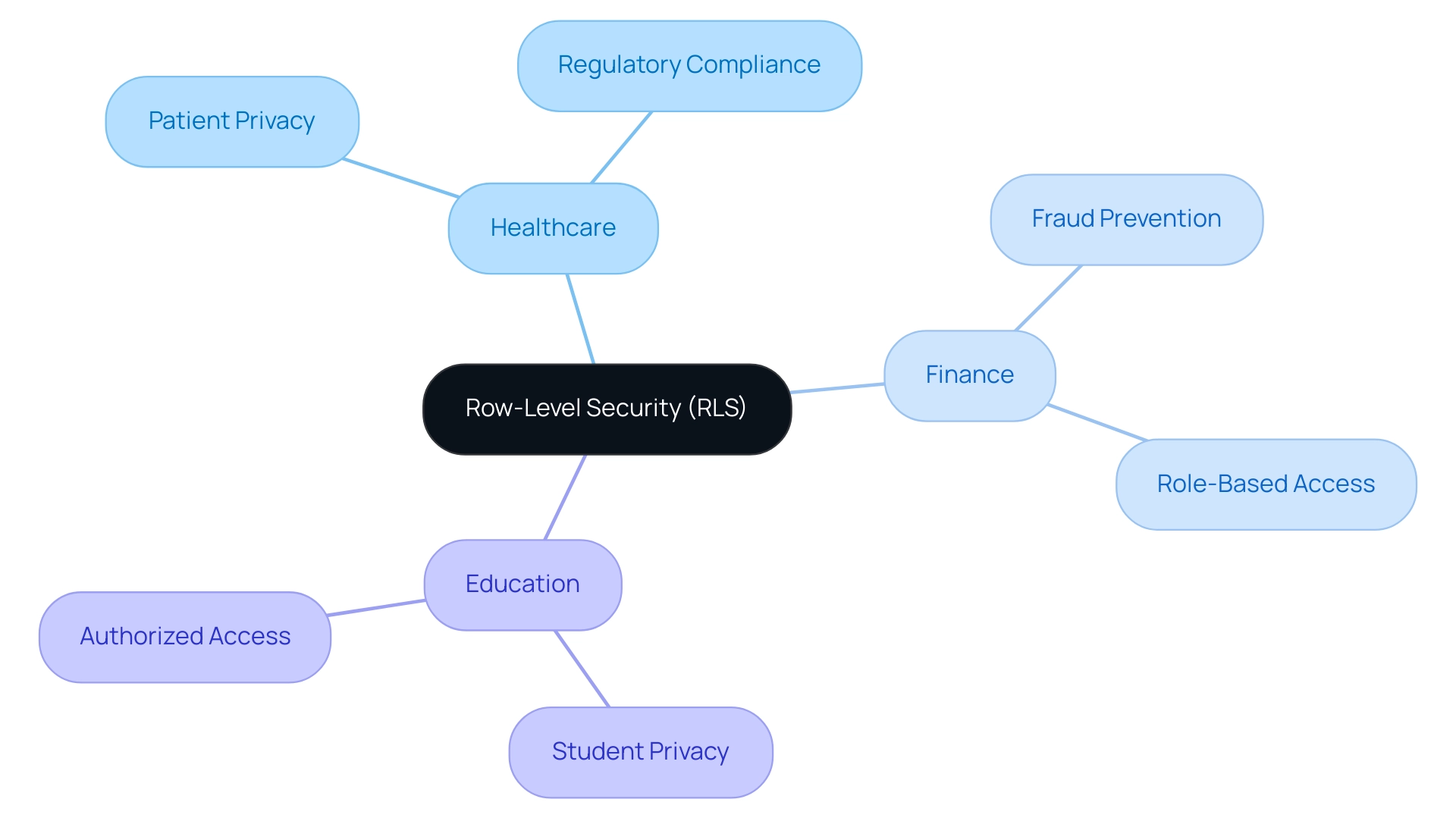
Challenges and Considerations in Implementing Row-Level Security
Implementing row-level security (RLS) provides organizations with numerous advantages, but it also introduces significant challenges that require careful navigation. One significant obstacle is employee opposition, especially from those who are used to unrestricted information availability. Statistics indicate that a significant portion of employees may resist alterations to information retrieval controls, fearing that it could hinder their productivity.
Therefore, robust change management strategies are essential to facilitate a smooth transition to more restricted entry protocols. As highlighted by Lisa Levy, a Content Specialist, ‘While there are many benefits associated with Postgres RLS, in some cases it is difficult to maintain, especially at scale.’ This complexity is heightened in organizations with large and varied datasets, making the implementation of row-level security a challenging endeavor.
Moreover, organizations must ensure GDPR compliance, as RLS alone may not offer sufficient protections like pseudonymization or encryption, raising concerns about information safety. To effectively navigate these challenges, it is crucial for organizations to conduct a thorough examination of their information retrieval requirements prior to implementing row-level security. This ensures that security policies are robust and aligned with the organization’s broader goals.
Moreover, utilizing Robotic Process Automation (RPA) can enhance the management of information retrieval, automating repetitive tasks related to compliance and control, which can ease some of the burdens associated with RLS implementation. Tailored AI solutions can also assist organizations in identifying and addressing specific challenges, ensuring that data protection regulations like GDPR are met. By referencing real-world case studies, organizations can better understand challenges such as coding bottlenecks, conflicts with existing access control measures, and potential performance issues.
Inadequate execution can result in vulnerabilities and decreased database performance. By proactively addressing these challenges with RPA and AI, organizations can leverage row-level security to significantly enhance their data security posture while minimizing disruptions, ultimately fostering a culture of informed decision-making driven by Business Intelligence and operational efficiency enabled by RPA.

Conclusion
Implementing Row-Level Security (RLS) offers organizations a robust framework for safeguarding sensitive data, ensuring that only authorized users can access information relevant to their roles. This granular level of control not only fortifies compliance with critical regulations like GDPR and HIPAA but also enhances overall data governance. The urgency for such measures is underscored by alarming statistics regarding cybersecurity threats, particularly in sectors such as education, healthcare, and finance, where the stakes are exceptionally high.
However, while the benefits of RLS are clear, organizations must navigate several challenges during implementation. Employee resistance to change, the complexity of managing extensive datasets, and ensuring compliance with data protection laws are significant hurdles that require strategic planning and effective change management. Leveraging automation tools like Robotic Process Automation (RPA) can streamline the transition, allowing organizations to focus on their core objectives while maintaining robust security protocols.
Ultimately, the integration of RLS into data security frameworks is not just a technical upgrade; it represents a cultural shift towards responsible data management. By prioritizing RLS, organizations can not only protect their most valuable assets but also foster a culture of accountability and informed decision-making. In a landscape where data breaches can have devastating consequences, the proactive adoption of RLS is essential for building resilience and trust in today’s data-driven world.
Introduction
In the rapidly evolving world of business intelligence, the ability to transform raw data into actionable insights has never been more critical. Power Business Intelligence (BI) courses equip professionals with the essential skills needed to harness the full potential of Microsoft Power BI, a leading tool for data visualization and analytics. As organizations grapple with challenges such as inefficient report creation and inconsistent data, these courses provide practical solutions that empower individuals to streamline processes and enhance decision-making.
By mastering Power BI, participants not only improve their technical acumen but also learn to apply these skills in real-world scenarios, driving operational excellence and fostering a culture of data-driven insights. This article delves into the myriad benefits of Power BI training, the key features that set it apart, and its transformative applications across various industries, ultimately illuminating the path toward informed, agile decision-making in a data-centric landscape.
Introduction to Power Business Intelligence Courses
Business Intelligence (BI) courses, including the power business intelligence course, are structured to provide professionals with the skills needed to utilize Microsoft BI, a robust tool for visualization and business analytics. These courses cover essential concepts of information modeling, reporting, and dashboard creation, enabling users to transform raw information into meaningful insights that drive informed decision-making. In the current environment, where entities encounter obstacles such as lengthy documentation preparation, information discrepancies, and a deficiency of practical guidance, mastering Power BI becomes essential for streamlining operational procedures and improving overall effectiveness.
Specifically, these courses address the common pitfalls of inconsistent information across reports and the absence of a governance strategy, ensuring that participants can create reliable and actionable reports. By participating in the power business intelligence course, individuals not only enhance their technical skills but also learn to apply these skills to real-world business scenarios, empowering them to drive innovation and operational excellence within their organizations.
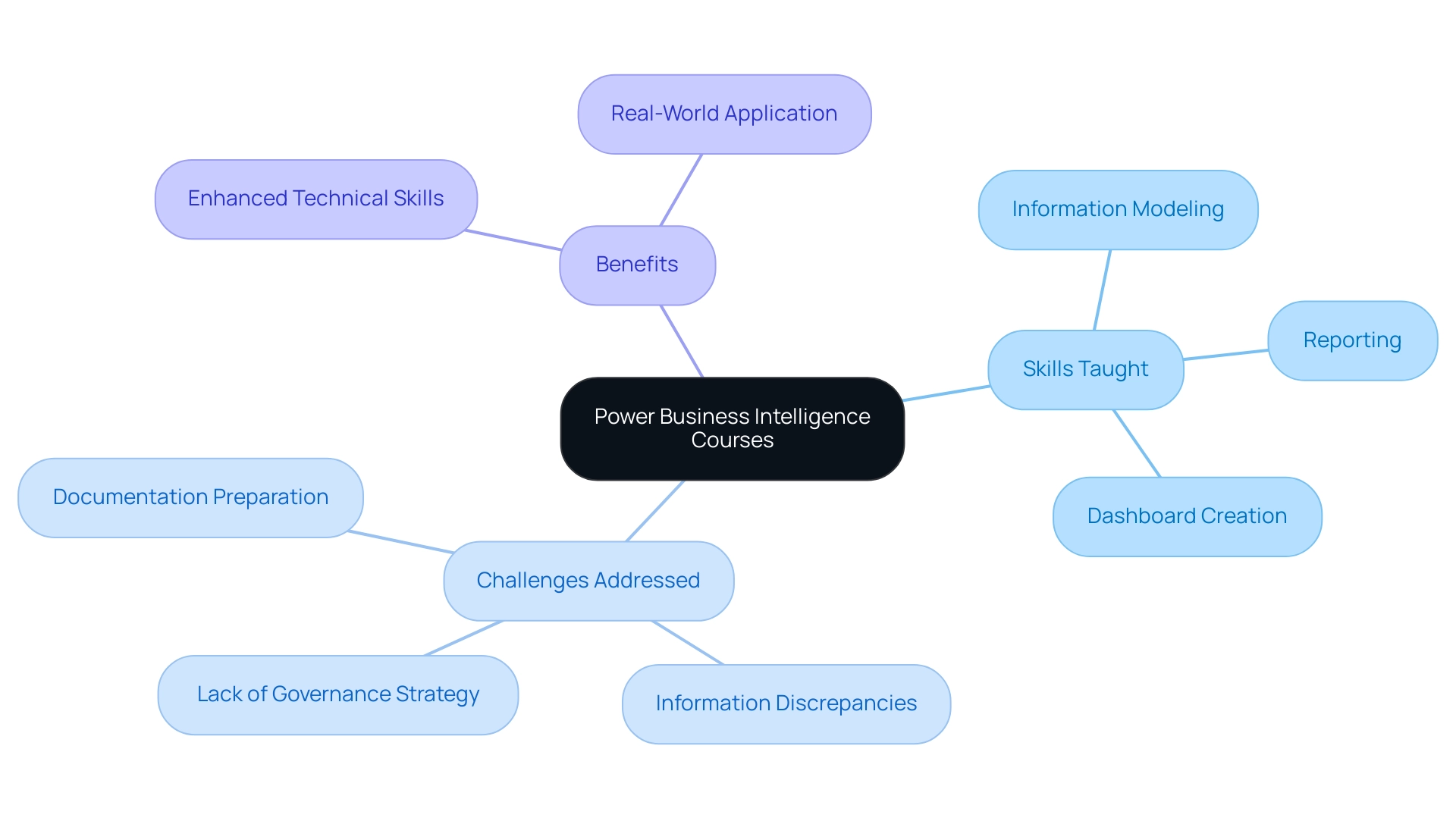
Benefits and Skills Acquired from Power BI Training
Completing a power business intelligence course opens a wealth of opportunities for professionals, significantly enhancing their visualization skills and analytical capabilities. Participants acquire the capability to connect to various information sources, clean and transform information, and utilize DAX (Data Analysis Expressions) for advanced calculations. These competencies enable professionals to present information in a more compelling and insightful manner, fostering a culture of evidence-based decision-making within their organizations.
In the context of today’s rapidly evolving AI landscape, integrating tailored AI solutions alongside Robotic Process Automation (RPA) can further enhance operational efficiency by automating repetitive tasks and providing intelligent insights. As data scientist Hilary Mason emphasizes, ‘the human aspect of analytics is crucial; intuition and questioning play vital roles in interpreting insights beyond mere algorithms.’ This emphasizes the significance of merging human insight with analytical tools, as shown in the case study titled ‘The Human Element in Data Analytics,’ which illustrates how such a combination results in more meaningful interpretations and applications of information.
By mastering Power BI and understanding the challenges of time-consuming report creation and inconsistencies, professionals not only streamline their reporting processes but also reduce the time spent on manual manipulation. RPA specifically tackles these challenges by automating the information gathering and reporting processes, ensuring consistency and accuracy in the information presented. Organizations utilizing the full potential of their information stand to gain significantly—research indicates that businesses are missing out on $5.2 million in revenue due to untapped resources.
Marissa Mayer recommends that companies should begin gathering information as early as possible to gain from its insights, emphasizing the urgency of embracing a power business intelligence course for effective BI training. Consequently, mastering BI, alongside leveraging RPA and tailored AI solutions, positions organizations for agile and informed decision-making, ultimately enhancing their competitive edge in a rapidly evolving landscape.

Understanding Power BI’s Key Features
Power BI is a robust business intelligence tool that is part of the power business intelligence course, distinguished by key features that significantly enhance reporting, efficient reporting, and actionable insights. It facilitates seamless connectivity, allowing users to import information from diverse sources such as Excel, SQL Server, and cloud services. With its powerful information modeling capabilities, professionals can create meaningful relationships between various datasets, leading to deeper analysis.
The intuitive visualization options empower users to present information in a clear and impactful manner, ensuring that insights resonate with stakeholders. Furthermore, BI’s sharing and collaboration features promote efficient teamwork, making insights readily accessible across teams. Combined with a 3-Day BI Sprint for rapid report creation and the comprehensive General Management App, these tools provide professionals the means to significantly elevate their data analysis and reporting processes in a power business intelligence course.
Embracing Automate also streamlines workflows and automates processes risk-free, ensuring that operational efficiency is realized with measurable ROI. Additionally, our Actions portfolio provides tailored solutions to meet specific business needs. By leveraging these features, Directors of Operations Efficiency can drive impactful decision-making and foster a culture of data-driven insights.
To explore these opportunities further, we invite you to book a free consultation.
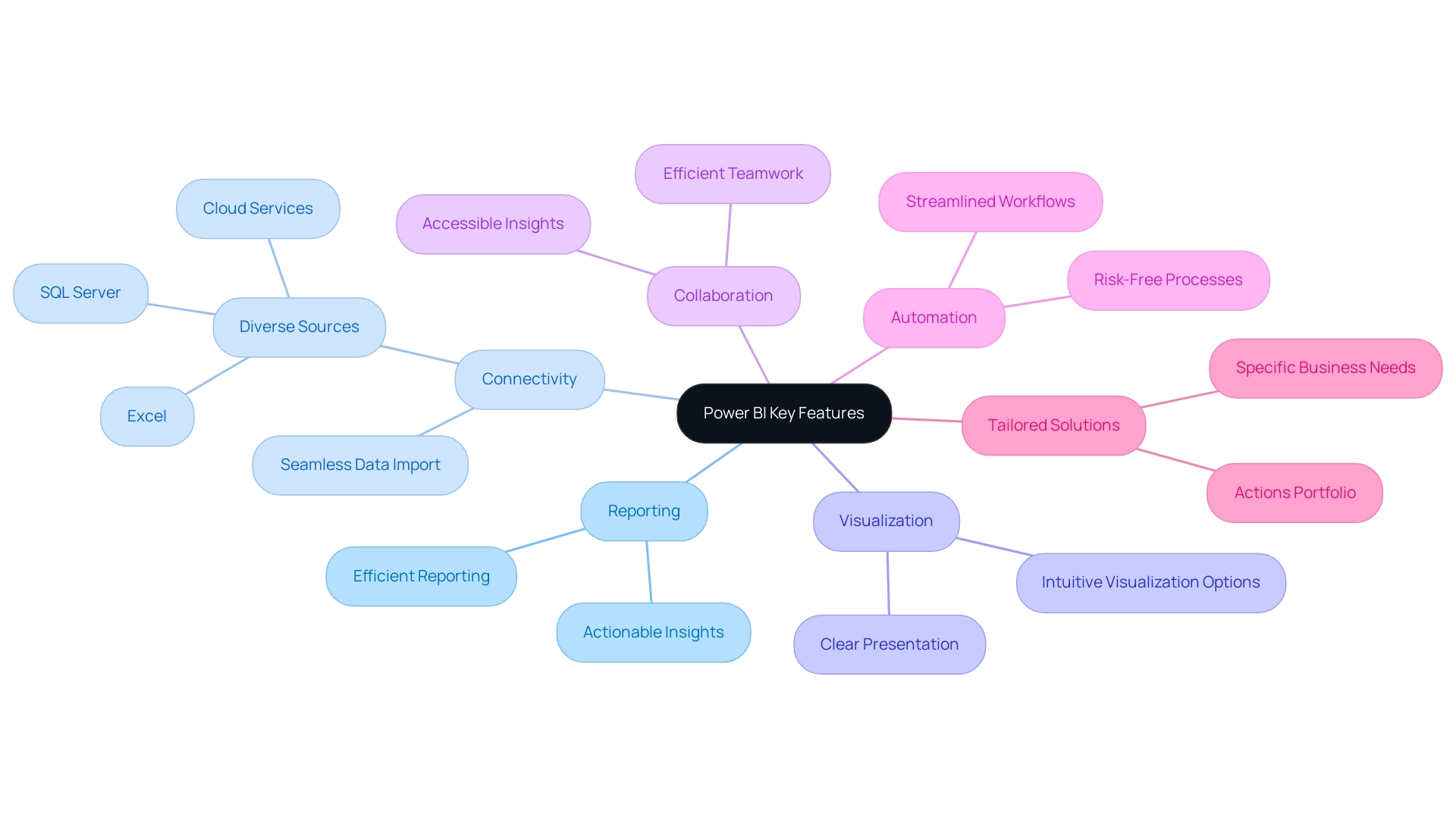
Real-World Applications of Power BI
The power business intelligence course has emerged as a transformative tool across multiple industries, adeptly addressing specific business challenges. In the retail sector, companies utilize BI to conduct thorough analysis of sales information and oversee inventory levels, thereby facilitating informed decision-making concerning stock management and aligning offerings with customer preferences. However, many organizations face challenges such as investing excessive time in creating documents rather than leveraging insights from the power business intelligence course.
For example, the execution of an Order Summary Document enables real-time inventory monitoring and order rate calculation, improving inventory and order management while occasionally causing discrepancies in information across different documents due to an absence of governance strategy. Here, Robotic Process Automation (RPA) can streamline the report creation process, reducing the manual effort involved and allowing teams to focus on analysis instead of data gathering. In finance, organizations utilize BI to streamline financial reporting and forecasting processes, effectively visualizing trends and performance metrics.
As Naba Ijaz aptly notes,
This BI offers businesses an all-encompassing solution to navigate financial reporting challenges.
Developing a cash flow statement in BI involves organizing information with transaction details and ensuring proper relationships for accurate cash flow analysis, which is essential for effective financial oversight. Furthermore, BI’s advanced analytics capabilities make it a top choice for a power business intelligence course, enabling C-suite executives to leverage data-driven insights for strategic decision-making in financial reporting.
The healthcare industry also utilizes BI to track patient information and enhance operational efficiency, ultimately resulting in improved patient outcomes and resource distribution. The real-world applications highlight BI’s versatility and its crucial role in driving business success across various industries, while also emphasizing the importance of overcoming the common challenges faced in report creation and data governance. Tailored AI solutions further enhance these efforts by providing entities with specific tools to navigate the rapidly evolving technology landscape.
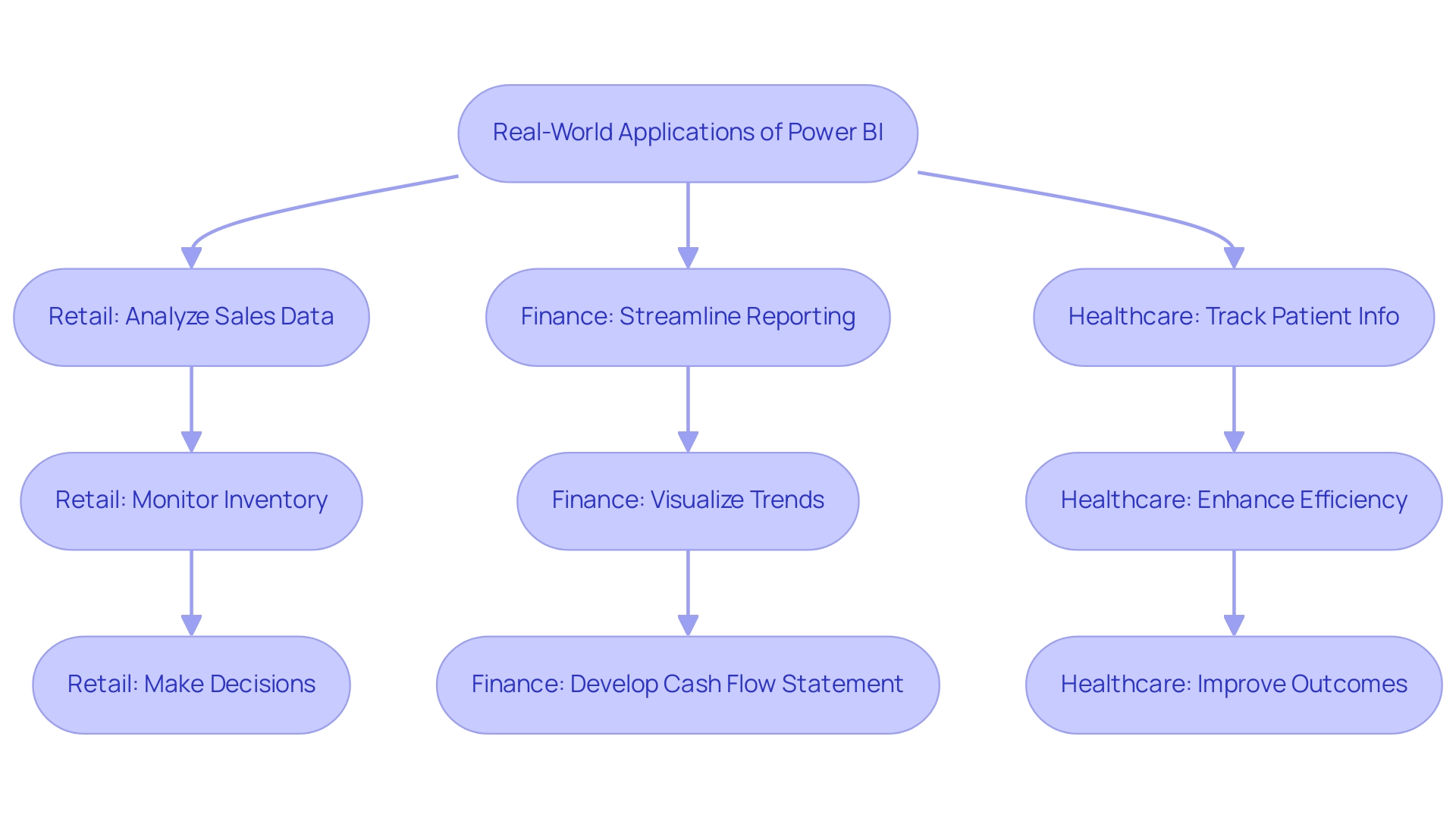
Future Trends in Business Intelligence and Power BI
The landscape of business intelligence is undergoing a significant transformation, particularly with the increasing integration of artificial intelligence (AI) and machine learning within tools like the power business intelligence course. However, many entities face challenges in adopting AI due to perceptions of complexity, cost, and integration issues, including the common belief that AI projects are time-intensive and costly. Addressing these challenges is crucial for enhancing operational efficiency.
For instance, our customized Small Language Models (SLMs) provide powerful capabilities for efficient information analysis, ensuring better privacy and cost-effectiveness. These models can assist entities in overcoming the obstacles presented by inadequate master information quality, which frequently results in ineffective operations and erroneous decision-making.
The power business intelligence course incorporates the integration of Azure Machine Learning within Power BI, offering access to a broad range of machine learning models and algorithms, enabling precise forecasts and predictions crucial for efficient operational planning. As entities grapple with the overwhelming AI landscape, leveraging solutions like SLMs can streamline the process and make AI technology more accessible. It is also essential for entities to comprehend where to begin with AI integration to ease their uncertainties.
Selecting between Machine Learning and Generative AI relies on the problem statement, information structure, and ethical considerations, making it vital for professionals to grasp these distinctions when implementing AI solutions. Furthermore, Bi’s anomaly detection capability enables report creators to automatically recognize irregularities in time series information, providing clear explanations and root cause analyses for detected anomalies, thereby improving the reliability of insights driven by information.
In addition, the trend towards self-service BI is democratizing access to information, permitting non-technical users to create their own reports and dashboards without excessive dependence on IT departments. This shift not only accelerates data-driven decision-making but also fosters a culture of empowerment across teams. As organizations increasingly prioritize information governance and security, the protection of sensitive information becomes paramount, ensuring compliance with ever-evolving regulations.
Staying informed about these emerging trends is crucial for professionals aiming to maximize the potential of Business Intelligence and maintain a competitive edge in their respective industries. The case study on forecasting with AI in the power business intelligence course exemplifies how machine learning algorithms improve the accuracy of forecasts, enabling more effective operational planning through the analysis of time-series and cross-sourced information. As Pierre Pinna aptly states,
The most important thing about AI is not the AI, no, the most important thing is the information!
This highlights the foundational role of data in harnessing the full capabilities of AI and machine learning in business intelligence.
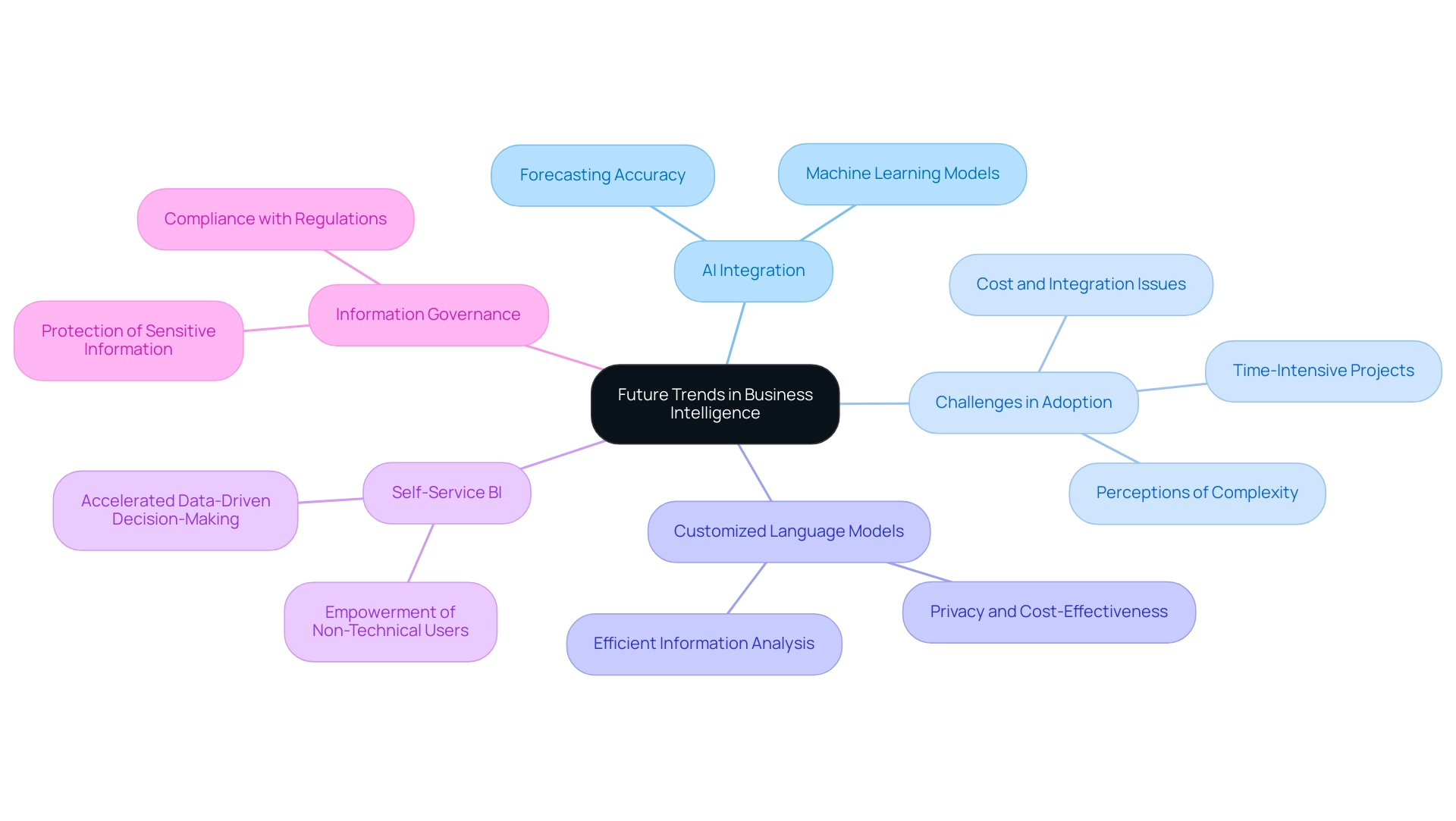
Conclusion
Mastering Power Business Intelligence (BI) through dedicated training courses offers professionals a unique opportunity to transform raw data into impactful insights that drive informed decision-making. By acquiring essential skills in data modeling, reporting, and the use of Microsoft Power BI, individuals are well-equipped to tackle common challenges such as inefficient report creation and data inconsistencies. As organizations increasingly rely on data to enhance operational efficiency, the ability to streamline reporting processes becomes paramount.
The benefits of Power BI training extend beyond technical skills; they foster a culture of data-driven decision-making and innovation within organizations. By leveraging the powerful features of Power BI, including seamless data connectivity and intuitive visualization options, professionals can present data in ways that resonate with stakeholders and enhance collaboration across teams. This not only accelerates the decision-making process but also empowers organizations to harness the full potential of their data, ultimately driving competitive advantage.
Looking ahead, the integration of AI and machine learning into Power BI presents exciting opportunities for further enhancing data analysis and operational efficiency. As organizations navigate the complexities of these technologies, embracing tailored solutions can mitigate common adoption challenges. By staying informed about emerging trends and focusing on data governance, businesses can ensure they are prepared to leverage the full capabilities of Power BI, positioning themselves for success in an increasingly data-centric landscape.
The journey toward informed, agile decision-making begins with mastering these tools, enabling organizations to thrive in today’s fast-paced environment.
